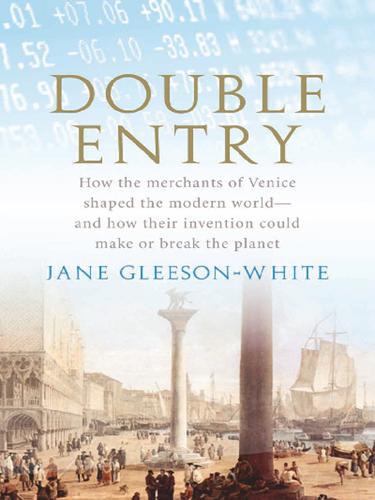
Double Entry: How the Merchants of Venice Shaped the Modern World - and How Their Invention Could Make or Break the Planet
by
Jane Gleeson-White
Published 14 May 2011
In six pages Sombart set out his belief that the emergence of capitalism and the appearance of double-entry bookkeeping in the thirteenth century are causally related. He wrote: ‘It is simply impossible to imagine capitalism without double-entry bookkeeping; they are like form and content.’ In Sombart’s view, capitalism and double entry are so intimately connected it is difficult to tell which was cause and which effect: ‘one may indeed doubt whether capitalism has procured in double-entry book-keeping a tool which activates its forces, or whether double-entry book-keeping has first given rise to capitalism out of its own spirit.’ Sombart defines capitalism as a particular economic system, recognisable as an organisation of trade, consisting invariably of two collaborating sections of the population, the owners of the means of production, who also manage them, and property-less workers, bound to the markets which they serve; which displays the two dominant principles of wealth creation and economic rationalism.
…
This book underwent a third transformation when I began to investigate the possibility that the system of national accounting first theorised by one of my economist heroes, John Maynard Keynes, might somehow be related to Pacioli’s Venetian bookkeeping. I discovered that the very same double-entry bookkeeping principles used by the merchants of Venice had been used to construct the national accounts of the United States and Great Britain during the Great Depression and the Second World War. And so this book became the story of double-entry bookkeeping itself, from its first known origins in late thirteenth-century Italy to its takeover of the twenty-first-century global economy. The rise and metamorphosis of double-entry bookkeeping is one of history’s best-kept secrets and most important untold tales.
…
And so, the story goes, the Florentine record-keepers developed a style of account-keeping which allowed them to classify, record and cross-check their accounts—and, most importantly, to calculate their profits, which allowed them to see not just what they owned but also how well their business was doing. This new form of business recording was double-entry bookkeeping. It is also possible, however, given the timing, that the new mathematics and double-entry bookkeeping evolved together in Asia as part of a coherent commercial system developed by the Hindus or Arabs, or both. Research into the possible Islamic or Hindu origins of double-entry bookkeeping has found suggestive but no conclusive evidence. Some researchers have traced the new bookkeeping to Fibonacci’s Liber abaci and to the Islamic universities of Muslim Spain.
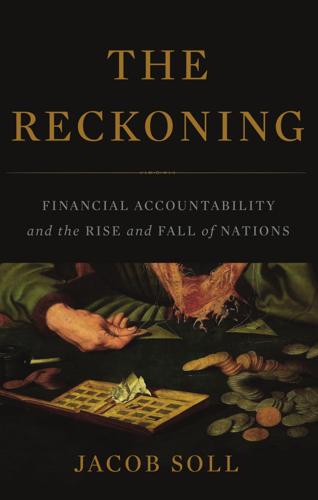
The Reckoning: Financial Accountability and the Rise and Fall of Nations
by
Jacob Soll
Published 28 Apr 2014
Leech (London: Routledge, 2001), 217. 5. Pacioli’s text is reproduced in John B. Geijsbeek, Ancient Double-Entry Bookkeeping: Luca Pacioli’s Treatise 1494 (Denver, 1914), 33. 6. Ibid., 39. 7. Ibid.; Brown, A History of Accounting and Accountants, 40, 111. 8. Grendler, Schooling in Renaissance Italy, 321. 9. Pacioli citations from Geijsbeek, Ancient Double-Entry Bookkeeping, 27, 37. 10. Ibid., 41, 51–53. 11. Ibid., 41, 75. 12. Bruce G. Carruthers and Wendy Nelson Espeland, “Accounting for Rationality: Double-Entry Bookkeeping and the Rhetoric of Economic Rationality,” American Journal of Sociology 97, no. 1 (1991): 30–67; Mary Poovey, A History of the Modern Fact: Problems of Knowledge in the Sciences of Wealth and Society (Chicago: University of Chicago Press, 1998), 31. 13.
…
They taught applied mathematics and other subjects, such as the alphabet, prose instruction, and the catechism.25 The medieval Italian merchants did what the ancient Greeks, Persians, and Romans, the great Asian kingdoms, and the feudal lords could not: Without fanfare or public recognition, they invented double-entry bookkeeping, making the revolutionary leap into the calculation of profit. The only explanation for this is that Italian merchants needed double entry to calculate multipartner firms, equity and profits, and so, in a demand-response process, they developed it. Although we do not know for sure who first did it, Tuscan merchants began developing double-entry bookkeeping. The records are of some debate, but the earliest recognized use of double entry appears in the documents of the ledgers of either the Rinieri Fini brother firm (1296), which traded in fairs across Europe, or the Farolfi merchant house (1299–1300), which traded between Florence and Provence.
…
He ignored the noble Neo-Platonic warnings of Pico della Mirandola and mixed high learning with the merchant arts. That a prince and a lowborn (indeed, bastard) engineer would meet at a university and become friends was already a European anomaly. That Stevin would teach the prince double-entry bookkeeping was another.14 Stevin excelled in linguistics, cosmography, perspective, algebra, the study of decimal fractions, the theory of numbers, physics, navigation, and astronomy. He also made a careful study of double-entry bookkeeping. Stevin was a civic humanist whose achievements far surpassed those of Pacioli. His learning had practical applications, especially in the management of water, and he was given the most sensitive positions in civil administration.
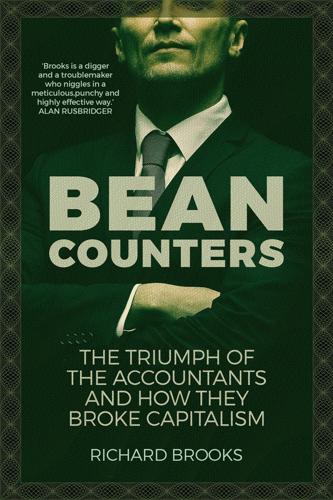
Bean Counters: The Triumph of the Accountants and How They Broke Capitalism
by
Richard Brooks
Published 23 Apr 2018
Some early-twentieth-century thinkers went so far as to ascribe the rise of capitalism itself to double-entry bookkeeping. When he coined the term ‘Protestant work ethic’ in 1904, the German philosopher Max Weber also wrote: ‘The most generous presupposition for the existence of this present-day capitalism is that of rational capital accounting as the norm for all large industrial undertakings which are concerned with the provision of everyday wants.’3 The ‘capital accounting’ to which he referred was in fact the double-entry bookkeeping system, which introduced the concept of ‘capital’ as the measure of an owner’s interest in an enterprise (centuries before Karl Marx expounded his theory in Das Kapital in 1867).
…
The era of measurement ushered in by Fibonacci transformed medieval northern Italy. It laid the foundations, sometimes literally, for Renaissance art and architecture. But nowhere were the new methods to prove more revolutionary than in commerce, where they made possible an ingenious new way of accounting called double-entry bookkeeping.4 As economist Werner Sombart would later write of the method’s origins: ‘Double-entry bookkeeping was born out of the same spirits as the systems of Galileo and Newton, as the theories of modern physics and chemistry’; it ‘discloses to us the cosmos of the economic world’.5 First used by Florentine merchants at the end of the thirteenth century, the system allows not just for the recording of a transaction; it simultaneously registers its financial consequences and thus automatically keeps a tab on the things that matter: sales and purchases, debtors and creditors, and so on.
…
As his biographer noted, he ‘was preoccupied by the thought that his very skill in making profit was sin’.7 From around 1380, Datini operated a full double-entry bookkeeping system. The main account books, the libri grande that consolidated the contemporaneous notes of his transactions into double-entry accounts, explain his diligence. Each carried one of two headings: ‘In the Name of the Holy Trinity and of all the Saints and Angels of Paradise’, or sometimes simply ‘In the Name of God and Profit’.8 For the merchants and their bankers seeking wealth and piety, double-entry bookkeeping offered security and a certain salvation. But, one family was to discover, only if it was done properly.
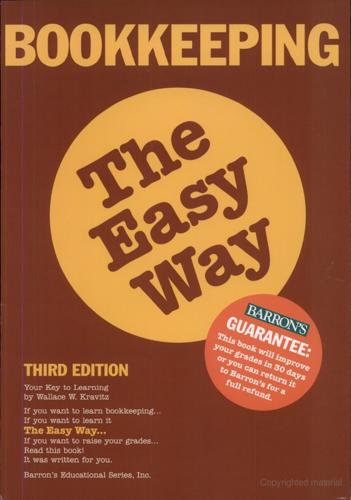
Bookkeeping the Easy Way
by
Wallace W. Kravitz
Published 30 Apr 1990
A partial ledger for the accounts involved and the debits and credits for (1), (2), (3), and (4) above is shown as follows: Cash 1450 (3) 1000 (1) 2500 (4) 100 (2) 5000 Island National Bank (3) 1000 6200 (1) 2500 Supplies 645 (4) 100 Thomas Morales, Capital 14720 (2) 5000 Notice that each numbered transaction identifies a debit and a credit of equal amount. This is helpful in order to follow the system of double-entry bookkeeping. For every transaction, debits must equal credits. YOU SHOULD REMEMBER In every transaction debits equal credits. Assets increase by debits and decrease by credits. Liabilities increase by credits and decrease by debits. Owner's equity increases by credits and decreases by debits. Know Your Vocabulary Use each of the following words or terms in a statement relating to bookkeeping/accounting: Account form Balance Credit (cr.) Debit (dr.) Double-entry bookkeeping Ledger Rules of debits and credits T-account Questions 1.
…
It found that 70 percent of successful owners understood bookkeeping procedures, while only 10 percent of failed business owners shared that understanding. This indicates that a knowledge of the fundamentals of bookkeeping is essential to the success of small businesses. Understanding basic bookkeeping procedures is vital to developing an understanding of more advanced accounting theory and practice. Therefore, mastering the concepts of double-entry bookkeeping is a prerequisite to any further study. This text is designed to be used in a variety of ways, depending on the need of the learner. (1) Those who wish to study independently, at their own pace, will find this presentation clear and concise, without distractions. (2) Those enrolled in adult education or continuing education courses will find that this text is designed for a relaxed, successful learning experience. (3) Those who wish to study this subject in a one-semester course will find this work ideally arranged to coincide with most school half-year time schedules. (4) Those who are having difficulty in grasping the fundamentals in a traditional introductory course in bookkeeping or accounting will find the text ideal for review or for remedial study.
…
< previous page page_21 next page > < previous page page_23 next page > Page 23 Chapter 4 The Ledger WORDS TO REMEMBER Account Form the arrangement of each item in a ledger; debits entered on the left side and credits entered on the right side Balance the value of an account at any given time, as at the end of a fiscal period Credit (cr.) entries on the right side of any account Debit (dr.) entries on the left side of any account Ledger all accounts, taken together as a group, for the same individual or business Double-Entry Bookkeeping a method of bookkeeping in which, for every transaction, the amounts debited must equal the amounts credited (Debits = Credits) T-Account an accountant's device, in the form of a large "T," used to analyze debit and credit entries for each transaction It is possible to record the changes each transaction causes by continually preparing new balance sheets.
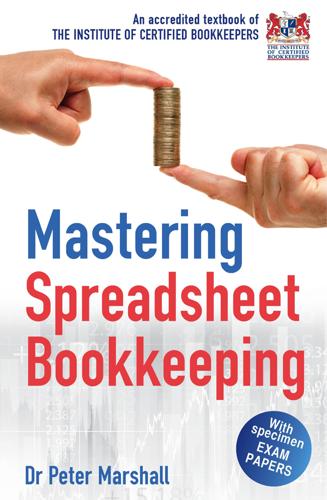
Mastering Spreadsheet Bookkeeping
by
Peter Marshall
Published 16 Apr 2014
These require that the personal data shall: • be obtained only for specified and lawful purposes and must not be used in any manner incompatible with such purposes; • be relevant and adequate but not excessive for the purpose for which it has been collected; • be accurate and kept up to date; • not be kept for any longer than necessary for the purpose for which it was collected; • only be processed in accordance with the subject’s rights under the Act; • be protected by appropriate organizational and technical measures against unauthorized and unlawful use, or accidental loss or damage; • not be taken outside of the country to any country where there is not adequate legal protection of the rights and freedom of data subjects in respect of the processing of their personal data. In most businesses today, accounting information will be used for non-accounting purposes, so it is very likely that anyone who controls such data will need to register and comply with the Act. 4 Double entry bookkeeping Let’s just remind ourselves of the essential principle of double entry bookkeeping because we have to keep this in mind as we construct and use our spreadsheet system. Debit and credit Transactions have two sides, a debt and a credit. When a firm sells goods to a customer a debit entry is made in that customer’s ledger account because they have become our debtor (for the sake of simplicity, in this example we’ll assume the sale was VAT exempt).
…
Figure 2 An MS Excel spreadsheet page Figure 3 The control section of an Excel page known as the ribbon 5 Configuring spreadsheets within the traditional daybook format This chapter contains guidance for those who are already knowledgeable and skilled in double entry bookkeeping, but not in the use of spreadsheets for the purpose. Chapters 8 to 50 give more comprehensive guidance on the whole subject of double entry bookkeeping and spreadsheet use. Nowadays, we can use the electronic pages of a spreadsheet program to keep the books of a business. This has great advantages. If you want to stick to the configuration of your manual system, but simply make your work quicker and simpler, then you can simply reconstruct daybook and ledger pages on a spreadsheet to look like the manual versions, and add code and formulae to make the pages sum and balance themselves.
…
A copy of the British Library Cataloguing in Publication Data is available from the British Library ISBN 978-1-84528-501-2 (paperback) ISBN 978-1-84528-556-2 (ebook) Printed and bound in the UK 1 3 5 7 9 10 8 6 4 2 Cover by Simon Levy Contents List of figures Preface Acknowledgements PART ONE An Introduction to Spreadsheet Bookkeeping 1 A period of transition 2 The role and significance of professional associations 3 Data security and the Data Protection Act 1998 4 Double entry bookkeeping 5 Configuring spreadsheets within the traditional daybook format 6 Speeding up traditional ledger posting 7 Depreciation calculations PART TWO Basic Spreadsheet Bookkeeping 8 Recording daily transactions: books of prime entry 9 The purchase daybook 10 The purchase returns daybook 11 The sales daybook 12 The sales returns daybook 13 The cash book 14 Setting up your spreadsheet for recording money paid in 15 The cash book: recording money paid in, step by step 16 The cash book: recording money paid out, step by step 17 Disagreeing with the bank 18 The bank reconciliation 19 The petty cash book 20 The journal 21 The ledger 22 Posting to the ledger from the daybook 23 Posting to the ledger from the cash book 24 Balancing the ledger 25 Discounts 26 Control accounts 27 Preparing control accounts, step by step 28 The trial balance 29 How to extract a trial balance 30 The trial balance: errors 31 Accruals and prepayments 32 Revenue accounts 33 Stock in the final accounts 34 How to compile revenue accounts 35 Configuring a spreadsheet for revenue accounts, step by step 36 Compiling a spreadsheet for revenue accounts, step by step 37 The balance sheet 38 Compiling a balance sheet, step by step 39 Manufacturing accounts 40 Compiling a manufacturing account, step by step 41 Depreciation: the straight line method 42 Depreciation: the diminishing balance method 43 Depreciation, step by step 44 Accounting for bad and doubtful debts 45 Accounting for bad and doubtful debts, step by step 46 Partnerships: appropriation accounts 47 Partnership accounts, step by step 48 Amalgamating sole proprietorships into a partnership 49 How to consolidate two balance sheets 50 Limited companies 51 Format of company accounts PART THREE Advanced Spreadsheet Bookkeeping 52 Fully automated spreadsheet bookkeeping 53 Opening balances spreadsheet 54 Incomings analysis sheet 55 Outgoings analysis sheet 56 Annual incomings summary 57 Annual outgoings summary 58 Automatic completion of the VAT return 59 Compiling the assets summary 60 Compiling the liabilities summary 61 The trial balance 62 The profit and loss account 63 The balance sheet 64 Adding additional columns to the incomings and outgoings analysis sheets 65 Creating an index to the accounts 66 Protecting your spreadsheets PART FOUR Examination Papers, Answers and Associated Material Further Resources Index List of figures 1 www.bookkeepers.org.uk homepage 2 An MS Excel spreadsheet page 3 The control section of an Excel page known as the ribbon 4 Example of a traditional purchase daybook page written up on a spreadsheet 5 Traditional purchase daybook spreadsheet (Figure 4) with the formulae revealed 6 Example of a traditional sales daybook page written up on a spreadsheet 7 Traditional sales daybook spreadsheet (Figure 6) with the formulae revealed 8 Example of a traditional cash book page written up on a spreadsheet 9 Traditional cash book spreadsheet (Figure 8) with the formulae revealed 10 Example of a traditional petty cash book page written up on a spreadsheet 11 Traditional petty cash book spreadsheet (Figure 10) with the formulae revealed 12 Example of a traditional nominal ledger page written up on a spreadsheet 13 Traditional nominal ledger page spreadsheet (Figure 12) with the formulae revealed 14 Spreadsheet configured for journal 15 Extract from A.
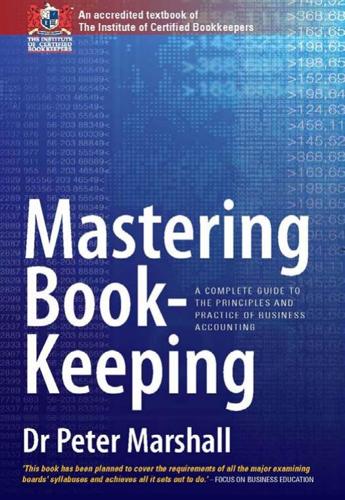
Mastering Book-Keeping: A Complete Guide to the Principles and Practice of Business Accounting
by
Peter Marshall
Published 1 Feb 1997
The laws and regulations are complex and liable to change, and readers should check the current position with the relevant authorities before making personal arrangements. Contents Preface 1 A period of transition 2 The role and significance of the professional association 3 Data security and the Data Protection Act 1998 4 The flow of documents and processes 5 What is double entry book-keeping? 6 Opening the books of account 7 The day books 8 The purchase day book 9 The purchase returns day book 10 The sales day book 11 The sales returns day book 12 The cash book 13 The cash book: money paid in 14 The cash book: money paid out 15 Disagreeing with the bank 16 The bank reconciliation 17 The petty cash book 18 How to write up the petty cash book 19 The journal 20 How to write up the journal 21 The postage book 22 The ledger 23 Posting to the ledger from the day books 24 Posting to the ledger from the cash book 25 Balancing the ledger 26 Discounts 27 Control accounts 28 Preparing control accounts step by step 29 The trial balance v ix 1 2 3 4 9 11 13 17 19 21 23 25 27 29 31 33 41 43 47 49 51 53 57 59 61 65 69 73 75 Contents 30 31 32 33 34 35 36 37 38 39 40 41 42 43 44 45 46 47 48 49 50 51 52 53 54 55 56 57 58 59 60 61 62 63 64 65 How to extract a trial balance The trial balance: errors Accruals and prepayments Revenue accounts Stock in the final accounts How to compile revenue accounts Compiling revenue accounts step by step The balance sheet Compiling a balance sheet step by step Manufacturing accounts Compiling a manufacturing account step by step Depreciation: the straight line method Depreciation: the diminishing balance method Other methods of depreciation Depreciation step by step Accounting for bad and doubtful debts Accounting for bad and doubtful debts step by step Partnership accounts Partnerships: appropriation accounts Partnership accounts step by step Amalgamating sole proprietorships into a partnership How to consolidate two balance sheets Limited companies Limited companies’ books and accounts Format of company accounts Revenue accounts of limited companies Balance sheets of limited companies Going limited Going limited: worked example Club accounts Club accounts: income and expenditure Fixed asset register Asset disposals Asset disposals step by step Correction of errors Correcting errors step by step vi 77 81 83 87 89 91 93 95 99 101 103 105 107 108 111 113 115 116 117 119 121 123 130 133 135 137 145 149 150 151 153 161 163 165 167 169 Contents 66 67 68 69 70 71 72 73 74 75 76 77 78 79 Value Added Tax Accounting for VAT Incomplete records Capital comparison method step by step Bank account analysis step by step Interpreting accounts Interpreting accounts: example Wages: basic principles Coin analysis and wages book Stock records and valuation Encountering deviations from standard methods Using spreadsheet pages New developments in electronic book-keeping More advanced accounting 173 179 186 189 193 197 201 203 205 207 211 213 217 221 Sample examination papers – Level I Model answers – Level I Sample examination papers – Level II Model answers – Level II Sample examination papers – Level III Model answers – Level III More sample examination papers 229 241 248 257 266 275 284 Glossary 316 Index 321 vii This page intentionally left blank Preface This book was inspired as much by educational science as by book-keeping.
…
The roles are just reversed. 7 CUSTOMER Requests quotation SUPPLIER Requests estimate Produces quotation Produces estimate Purchase order Delivery note Signed by customer after checking goods Stock records updated Goods taken from stock and delivered Invoice produced Entry in purchase day book Posting to supplier a/c bought ledger Posting to VAT a/c nominal ledger Entry in sales day book Posting to sales a/c nominal ledger Posting to purchases a/c nominal ledger Posting to VAT a/c nominal ledger Posting to customer a/c bought ledger Production of statement Cashier receives statement and issues cheque Cashier receives cheque and enters in cashbook Fig. 2. An illustration of the flow of documents and the processes which each triggers in a transaction between two businesses. 8 5 What is double entry book-keeping? Debit and credit All transactions have two sides, a debit and a credit. When a firm sells a TV and sends a bill for payment, for example, on the one hand it has made a sale (which is a credit entry). On the other hand it has gained a liability from the customer (debit entry). That customer is liable to the firm for the money.
…
The need for two records Both these transactions need recording separately, because we need: . a total of sales figures for tax computation and management purposes (to make sure the business is working to plan) . a cumulative total of money owed by each customer. A check of accuracy There is another important advantage of double entry book-keeping. If both sides of each transaction have been recorded then, at any time, if the sums have been done correctly the debit entries will equal the credit entries. It provides a check of accuracy. An example is as follows: Example Suppose A. T. Office Supplies made the following transactions: Purchased 6 tables for £60.00 from seller A Purchased 10 chairs for £40.00 from seller B Sold 1 table for £15.00 to customer A Sold 1 chair for £24.00 to customer B Received cheque for £15.00 from customer A Paid cheque for £60.00 to seller A The entries would be: DEBIT Purchases Purchases Customer A Customer B Bank Seller A £ 60.00 40.00 15.00 24.00 15.00 60.00 214.00 9 CREDIT Seller A Seller B Sales £ Customer A Bank 15.00 60.00 214.00 60.00 40.00 39.00 JOURNAL Date 200X Jan 1 Particulars Dr.

The Truth Machine: The Blockchain and the Future of Everything
by
Paul Vigna
and
Michael J. Casey
Published 27 Feb 2018
“It is not possible for a human to know whether Bank of America made money or lost money last quarter.” A bank’s balance sheet, he said, is essentially a series of “reasonable guesses about valuation.” Make the wrong guesses, as Lehman and other troubled banks did, and you end up out of business. Our goal here is not to trash double-entry bookkeeping or the banks. Were we to, you know, add up all the debits and credits, double-entry bookkeeping has done more good than harm. The goal really is to show the deep historical and cultural roots behind why we trusted this kind of accounting. The question now, in the wake of our fall, is whether a particular technology that allows a different kind of bookkeeping will help us renew our trust in our economic system.
…
Once human beings started to engage in exchanges of money across distances, tokens’ capacity to play this record-keeping function broke down. There was no way for the payer to physically deliver the tokens to the payee without having to trust a courier who might well steal it. The solution came with the advent of a new form of ledger-keeping known as double-entry bookkeeping, an approach that was pioneered, as we’ll discuss lower down, by a clique of Renaissance bankers. In adopting this bookkeeping, they thrust banking into the payments business and, for centuries, helped to greatly expand the capacity for human exchange. It’s not an overstatement to say that this idea of banking built the modern world.
…
Fibonacci’s math gave them precision in business matters that people did not previously have. Fibonacci’s new numbering system became a hit with the merchant class and for centuries was the preeminent source for mathematical knowledge in Europe. But something equally important also happened around this time: Europeans learned of double-entry bookkeeping, picking it up from the Arabians, who’d been using it since the seventh century. Merchants in Florence and other Italian cities began applying these new accounting measures to their daily businesses. Where Fibonacci gave them new measurement methods for business, double-entry accounting gave them a way to record it all.
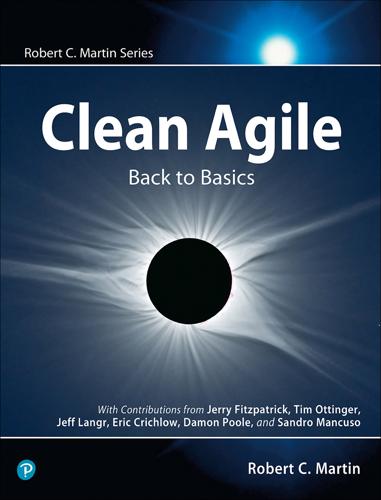
Clean Agile: Back to Basics
by
Robert C. Martin
Published 13 Oct 2019
How do accountants ensure that every symbol is correct? Double-Entry Bookkeeping Accountants have a discipline that was invented 1000 years ago. It’s called double-entry bookkeeping.1 Every transaction they enter into their books is entered twice: once as a credit in one set of accounts, and again as a complementary debit in another set of accounts. These accounts eventually flow into a single document called the balance sheet, which subtracts the sum of liabilities and equities from the sum of assets. That difference must be zero. If it is not zero, then an error has been made.2 1. https://en.wikipedia.org/wiki/Double-entry_bookkeeping_system 2.
…
Continuous Technical Readiness Stable Productivity Inexpensive Adaptability Continuous Improvement Fearless Competence QA Should Find Nothing Test Automation We Cover for Each Other Honest Estimates You Need to Say “No” Continuous Aggressive Learning Mentoring The Bill of Rights Customer Bill of Rights Developer Bill of Rights Customers Developers Conclusion Chapter 3 Business Practices Planning Trivariate Analysis Stories and Points ATM Stories Stories Story Estimation Managing the Iteration The Demo Velocity Small Releases A Brief History of Source Code Control Tapes Disks and SCCS Subversion Git and Tests Acceptance Tests Tools and Methodologies Behavior-Driven Development The Practice Whole Team Co-Location Conclusion Chapter 4 Team Practices Metaphor Domain-Driven Design Sustainable Pace Overtime Marathon Dedication Sleep Collective Ownership The X Files Continuous Integration Then Came Continuous Build The Continuous Build Discipline Standup Meetings Pigs and Chickens? Shout-out Conclusion Chapter 5 Technical Practices Test-Driven Development Double-Entry Bookkeeping The Three Rules of TDD Debugging Documentation Fun Completeness Design Courage Refactoring Red/Green/Refactor Bigger Refactorings Simple Design Design Weight Pair Programming What Is Pairing? Why Pair? Pairing as Code Review What about the Cost? Just Two? Management Conclusion Chapter 6 Becoming Agile Agile Values Courage Communication Feedback Simplicity The Menagerie Transformation The Subterfuge The Lion Cubs Weeping Moral Faking It Success in Smaller Organizations Individual Success and Migration Creating Agile Organizations Coaching Scrum Masters Certification Real Certification Agile in the Large Agile Tools Software Tools What Makes for an Effective Tool?
…
Programmers who learn TDD are taught to enter every behavior one at a time—once as a failing test, and then again as production code that passes the test. This allows them to catch errors quickly. They are taught to avoid writing a lot of production code and then adding a batch of tests, since errors would then be hard to find. These two disciplines, double-entry bookkeeping and TDD, are equivalent. They both serve the same function: to prevent errors in critically important documents where every symbol must be correct. Despite how essential programming has become to our society, we have not yet imbued TDD with the force of law. But given that lives and fortunes have already been lost to the vagaries of poorly written software, can that law be far away?

A Place for Everything: The Curious History of Alphabetical Order
by
Judith Flanders
Published 6 Feb 2020
Arks are mere wooden boxes to hold books and documents, and yet as such they symbolize the wisdom of the ages, of God’s promise for humanity.12 Bill Gates once identified the development of the transistor in 1947 as ‘a key transitional event in the advent of the information age’. Other key moments, according to historians, include the invention of writing, of double-entry bookkeeping, printing, the telegraph and the computer. What is notable in this list is that none of these are inventions that created new knowledge themselves, but are instead inventions that created new ways of accessing knowledge. It was not the machines – not the telegraph, not the printing-press, nor even the computer – that revolutionized the world, but the processes behind those machines: they were the software to the hardware of the printing-press or the telegraph or the computer.
…
As trade increased, however, and as businesses became more complex, crossing borders and engaging with a multitude of partners and currencies, so the need arose for a system where assets were no longer recorded indiscriminately alongside liabilities, where suppliers were distinguished from customers and, importantly, where a single client, shipment or purchase could be located with ease. The solution was double-entry bookkeeping, a method whereby each transaction is entered at least twice, as a credit or as a debit, in separate columns which must, at the end of the day, reconcile. By the early fourteenth century some northern Italian merchants, many of them trading in the southern reaches of France, were independently feeling their way to this possibility.
…
In 1494, Luca Pacioli, tutor to the children of a Venetian merchant (and later mathematical teacher, and collaborator with Leonardo da Vinci), published a textbook on mathematics and geometry that included a chapter entitled De computis et scripturis, On Computation and Writing, describing double-entry bookkeeping as it was practised at that period. Within a few years the chapter was published separately as an instructional pamphlet, translated into English, German, French and Dutch. As late as the nineteenth century, Russian and American editions were still commercially viable. Pacioli’s system was laborious but straightforward: the merchant was to begin by inventorying his business, listing all of its assets, whether merchandise, cash currently on hand or already expended; then he was to list all his debts.
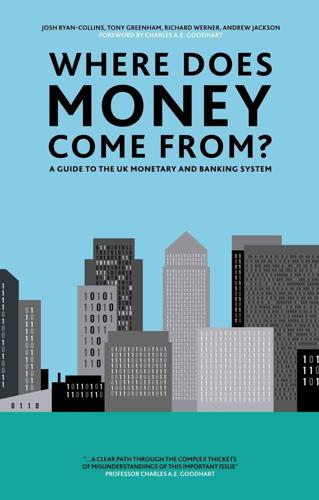
Where Does Money Come From?: A Guide to the UK Monetary & Banking System
by
Josh Ryan-Collins
,
Tony Greenham
,
Richard Werner
and
Andrew Jackson
Published 14 Apr 2012
The numbers that the bank typed into Robert’s account can be used to make payments, and therefore function as money. The process of creating commercial bank money – the money that the general public use – is as simple as a customer signing a loan contract, and the bank typing numbers into a new account set up for that customer. Box 5: Double-entry bookkeeping and T-accounts A double-entry bookkeeping system is a set of rules for recording financial information where every transaction changes at least two different ledger accounts. The name derives from the fact that financial information used to be recorded in books – hence ‘bookkeeping’ (whereas now it is recorded mainly in computer systems).
…
On Us, with and without risk A3.3.5. Other payment versus payment settlement methods Index LIST OF EXPLANATORY BOXES Box 1: Retail, commercial, wholesale and investment bank Box 2: Building societies, credit unions and money creation Box 3: Bonds, securities and gilts Box 4: Wholesale money markets Box 5: Double-entry bookkeeping and T-accounts Box 6: Money as information – electronic money in the Bank of England Box 7: What is LIBOR and how does it relate to the Bank of England policy rate? Box 8: Seigniorage, cash and bank’s ‘special profits’ Box 9: Real time gross settlement (RTGS) Box 10: If banks can create money, how do they go bust?
…
Upon signing, Barclays records it as an asset on its balance sheet (T-chart 1): T-chart 1: Loan by Barclays Bank Barclays Bank Balance Sheet (Step 1) Assets Liabilities (What the borrowers owe to bank + bank’s money) (What the bank owes to the depositers + bank’s net worth) Loan to Robert £10,000 Of course, double entry bookkeeping (Box 5) requires an equal and opposite accounting entry, and besides, Robert now wishes to get access to the money. So Barclays creates a new bank account for him, and gives it a balance of £10,000. This account is a liability of the bank to Robert, so it is recorded on the liabilities side of Barclays’ balance sheet (T-chart 2): T-chart 2: Bank simultaneously creates a loan (asset) and a deposit (liability) Barclays Bank Balance Sheet (Step 2) Assets Liabilities (What the borrowers owe to bank + bank’s money) (What the bank owes to the depositers + bank’s net worth) Loan to Robert £10,000 Robert’s new account £10,000 Note that the bank has expanded its balance sheet and all it has done is added some numbers to a record in a computer database, recording that it has a liability to Robert and also an asset in the form of Robert’s agreement to repay his loan.
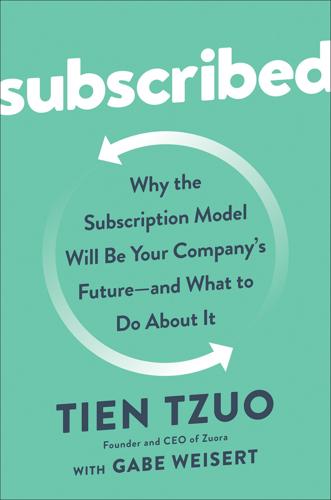
Subscribed: Why the Subscription Model Will Be Your Company's Future - and What to Do About It
by
Tien Tzuo
and
Gabe Weisert
Published 4 Jun 2018
Let’s go back around five hundred years. Let’s visit Venice. LUCA PACIOLI AND THE WORLD OF DOUBLE-ENTRY BOOKKEEPING Our whole financial system today—our ability to generate financial statements, create “books” that can be audited, and compare companies against one another—rests on a concept called double-entry bookkeeping. The basic premise is that your credits have to match your debits. Every time somebody in a grocery store checks their sales figures against the cash they have in their register, that’s a form of double-entry bookkeeping. The guy who first formalized this system, also known as “the father of accounting” (they still have CPA conventions in his hometown!)
…
This was during the height of the spice trade, when merchants from the Venetian city-state journeyed to the Middle East and Asia to source rare incenses, herbs, and opiates. Because of the time and distances involved, they often dealt with credits and debits, and it was easy to make mistakes, to lose track of who owed what to whom. Early versions of double-entry bookkeeping date back to the 1300s, but Pacioli was the first to formally codify it. His book was modestly titled Summary of Arithmetic, Geometry, Proportions and Proportionality. Here was Pacioli’s great maxim—you don’t go to bed until the debits equal the credits. For every financial transaction, both column entries have to match.
…
Superman (film), 41 Baxter, Robbie Kellman, 29 Ben Hur (film), 38 Benioff, Marc, 5–6, 165 Berg, Björn, 110–11 Berger, Edgar, 47 Bezos, Jeff, 26 Birchbox, 23, 28, 34 Bishop, Bill, 66 BlaBlaCar, 62–63 Blockbuster, 3, 17 blockbuster business model, 38 Boll & Branch, 23 Bonnington, Christina, 52 Bonobos, 33 Borders, 17 Born to Run (album), 38 Bowie, David, 47 BowieNet, 47 Box, 2, 13–14, 167–68, 185, 190, 192 brick and mortar retail, 22–24 Budget, 3 budgeting for recurring expenses, 185 BuzzFeed, 66, 67, 71 cable industry, opportunity cord cutting presents for, 44–46 Cadillac, 52 capability-driven growth, and packaging, 153–54 Carey, Mariah, 38 Carr, Nicholas, 83, 96 Casablanca (film), 37 Casper, 23 Caterpillar, 99–100 channels, 146, 147–48 Chegg, 117 Chrono Therapeutics, 107 Chrysler, 57 churn accounting for, 181 reducing, 161–62 subscription churn rate statistics, 218–20 Circuit City, 17 Cisco, 93–96 CLEAR, 167 Columbia House, 28–29 Columbia Records, 38 Comcast, 46 Concur, 190 construction industry, 98–100 consumption-driven growth, and pricing, 153 content creation, 41 continuous innovation, 133–42 Gmail and, 133–35 Graze and, 137–38 Manifesto for Agile Software Development and, 135–36 market research as element of service, 137–38 Netflix and, 138–40 never-ending products and, 135 Starbucks’ subscriber IDs and, 140–42 sustainable development, creating environment to support, 135–36 user data and, 138–40 West’s The Life of Pablo album and, 136–37 cost plus pricing, 151 costs, recurring, 181 Cowboy Bebop (anime), 42 Cox, 46 cross-selling, 164–67 Crunchyroll, 42–43 customer-centric organizational mindset, 19–21 customer-first focus, 18 customer relationship management (CRM) databases, 18, 193 customers, 17–21 business model shift to circular, dynamic relationship with, 19–21 direct ongoing relationship with, establishing, 18 initial customers, acquisition of, 159–61 mindset of, 17 ownership not important to, 17 customer service departments, 16 CVS, 115 Daily Beast, The, 66 Daily Mail, 169 DAZN, 43–44 Dediu, Horace, 56 delivery service, 34 Dell, Michael, 16 Deploy element, of PADRE operating model, 203 DeRamus, Reid, 43 Digital Equipment Corporation, 56 digital transformation, 11–14, 19–21 digital twins of physical machinery, 104–6 Disney, 13, 107 Doctor, Ken, 69–70, 71 DocuSign, 163–64 Dollar Shave Club, 28, 33 double-entry bookkeeping, 176–79 Dragon Ball Z (anime), 42 Dropbox, 2 Drucker, Peter, 16 Economist, The, 63, 74, 79, 119 education, 116–17 Elgan, Mike, 32 EMEA growth, 220–21 ENGIE, 119 enterprise resource planning (ERP) systems, 15–16, 189–95 enthusiast networks, 72–73 Enthusiast Network (TEN), 72–73 ESPN, 44–45 Expand element, of PADRE operating model, 204 Fabletics, 28 Facebook, 13, 67–68, 77 Fender, 30–32 Fender Play, 31 Fender Tune, 31 Field, Marshall, 18 finance, 129, 174–89 budgeting for recurring expenses, 185 finance team, role of, 129, 187–88 Growth Efficiency Index (GEI), 186 growth versus profitability, 182–84 subscription economy income statements, 179–82 trade-off between recurring expenses and growth expenses, managing, 185–86 traditional financial model income statements, problems with, 176–79 finance industry, 120–21 Financial Times, 73–74, 79, 198 fish model, 85–86 Fletcher, Anthony, 137 flexible consumption models, 118 FloorInMotion, 108, 112 Fluidware, 171 Ford, 52, 58–59 Ford, Henry, 14–15, 58–59 Forrester Research, 17 Fortune, 1 Fortune 500 companies, 11–13 characteristics of successful, 12–13 life expectancy of, 11 freemium model, 76 Freshly, 28 Friedland, Jonathan, 139 gaming industry, 125–27 Garrett, Mark, 80, 81, 82, 87–88 Gartner, 55, 84, 130, 209 General Electric (GE), 12, 104–6 General Motors (GM), 55–56, 57, 148 Gerber Technology, 112 Gilette, 33 Girouard, Mike, 94–95 Glow (show), 41 Gmail, 2, 133–35 Godless (show), 41 Gold, Carl, 114, 210 Goldman Sachs, 27 Google, 13, 67–68, 77, 133–35, 145 government, 116 Graze, 28, 137–38 Greenberg, Reid, 24 Grossman-Cohen, Rebecca, 77 growth costs, 182 Growth Efficiency Index (GEI), 186 growth hackers, 145 Guardian, The, 65–66 guided selling model, 164 Hajman, Pavel, 36 hardware technology companies, 93–96 Harry’s, 33 Hastings, Reed, 3, 40 HBR, 121 health care industry, 115 HealthIQ, 117 Heidelberg Druckmaschinen, 112 Hertz, 3 Heston, Charlton, 38 Hive, 106 HomeAway, 120 Honeywell, 108 Houghton Mifflin Harcourt, 117 House of Cards (show), 139–40 “How Investors React When Companies Announce They’re Moving to a SaaS Model” (HBR), 93 HP Enterprise, 90 Husqvarna, 35–36 hybrid sales model, 163 Hyundai, 51 IBM, 12, 56, 90 ID for customers, 26–27, 140–42, 146 Iger, Bob, 13 income statements for subscription economy (See income statements for subscription economy) traditional, 176–79 income statements for subscription economy, 179–82 annual recurring revenue, 179–81 churn, 181 growth costs, 182 recurring costs, 181 recurring profit margins, 182 industrial internet, 105 The Inevitable: Understanding the 12 Technological Forces That Will Shape Our Future (Kelly), 111 Information, The, 66 innovation.
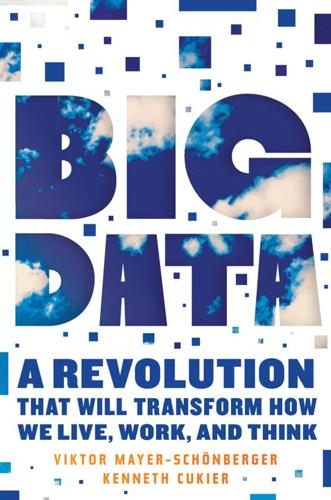
Big Data: A Revolution That Will Transform How We Live, Work, and Think
by
Viktor Mayer-Schonberger
and
Kenneth Cukier
Published 5 Mar 2013
Widespread adoption of Arabic numerals in Europe took hundreds of years, from their introduction in the twelfth century to the late sixteenth century. By that time, mathematicians boasted that they could calculate six times faster with Arabic numerals than with counting boards. What finally helped make Arabic numerals a success was the evolution of another tool of datafication: double-entry bookkeeping. Accountants invented script in the third millennium B.C. While bookkeeping evolved over the centuries that followed, by and large it remained a system of recording a particular transaction in one place. What it failed to do was to show easily at any given time what bookkeepers and their merchant employers care about most: whether a particular account or an entire venture was profitable or not.
…
That began to change in the fourteenth century, when accountants in Italy started recording transactions using two entries, one for credits and one for debits, so that overall the accounts are in balance. The beauty of this system was that it made it easy to see profits and losses. And suddenly dull data began to speak. Today double-entry bookkeeping is usually considered only for its consequences for accounting and finance. But it also represents a landmark in the evolution of the use of data. It enabled information to be recorded in the form of “categories” that linked accounts. It worked by means of a set of rules about how to record data—one of the earliest examples of standardized recording of information.
…
And it provided an audit trail of transactions so that the data was more easily retraceable. Technology geeks can appreciate it today: it had “error correction” built in as a design feature. If one side of the ledger looked amiss, one could check the corresponding entry. Still, like Arabic numerals, double-entry bookkeeping was not an instant success. Two hundred years after this method had first been devised, it would take a mathematician and a merchant family to alter the history of datafication. The mathematician was a Franciscan monk named Luca Pacioli. In 1494 he published a textbook, written for the layperson, on mathematics and its commercial application.
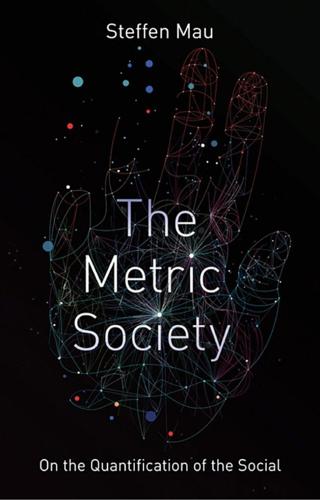
The Metric Society: On the Quantification of the Social
by
Steffen Mau
Published 12 Jun 2017
At the same time, Weber's contemporary, the economist and sociologist Werner Sombart, identified the introduction of double-entry bookkeeping as a decisive step towards a modern capitalist economic order. In his magnum opus Der Moderne Kapitalismus [Modern Capitalism] (1919), Sombart looked at how a rational ‘economic mentality’ came into being. According to Sombart, it was the ability to balance assets and liabilities that essentially allowed economic rationalism and the instinct of acquisition to develop fully. Double-entry bookkeeping, he argued, should be seen not as a purely technical achievement, but as a cultural one which is necessarily reflected in a society's mentality.
…
And they must cultivate an entrepreneurial mindset: risk-conscious, forward-looking, market-aware, flexible and self-reliant. These three things – individual worth accounting, investment activity and an entrepreneurial approach to one's own data – turn people into ‘capitalists of the self’ (Fourcade 2016). Just as double-entry bookkeeping was instrumental to the development of capitalist economics, so the quantification of social assets could foster a new rationalization of everyday life based on numbers. In the age of the metric society, as we have seen, individuals constitute bundles of data in which their personal worth is encoded.
…
Index ‘20-70-10’ rule 155 academics 139 and altmetrics 77–8 and h-index 75–6, 139, 144 self-documentation and self-presentation 76–7 status markers 74–8 accountability 3, 91, 115, 120, 134, 147, 159 accounting, rise of modern 17 activism alliance with statistics 127 Acxiom 164–5 ADM (automated decision-making) 63 Aenta 108 Airbnb 88 airlines and status miles 71–2 algorithms 7, 64, 127, 167 and nomination power 123–5, 126, 141–2 AlgorithmWatch 127 altmetrics 77–8 Amazon 96, 150, 156 American Consumers Union 167 apps 99, 105, 150 finance 66–7 fitness and health 68, 102–3, 104, 107 Moven 65–6 Asian crisis (1997) 57 audit society 24–5 automated decision-making (ADM) 63 averages, regime of 155–7 Barlösius, Eva 113 Baty, Phil 48 Bauman, Zygmunt 143 behavioural reactivity 131 benchmarks, regime of 155–7 Berlin, television tower 40 Better Life Index 20 Big Data 2, 79, 123 biopolitics 19 of the market 70 biopower 19 Boam, Eric 104 body images, regime of 156–7 Boltanzki, Luc 125–6 border controls 73–4 borders, smart 74 Bourdieu, Pierre 111, 114, 115, 162 BP 108 Bude, Heinz 37 bureaucracy 18 calculative practices 11, 124 expansion of 11, 115 and the market 15–17 Campbell, Donald T. 130–1 Campbell's Law 130–1 capitalism 15, 54, 55 digital 150 capitalists of the self 163 Carter, Allan 48 Chiapello, Ève 125–6 Chief Financial Officer (CFO) 17 China Sesame Credit 67 Social Credit System 1, 166 choice revolution 118–19 class and status 33 class conflict switch to individual competition 168–70 classification 60–80 see also scoring; screening collective body 104–6 collective of non-equals 166–8 commensurability 31–3, 44, 159 Committee of Inquiry on ‘Growth, Wealth and Quality of Life’ (Germany) 127 commodification 163, 164 Community (sitcom) 96 companies 16–17 comparison 7, 26–39, 159 and commensurability/incommensurability 31–3 and competition 28 dispositive(s) of 7, 28–31, 159, 169 new horizons of 33–5 part of everyday life 27 prerequisites for social 35–6 registers of 135–9 and self-esteem 30 shifts in class structure of 33 and status 29–30, 36–7 universalization of 27–8 COMPAS (Correctional Offender Management Profiling or Alternative Sanctions) 79 competition 6, 7, 115–19, 159–60 and comparison 28 increasing glorification of 159 and neoliberalism 23 and performance measurement 115–19 and quantification 116–17 and rankings 45 switch from class conflict to individual 168–70 competitive singularities 169 consumer generated content (CGC) 85–6 control datafication and increased 143, 147, 169 individualization of social 143 levers of social 144 relationship between quantification and 78 conventionalization 128 Cordray, Julia 97 Correctional Offender Management Profiling or Alternative Sanctions (COMPAS) 79 Corruption Perceptions Index 26 cosmetic indicators 135 Couchsurfing 88 credit risk colonialization 64 credit scoring 63–7 and social status 67 criminal recidivism, scoring and assessment of 62–3, 79 criteria reductionism 22 cumulative advantages, theory of 174 CureTogether 106 customer reviews 82–6, 87, 88 Dacadoo 68 Daily Telegraph 149 darknet 87 data behaviourism 171 data leaks 152 data literacy 21 data mining 4, 22, 163 data protection 72, 142 data repositories 62, 73–4 data storage 22, 73, 135 data voluntarism 4, 152, 153, 159 dating markets and health scores 70 de Botton, Alain 30 decoupling 133, 136, 174–5 democratization and digitalization 166 difference 2 visibilization and the creation of 40–3 ‘difference revolution’ digitalization giving rise to 166–7 digital capitalism 150 digital disenfranchisement of citizens 151 digital health plans 70 digital medical records 67 digitalization 2, 7, 21–2, 25, 63, 73, 80, 111, 123, 180 and democratization 166 giving rise to ‘difference revolution’ 166–7 as ‘great leveller’ 166 quantitative bias of 124 disembedding 13 distance, technology of 23–4 diversity versus monoculture 137–40 doctors, evaluation of by patients 92–3 Doganova, Liliana 5–6 double-entry bookkeeping 15, 163 e-recruitment 61 eBay 87 economic valuation theory 5 economization 22–4, 38, 115, 117 and rise of rankings 46 education and evaluation 89–91 evaluation of tutors by students 89–90 law schools 44, 138–9 output indicators and resource allocation in higher 132 and Pisa system 122, 145–6 Eggers, Dave The Circle 41, 82–3 employer review sites 83 entrepreneurial self 3, 154 epistemic communities 121 equivalence 16, 27 Espeland, Wendy 44, 139 esteem 29, 30 and estimation 15, 38 see also self-esteem Etzioni, Amitai The Active Society 20 European Union 122 evaluation 81–98 connection with recognition 38 cult and spread of 7, 97–8, 134 education sector 89–91 loss of time and energy 136 and medical sector 91–3 peer-to-peer ratings 87–8 portals as selectors 84–6 pressure exerted by reviews 147–8 and professions 89–93 qualitative 117 satisfaction surveys 82–4 and social media 93–8 of tutors by students 89–90 evidence-basing 3 exercise and self-tracking 101–4 expert systems 7 transnational 121–2 experts, nomination power of 119–23, 126 Facebook 94 FanSlave 95 Federal Foreign Office (Germany) 53 feedback power of 147–8 and social media 93–4 Fertik, Michael 66 Fitch 56 fitness apps 68, 102–3, 104, 107 Floridi, Luciano 105 Foucault, Michel 19 Fourcade, Marion 163–4 Franck, Georg 29 fraud 137 Frey, Bruno ‘Publishing as Prostitution’ 146 ‘gaming the system’ 132 GDP (gross domestic product) 14 dispute over alternatives to 127–8 General Electric 155 Germany Excellence Initiative 51 higher education institutes 52–3 Gerstner, Louis V. 130 Glassdoor.com 83 global governance 122 globalization 34, 73 governance 12 self- 19, 37, 105 state as data manager 17–20 ‘government at a distance’ 145 governmentality 112 GPS systems 150 Granovetter, Mark ‘The strength of weak ties’ 147 gross domestic product see GDP h-index 75–6, 139, 144 halo effect 90 Han, Byung-Chul 154 Hanoi, rat infestation of 130 happiness and comparison 30 Hawthorne effect 107 health and self-tracking 101–4 health apps 68, 102–3, 104, 107 health scores 67–71 health status, quantified 67–71 Healy, Kieran 163–4 Heintz, Bettina 14, 33, 34 hierarchization/hierarchies 1, 5, 6, 11, 33, 39, 40–59, 174 and rankings 41–2, 43, 44, 48 higher education, output indicators and resource allocation 132 Hirsch, Jorge E. 75 home nursing care 135–6 hospitals and performance indicators 131 Human Development Index 14 hyperindividualization 167–8 identity theory 29 incommensurability 31–3 indicators 2, 3, 5, 20, 23–4, 34, 114, 159 and competition 116–17 and concept of reactive measurements 129–33 cosmetic 135 economic 7 governance by 24 politics of 14 status 35, 75 see also performance indicators individualization of social control 143 industrial revolution 19 inequality 6, 8, 158–76 collectives of non-equals 166–8 establishment of worth 160–2 inescapability and status fluidity 170–4 reputation management 162–6 switch from class conflict to individual competition 168–70 inescapability of status 170–4 information economy 2 information transmission interfaces, between social subsystems 165–6 institutional theory 113 insurance companies 72, 108, 151, 152, 167 International Labour Organization 122 investive status work 36–7 Italian Job, The (film) 138 justice 126 Kaube, Jürgen 2 Kula, Witold 16 Latour, Bruno 34 law schools 44, 138–9 league tables 35, 43, 46, 47, 51, 52, 53, 91, 138, 139, 146, 162, 175 legitimate test, concept of 125–6 Lenin, Vladimir 116 lifelogging 99, 109, 153 Luhmann, Niklas 166 Lyon, David 142 McClusky, Mark 101 McCullough, Nicole 97 Mann, Steve 153 market(s) calculative practices of 15–17 and neoliberalism 23 and rating agencies 55–6 Marron, Donncha 65 Matthew effect 174–5 measurement, meaning 10 media reporting 33 medical sector and evaluation 91–3 hospitals and performance indicators 131–2 MedXSafe 70 meritocracy 23, 161 Merton, Robert K. 161, 174 ‘metric revolution’ 16 Miller, Peter 112 mobility 71–4 border controls 73 digital monitoring of 72 and scoring 71–4 smart cars 72 and status miles 71–2 money as means of exchange 16 monoculture versus diversity 137–40 mood, self-tracking of 101–4 Moody's 56 motivation 106–10 and rankings 45 Moven 65–6 Münch, Richard 145 Nachtwey, Oliver 150 naturalization 113 neoliberalism 3, 12, 23, 25 basic tenets of 23 New Public Management 3, 117, 136, 155 NHS (National Health Service) 118 nomination power 111–28 and algorithms 123–5, 126, 141–2 critique of 125–8 and economization 115 of experts 119–23, 126 performance measurement and the framing of competition 115–19 and the state 112–15 non-equals, collectives of 166–8 normative pressure 144–6 North Korea 144 ‘number rush’ 2 numbers 13–14, 15 numerical medium 8, 14, 16, 18, 28, 33, 113, 160, 166 objectivization 35, 154, 160 OECD 122 Offe, Claus 175 Old Testament 17 omnimetrics 9 O’Neil, Cathy Weapons of Math Destruction 79 optimization 12, 25 Oral Roberts University (Oklahoma) 108 Peeple app 96–7 peer-to-peer ratings 87–8 Pentland, Alex 151 people analytics 150–1 performance enhancement 12 performance indicators 12, 38, 53, 74, 118, 119, 120, 129, 155 and hospitals 131–2 performance measurement 23, 38, 115–19 performance-oriented funding allocation 22 performance paradox 132 performance targets 4 Personicx 165 Pisa system 122, 145–6 politicians 14, 120 politics 114 portals 84–6, 88, 90–1 power of nomination see nomination power prestige 8, 29, 67, 144 principal–agent problem 147–8 private consultancy services 117 professional control, loss of 133–4 professionalization 19, 133 professions and evaluation 89–93 publicity 33 QS ranking 52 qualitative evaluation 117 quantification advantages of 8 engines of 21–5 history 11 impact and consequences of 5, 6 meaning 10, 12–15 risks and side-effects 7, 129–40 role of 35 quantified self 99–110 Quantified Self (network) 99–100 quantitative evaluation see evaluation quantitative mentality 11–12 quasi-markets 116, 118–19 race and assessment of criminal recidivism risk 79 rankings 47–53, 58–9, 60, 144 and competition 45 and compliance 44 differences between ratings and 42–3 disadvantage of 43–4 economization and rise of 46 and evaluation portals 84–6 and hierarchies 41–2, 43, 44, 48 and image fetishization 47 and motivation 45 as objectivity generators 41 performance-enhancing role 46 popularity of 41 as positional goods 45 purpose of 45 and reputation 48, 49, 50, 52 as social ushers 42 and status anxiety 46–7 university 6, 7, 43, 47–53, 144, 175 Welch's forced 155–6 rating agencies, market power of 53–9 ratings 41–3, 53–9, 60 definition 54 differences between rankings and 42–3 and evaluation portals 84–6 as objectivity generators 41 peer-to-peer 87–8 as social ushers 42 rationalization 5, 11, 12, 14, 15, 16, 19, 105, 110, 154, 163 Raz, Joseph 31–2 reactive measurements 129–33 recommendation marketing 85 recruitment, e- 61 reference group theory 29 reputation 29, 39, 66, 74, 121 academic 75–6 cultivating good 47 and rankings 48, 49, 50, 52 rating of 87–8 signal value of 87 social media and like-based 93–8 reputation management 4, 50, 162–6 reputation scoring 87–8 research community 146 and evaluation system 146 and review system 146–7 ResearchGate 77 reviews 136 customer 82–6, 87, 88 doctor 92 high demand for 136 lecturers/tutors 90 performance 25, 149 pressure exerted by popular 147 Riesman, David 37 risks of quantification 129–40 loss of professional control 133–5 loss of time and energy 135–7 monoculture versus diversity 137–40 reactive measurements 129–33 Rosa, Hartmut 94, 173 Rose, Nikolas 112 Rousseau, Jean-Jacques 28–9 running apps 107 Runtastic app 107 satisfaction surveys 82–4 Sauder, Michael 44, 139 Schimank, Uwe 134 Schirrmacher, Frank 152 Schmidt, Eric 147 schools and choice 118–19 evaluation of 90–1 league tables 46 and Pisa system 122, 145–6 scoring 7, 60, 61, 78–80 academic status markers 74–8 and assessment of criminal recidivism 62–3 credit 63–7 health 67–71 mobility value 71–4 pitfalls 79 screening 7, 60–1, 78–9 border controls 73–4 e-recruitment 61–2 function 60–1 smart cars 72 self-direction 105, 121, 143 self-documentation 153 and academic world 76–7 self-enhancement 3, 137 self-esteem 29, 37, 170 and comparison 29, 30 rankings and university staff 50–1 self-governance 19, 37, 105 self-image 37, 47, 50, 89 self-management 3, 20, 25 self-observation 25, 42 quantified 99–110 self-optimization 3, 19, 104, 109, 163 self-quantification/quantifiers 4, 13, 25, 101, 154–5, 156 self-reification 105 self-responsibility 25, 110 self-tracking 4, 7, 99, 100, 106, 109–10 collective body 104–6 as duty or social expectation 108 emotions provoked 109 health, exercise and mood 101–4 and motivation 106–10 problems with wearable technologies 103–4 running and fitness apps 68, 102–3, 104, 107 and sousveillance 153 as third-party tracking 154 self-worth 29, 36, 38, 47, 51, 170 and market value 67 Sesame Credit (China) 67 Shanghai ranking 47 ‘shared body’ 105 shared data 142, 152–3 Simmel, Georg 28 ‘small improvement argument’ 32 smart borders 74 smart cars 72 smart cities 21 smart homes 21 ‘social accounts’ 20 Social Credit System (China) 1, 166 social engineering 20 social management 20 social media 93–8, 153, 166 drivers of activity 93 and feedback 93–4 forms of connection 93 likes 93–5 and online disinhibition 153 and reputation building 95 resonance generated by 94 and running/fitness apps 107 social research 19–20 social security systems 19 social status see status social worth see worth socio-psychological rank theory 46 sociometrics/sociometers 2, 5, 36, 74, 141, 150–1 Sombart, Werner Modern Capitalism 15–16 sousveillance 153 sport 33 rise of world 35 Staab, Philipp 149–50 Stalder, Felix 124 Standard & Poor's 54, 56 statactivism 127 state as data manager 17–20 nomination power of the 112–15 statistics 14 origins of word 17 status and class 33 and comparison 29–30, 36–7 and credit scoring 67 inescapability from 170–4 and life satisfaction 30 seeking of 36 status anxiety 30 and rankings 46–7 status competition 26–39 status data 2, 80, 159, 161–2, 169, 174 functioning as symbolic data 8, 162 status fluidity 170–4 status insecurity 4 status miles 71–2 status sets 161–2 status symbols 158 status work 4, 36–7, 174 Stiglitz-Sen-Fitoussi Commission (France) 127 Streeck, Wolfgang 171–2 subprime crisis (2007) 57, 64 surveillance 8, 142, 152 interdependence of self- and external 153–5 and neoliberalism 23 workplace and technological 149–51 surveys, satisfaction 82–4 symbolic capital 174 status data as 8, 162 target setting 22 tariff models 152–3 technological surveillance, in the workplace 149–51 technologies of the self 25 tertium comparationis 32 Thomas theorem 59 Thompson, David C. 66 Times Higher Education ranking 47, 48, 53 tourism portals 85 tracking as double-edged sword 142 see also self-tracking trade relations 16 transnational expert systems 121–2 transparency 3, 91, 141–3, 144, 147 Transparency International 26 ‘transparent body’ 105 TripAdvisor 85 Trustpilot 86 Turkey 54 tutors evaluation of by students 89–90 Uber 156 űbercapital 163–4 UN Sustainable Development Goals 20 United Nations 122 university lecturers evaluation of 89–90 object of online reviews 90 university rankings 6, 7, 43, 47–53, 144, 175 valorization 5, 58, 124, 161 valuation 5–6 value registration 161 Vietnam War 131 visibilization, and the creation of difference 40–3 Webb, Jarrett 104 Weber, Max 15, 16, 154 Weiß, Manfred 119 Welch, Jack 155 ‘winner-take-all society’ 136 Wolf, Gary 99–100 Woolgar, Steve 34 workplace technological surveillance in the 149–51 World Bank 122 worth 5–6, 7, 11, 78–80, 170 assessments of 27 establishment of 160–2 orders of 11, 15, 29 self- 29, 36, 38, 47, 51, 67, 170 Young, Michael 161 The Rise of Meritocracy 23, 161 Zillien, Nicole 105 Zuckerberg, Mark 158 POLITY END USER LICENSE AGREEMENT Go to www.politybooks.com/eula to access Polity's ebook EULA.

Venice: A New History
by
Thomas F. Madden
Published 24 Oct 2012
Furthermore, the Venetian government had strict laws regarding what could or could not be shipped, stored, or charged against profits. The need for maintaining clear records of complex transactions led to one of Venice’s most profound financial inventions: double-entry bookkeeping. While it may not seem exciting, the development of double-entry bookkeeping fundamentally changed business in the West. Indeed, without it, the later Industrial Revolution could not have been sustained, and modern corporations would be unthinkable. The technique was first described by Fra Luca Pacioli, a Franciscan mathematician who lived and taught in Venice between 1465 and 1475.
…
There is always a credit and always a debit to be recorded, and these two must balance at all times. So, for example, rather than recording a payment received for services rendered, a Venetian merchant would record a movement from cash to revenue. Double-entry bookkeeping may well have developed precisely to deal with the complexities of the multiple-investor colleganza. Because it records both assets and liabilities and the effect of transactions on them, double-entry bookkeeping allowed merchants to easily calculate profit and loss in otherwise complex systems. Just as importantly, it makes the detection of error or fraud much simpler, since everything must balance every day.
…
Thus, when a ship’s captain returned to Venice, his investors and the state need not take his word for how much profit he had obtained. Every penny of every expense or income was accounted for in his ledgers, and auditors were careful to make certain that it all balanced. Even in today’s infinitely more complex corporate systems, embezzlement and theft are still usually detected because the books do not balance. Double-entry bookkeeping was itself a major reason for the adoption in Europe of something that one can find on this very page—Arabic numerals. Originally developed in India, this system of numerical notation was adopted in Persia and then spread into Arab North Africa, from whence it entered medieval Europe in the eleventh century.

Culture and Prosperity: The Truth About Markets - Why Some Nations Are Rich but Most Remain Poor
by
John Kay
Published 24 May 2004
In a coordinated system, the position of the last piece is predetermined by the position of all the others. 1 The economic analogue is Walras's law. Walras's law is an economic application ofbookkeeping principles. Double-entry bookkeeping is not as exciting an invention as railroads or the Internet. But double-entry bookkeeping was as important as these innovations to the development of modern market economies. Every expenditure must be matched by a receipt. By keeping track of all entries in a ledger, the activities of a household or business can be regulated and controlled. Double-entry bookkeeping put the discipline in disciplined pluralism. Double-entry bookkeeping is to economic and commercial life what the second law of thermodynamics is to the physical world, and it has the same role in deflating pretensions of dreamers and fantasists.
…
Markets for risk and for capital developed, and with them the idea that you can trade paper rights to commodities as well as commodities themselves. These are the beginnings of modern securities markets. Businesses develop that are distinguishable from the individuals who run them, such as trading companies and banks. Their records are maintained through double-entry bookkeeping. 7 From the Reformation to the Industrial Revolution ••••••••••••••••••••••••••••••••••••• The Reformation followed the Renaissance: revolts, centered in England and in Germany, rejected the established authority of the Catholic Church. And the focus of economic development in Europe moved north.
…
See supply and demand democracy accountability in, 114,314 central planning in, 110-11, 114 as rich state factor, 51, 69, 322 dependencytheor~60,284-86 derivatives, 160-61, 237 design, order without, 125-26, 129 development economics, 277-88, 355 Diamond,Jared, 76 diamond market, 150 disciplined pluralism, 18-19,21,56, 120-24, 199,306,308,345-46 dividends, 170, 171 division oflabor, 1, 18, 19, 82, 84, 92, 198, 355 as competitive advantage, 88-89 and complexity, 181 coordination of, 126 as gainful exchange, 85-87 specialization as, 19, 85-86, 181 in teams, 252,291,293,301,302-10 divorce insurance, 238-40 DIY (do-it-yourself) economics, 21, 176-78, 346-47 DNA structure, 83, 267 dot.com bubble, 78, 123-24, 175,218, 243-44,348 double-entry bookkeeping, 55 application to whole economy, 175-78 Douglas, Roger, 61 Duhem-Quine problem, 326-27 Dunlap, Al, 315 Dworkin, Ronald, 190 Easterly, William, 212, 213 Eastern Europe, 29, 51,287-88, 335 econometrics, 357 economic development/growth, 54-69,277-88 dependencytheory,60,284-86 and division oflabor, 85-89 factors in, 25, 26, 52, 55-57, 60, 66-68, 283,285 and GOP movements, 39 United States (1990s), 10 See also Asia; Eastern Europe; statistics economic lives, 3-8, 22-30 dimensions of, 37-41,44-49 GOP as measure of, 42-45 and happiness, 51,286-87 transactions/rules, 73-82 and "veil of ignorance," 202 See also income/wealth distribution economic models, 15-16, 325, 330-33, 339 economic rent, 145,230-31,273,290-301 definition of, 292, 295 { 413} distribution of, 290-91,303-5,309-10 rentseeking,295-96,307,346-47 See also teams economics, 323-39 branches of, 323-24 constraints of, 175-76 definitions of, 83, 324 DIY, 21, 176-78,346-47 mathematical tools, 174-75, 179 methodology, 84, 325-27 popular understanding of, 21, 323 See also neoclassical economics economic systems, 73-134 choices between, 103-4 constraints of, 175-78 effectiveness measures, 84 evolution of, 54-69 and living standards, 28-30 and welfare economics, 197-202 See also central planning; embedded market; market economy Economic Value Added, 273 economies of scale, 118,181,182-83 economists, 329, 334-35, 342 images of, 323, 324, 326-27, 334 influential (twentieth-century), 178-79 male-female disparity, 337 rationality emphasis, 210-13,218-19 Eddystone lighthouse, 248-49 Edgeworth, F.
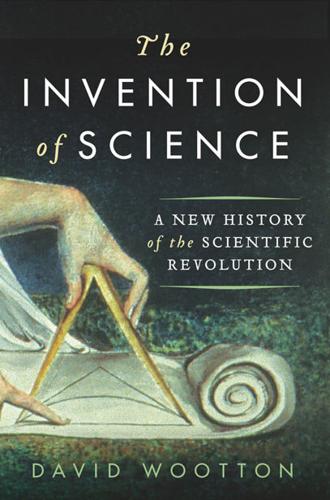
The Invention of Science: A New History of the Scientific Revolution
by
David Wootton
Published 7 Dec 2015
The errors, then, lie not in the abstractness or concreteness, not in geometry or physics, but in a calculator who does not know how to make a true accounting.3 Double-entry bookkeeping thus represents an attempt to make the real world, the world of bolts of silk, bales of wool and bags of sugar, mathematically legible. The process of abstraction it teaches is an essential precondition for the new science. § 2 Another source of income for mathematicians in Galileo’s day was teaching the geometrical principles of perspective representation.4 Galileo’s own mathematics teacher, Ostilio Ricci, taught perspective to painters. Perspective painting was a more recent invention than double-entry bookkeeping. It began sometime between 1401 and 1413 when Filippo Brunelleschi produced a most peculiar work of art.5 The object itself no longer survives; we last hear of it in 1494, when it is listed among the effects of Lorenzo the Magnificent, the Medici ruler of Florence, on his death.6 Our only half-decent description of it was written in the 1480s, by Antonio Manetti, who was twenty-three years old when Brunelleschi died.7 Manetti’s account is puzzling and unsatisfactory, but it is all we have.
…
It is written in mathematical language and the characters are triangles, circles and other geometrical figures; without these means it is humanly impossible to understand a word of it; without these there is only clueless scrabbling around in a dark labyrinth. – Galileo, The Assayer (1623)1 § 1 Double-entry bookkeeping goes back at least to the thirteenth century. The principle of double entry is simple: every transaction is entered twice, as a credit and as a debit. So if I buy a bar of gold worth £500, I debit £500 from my current account, and I credit £500 to my list of assets. If I borrow £500, then £500 is a credit to my current account, and a debit to my list of liabilities.
…
He was not himself an artist, but On Divine Proportion discusses the golden section, the principles of architecture and the design of typefaces. Pacioli is now known primarily for the fat book on which the dodecahedron sits: A Compendium of Arithmetic, Geometry, Proportions and Proportionality (1494). This was a textbook of applied mathematics, and included within it was the first published account of double-entry bookkeeping – double entry was not new, but printing was, so Pacioli was taking advantage of an obvious opportunity.33 § 4 Perspective painting generally involves a peculiar form of abstraction: the construction of a vanishing point. It is worth noting that the term itself is relatively modern: in English it dates to 1715.
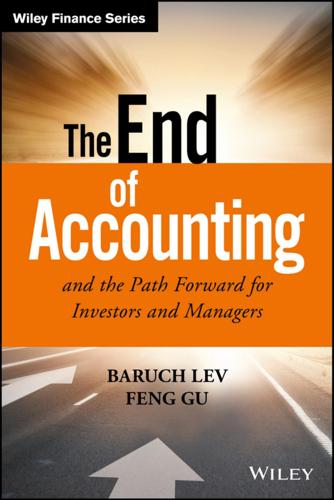
The End of Accounting and the Path Forward for Investors and Managers (Wiley Finance)
by
Feng Gu
Published 26 Jun 2016
The consequence of this disclosure ossification, as we will demonstrate empirically in the following chapters, is the inevitably fast and continuous deterioration in the usefulness of financial information to investors. A DEVIL’S ADVOCATE Perhaps, you may say, this is inevitable. Corporate financial reporting reached its technological apogee 110 years ago, as did double-entry bookkeeping 550 years ago, and cannot be further improved, like the QWERTY keyboard layout introduced in 1878 in the Remington No. 2 typewriter and still on keyboards today. Absurd as this sounds, it would have made some sense if suggestions for accounting change were seriously tried and found to fail.
…
ACCOUNTING AND NONACCOUNTING EVENTS With all the shortcomings of the accounting system, and there are quite a few as we point out throughout the book, there is one thing accounting excels in—the meticulous recording of business transactions. In fact, Luca Pacioli (1445–1517), the Renaissance mathematician who formalized and promulgated “double-entry bookkeeping” to the general public in his classic book (1494) Summa de Arithmetica, Geometria, Proportioni, et Proportionalita, warned readers that nothing could be omitted from the accounting records and that comprehensive recording of transactions is essential to successful business operations and corporate governance.1 But the business events captured so meticulously by the accounting system, and subsequently summarized in corporate financial reports, are primarily transactions with third parties: purchases from suppliers and sales to customers; payments of wages, rent, and interest; stocks and bond issues; as well as investments in long-term assets and securities.
…
While gathering a limited following, none of these criticisms and proposals had a noticeable effect on corporate reporting worldwide, and definitely not in the United States. The fact is, as shown vividly in Chapter 1, corporate reports today are practically identical to those published a century ago, mirroring the 600-year survival of double-entry bookkeeping. Accounting seems resistant to change. The reason for the limited success of previous reform proposals is not lack of effort (some change proposals are vigorously pushed by worldwide organizations) or the absence of good ideas—there are definitely some useful suggestions in these proposals.

Reinventing Capitalism in the Age of Big Data
by
Viktor Mayer-Schönberger
and
Thomas Ramge
Published 27 Feb 2018
In his masterful history of accounting, Jacob Soll suggests that reporting within a firm took off when its leaders realized that more information flowing to them could be translated into better control over the activities within their enterprise, as evidenced by the ascent of a number of Italian merchant families—the Medici, the Bardi, the Peruzzi, and others—to the heights of commercial success, establishing them as the preeminent bankers of fifteenth-century Europe. First among them was Cosimo de’ Medici the Elder, who took over the family firm after his father’s death, in 1429. When Cosimo inherited the business, double-entry bookkeeping, the idea that every business transaction should be represented twice in an accounting system, as an influx and outflow of value, was no longer a novel idea; in fact, all merchants in Florence were required to maintain such records for the calculation of their tax bills. But bookkeeping was seen as a duty owed to the state, not as a mechanism for internal control.
…
With accounting, the head of a firm could determine whether his agent’s actions were successes or failures and act accordingly. There was a material reckoning. But good accounting also laid the groundwork for steady information flows that allowed firms to extend the scale and scope of their operations. Double-entry bookkeeping did not become the norm in most firms for the next several centuries. The generation of Medici after Cosimo, as well as other wealthy Italians, discarded the practice of accounting in favor of more “intellectual” pursuits, such as politics and the arts. Accounting was deemed to be below their elite status.
…
See progressive data-sharing mandate dating websites, 49, 82–84, 163 decentralization, 7, 11, 13, 32, 90, 121 automation and, 80 bad decisions mitigated by, 38–39 of communicative coordination, 26 dyadic information exchange and, 72 firms and, 125, 127 matching and, 74, 127 decentralization with coordinated control, 101 decision-making automation overextension in, 116–120 centralized vs. decentralized (see centralization; decentralization) in firms, 95–107 irrational, 42–44 in markets, 42–44, 49, 161, 169–171 money and price simplification of, 49 delegation, 97–101, 106, 117, 218–219 Deloitte, 75, 126 Descartes, René, 223 Didi Chuxing, 163 digital Taylorism, 89 Distillers, 42 distributive policy measures, 186–187, 189, 190, 193, 197–200 See also taxes Doriot, Georges, 216 dotcom bubble, 6, 142–143 double-entry bookkeeping, 92–93 driving systems, autonomous, 78, 181–183, 213 Durant, William, 98 East India joint-stock companies, 93 eBay, 9, 69, 70, 75, 209, 215 decline in, 1–3 network effects and, 163 worth of goods traded on, 1 Economist, 89 education sector, 6–7, 199, 214 Ek, Daniel, 122–123 Embark, 182 Emergency Economic Stabilization Act of 2008, 134 Encyclopédie, 21 energy markets, 213 enterprise resource planning (ERP), 100 ESPN, 67, 69 eToro, 152 Europe, 135, 136, 164, 196, 198 European Parliament, 187 European Union, 140 evolution, 20–21, 22 Expedia, 70 Expertmaker, 70 externalities, 73, 74 Ezrachi, Ariel, 166 Facebook, 30, 148, 178, 196 feedback effects and, 169 market concentration in, 161 network effects and, 163, 166 fair value, 172–173 feedback effects, 78–80, 104, 157–179, 210, 211 development of theory, 159–160 government control via, 175–179 market concentration and, 161–169, 171 regulatory measures proposed for, 171–175 threat posed by, 166–167 Ferguson, Niall, 45 Ferrucci, David, 115 finance capital.
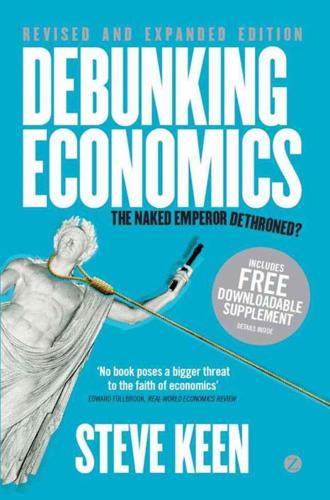
Debunking Economics - Revised, Expanded and Integrated Edition: The Naked Emperor Dethroned?
by
Steve Keen
Published 21 Sep 2011
But again, the qualitative similarity between the model and the empirical data is striking – see Figure 14.20. 14.19 Debt and GDP in the model 14.20 Debt and GDP during the Great Depression Making monetary modeling accessible: QED I originally developed the models in this chapter using differential equations, and I found it very difficult to extend them, or explain them to other economists who weren’t familiar with this approach to mathematics. Then a chance challenge to the accuracy of my models – Scott Fullwiler asserted that there must be errors in my models from the point of view of double-entry bookkeeping – inspired me to see whether I could in fact explain my models using double-entry bookkeeping. Not only did that prove possible, it also transpired that a double-entry bookkeeping layout of financial flows could be used to generate the models in the first place. This overcame a major problem that I had with using system dynamics programs like Vissim (www.vissim.com) and Simulink (www.mathworks.com/products/simulink/) to build models of the financial sector.
…
.: 4; emphasis in original). 14.2 The nature of exchange in the real world This simple but profound perspective on what is the essence of a monetary capitalist economy yielded two essential requirements for a model of capitalism: • all transactions involve transfer of funds between bank accounts; • the minimum number of classes5 in a model of capitalism is three: capitalists, workers and bankers. It also implied that the best structure for modeling the financial side of capitalism is a double-entry system of bank accounts. This led me to develop a means to derive dynamic monetary models of capitalism from a system of double-entry bookkeeping accounts (Keen 2008, 2009b, 2010, 2011), and a remarkable amount of the Marx-Schumpeter-Keynes-Minsky perspective on capitalism arose naturally out of this approach. I’ll outline the simplest possible version of this model before expanding it to provide a monetary version of the Minsky model outlined in Chapter 13.
…
However, in a model of financial flows, the same term could turn up as often as three times in one diagram: once for the source account for some monetary transfer, once for its destination, and once to record it on a ledger. This resulted in almost incomprehensible models, and made ‘wiring up’ such a model extremely tedious. I now use my double-entry bookkeeping methodology to develop models like the one in this chapter, and a simulation tool has also been developed for me to showcase this method. It’s free, fairly easy to use, and you can both simulate the models I’ve shown in this chapter and build your own using it. It’s called QED – which stands for Quesnay Economic Dynamics – and can be downloaded from my blog at www.debtdeflation.com/blogs/qed/.
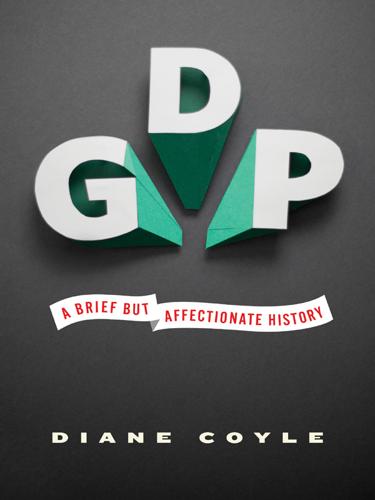
GDP: A Brief but Affectionate History
by
Diane Coyle
Published 23 Feb 2014
Petty wanted to prove not only that the country could bear a higher burden of taxes but also that it was capable of taking on its powerful neighbors, Holland and France.1 There was no need for it to win more land or increase the size of the population to ensure victory, because the available land and capital and labor could be used to better effect. This was a significant economic insight. Also significant was Petty’s introduction of the tool of double-entry bookkeeping to keep records for the nation as a whole. Another early set of estimates, by Charles Davenant in 1695, had the title An Essay upon the Ways and Means of Supplying the War, making his aim perfectly clear. The word statistics has the same origin as state, and originally referred to the collection of figures concerning the state, specifically taxes.
…
Abramowitz, Moses, 113 Africa, 31–33, 72, 93, 138 Anders, William, 68 art, 127–28, 132 assets, contributing to sustainability, 134–35, 137 austerity measures, 23 Australia, 73, 109, 118 automation, 128–29 Bangladesh, 53 base year, in GDP calculations, 31, 33–34 Baumol, William, 127 Benford’s Law, 3, 143n3 Berners-Lee, Tim, 81 Bhalla, Surjit, 53 Bhutan, 112 Bos, Frits, 47–48 Boskin Commission, 35, 88 Brazil, 94, 125 Bretton Woods system, 48 BRIC economies, 94, 96 Brynjolfsson, Erik, 128–30 Burundi, 73 business, purpose of, 95 Campaign for Happiness, 112 Canada, 73, 89, 109 capabilities, 72–73, 134 capital consumption, 131 capitalism: 1970s crisis of, 59–75; 2008 crisis of, 93–118; achievements of, 5–6; innovation as hallmark of, 91; investment and depreciation, 131–33 capital widening, 132 Carson, Rachel, Silent Spring, 69 centrally planned economies, 46–47, 56, 60, 66–68 Central Statistical Office (United Kingdom), 18 Chad, 73 chain-weighted price indexes, 33–34 China: economic growth of, 94, 96–97; economic limitations of, 96–97; GDP of, 51–53, 96, 97; living standards in, 51, 57, 96; manufacturing and exporting in, 82, 97, 125; U.S. relations with, 97 Christophers, Brett, 104, 105 circular flow, 26–27, 27f, 57, 63 Clark, Colin, 12, 13, 17, 50, 84 Clean Water Act (1972), 69 Clegg, Nick, 110 Cobb, John, 116 Cold War, 46–47, 60, 66 communications technology, 81–82 communism, 46–47, 60, 66–68, 96 compound arithmetic, 64, 83, 130–31 comprehensive wealth, 133, 135 computers, 80–82, 87–88 conspicuous consumption, 112 consumerism, 45, 112 consumer spending (C), 27–28, 45 consumer surplus, 130 customization, of goods and services, 123–25 Cuyahoga River, 69 Daly, Herman, 116 Darling, Alastair, 102 dashboard approach, 118, 136 data collection, 33, 37, 51–53, 137–38 Data Resources, Incorporated (DRI), 21 Davenant, Charles, 8 David, Paul, 79 Defense Advanced Research Projects Agency (DARPA), 81 defense spending, 14–16 deferred stock options, 37 deflators, 31 Defoe, Daniel, 9 DeLong, Brad, 86, 117 Democratic Republic of Congo, 54, 73 Deng Xiao Ping, 96 depreciation, 25, 30, 131–33 developed/high-income countries: GDP of, 72, 93; informal economy in, 107 developing/low-income countries: economic growth/stagnation in, 61, 71–72; GDP of, 32–33, 51, 71–72; informal economy in, 107, 109; and PPP, 50–53 development aid, 72, 74 digital products and services, 129–31 disasters, GDP growth after, 43 Domar, Evsey, 55 double-entry bookkeeping, 8 Easterlin, Richard, 111 Eckstein, Otto, 21 econometric models, 20–21, 23 economic growth: critiques of, 60; in eighteenth and nineteenth centuries, 12; lack of, in developing countries, 61; meanings and measures of, 15; meanings of, 123; potential rate of, 82–83; problems arising from, 63–64; real, 30–31; significance of, 135–36; sustainable, 71, 116, 137; theories/models of, 55–57, 78–81; virtuous circle of, 57, 59, 64, 73, 79; well-being and welfare aided by, 135 economics, challenges to conventional, 59–61 economic welfare.
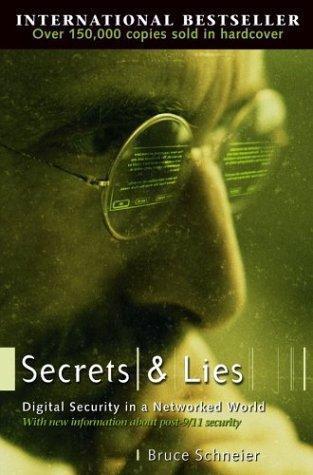
Secrets and Lies: Digital Security in a Networked World
by
Bruce Schneier
Published 1 Jan 2000
The mark is taken because he can’t imagine that what he’s seeing—the rooms, the people, the noise, the action—is really only a performance enacted solely for his benefit. On the Net, this is easy to do. In a world without physical cues, people need some new way to verify the integrity of what they see. AUDIT Double-entry bookkeeping was codified by 1497 by Luca Pacioli of Borgo San Sepolcro, although the concept is as much as 200 years older. The basic idea is that every transaction will affect two or more accounts. One account is debited by an amount exactly equal to what the other is credited. Thus, all transactions are always transfers between two accounts, and since they always appear with a plus sign in one account and a minus sign in the other, the total over all accounts will always be zero.
…
This balancing process was an audit: If one clerk tried to commit fraud—or simply made a mistake—it would be caught in the balancing process, because someone other than the clerk would be checking the work. Additionally, there would be outside audits, where accountants would come in and check the books over again ... just to make sure. Audit is vital wherever security is taken seriously. Double-entry bookkeeping is just the beginning; banks have complex and comprehensive audit requirements. So do prisons, nuclear missile silos, and grocery stores. A prison might keep a record of everyone who goes in and out the doors, and balance the record regularly to make sure that no one unexpectedly left (or unexpectedly stayed).
…
(Well, there are some attacks: blocking the writing, simulating running out of ink, disabling the writing for a single transaction, forging an entire tape, and so forth.) On the other hand, computer files can easily be erased or modified; this makes the job of verifying audit records more difficult. And most system designers don’t think about audit when building their systems. Recall the built-in audit property of double-entry bookkeeping. That auditability fails when both books are stored on the same computer system, with the same person having access to both. But this is exactly how all computer bookkeeping programs work. ELECTRONIC CURRENCY Back in the old days (1995 or so), everyone thought that we would have to develop new forms of money to deal with electronic commerce.

The Rational Optimist: How Prosperity Evolves
by
Matt Ridley
Published 17 May 2010
The Tasmanian market was too small to sustain many specialised skills. Imagine if 4,000 people from your home town were plonked on an island and left in total isolation for ten millennia. How many skills and tools do you think they could preserve? Wireless telephony? Double-entry book-keeping? Suppose one of the people in your town was an accountant. He could teach double-entry book-keeping to a youth, but would the youth or the youth’s youth pass it on – for ever? On other Australian islands much the same thing happened as on Tasmania. On Kangaroo Island and Flinders Island, human occupation petered out, probably by extinction, a few thousand years after isolation.
…
With rising wages, some of the surviving peasantry could once more just afford the oriental luxuries and fine cloth that Lombard and Hanseatic merchants supplied. There was a rash of financial innovation: bills of credit to solve the problem of how to pay for goods without transporting silver through bandit country, double-entry book-keeping, insurance. Italian bankers began to appear all across the continent, financing kings and their wars, sometimes at a profit, sometimes at a disastrous loss. The wealth that the Italian trading towns had generated soon found its way into scholarship, art or science, or in the case of Leonardo da Vinci, all three.
…
Innovation is like a bush fire that burns brightly for a short time, then dies down before flaring up somewhere else. At 50,000 years ago, the hottest hot-spot was west Asia (ovens, bows-and-arrows), at 10,000 the Fertile Crescent (farming, pottery), at 5,000 Mesopotamia (metal, cities), at 2,000 India (textiles, zero), at 1,000 China (porcelain, printing), at 500 Italy (double-entry book-keeping, Leonardo), at 400 the Low Countries (the Amsterdam Exchange Bank), at 300 France (Canal du Midi), at 200 England (steam), at 100 Germany (fertiliser); at 75 America (mass production), at 50 California (credit card), at 25 Japan (Walkman). No country remains for long the leader in knowledge creation.
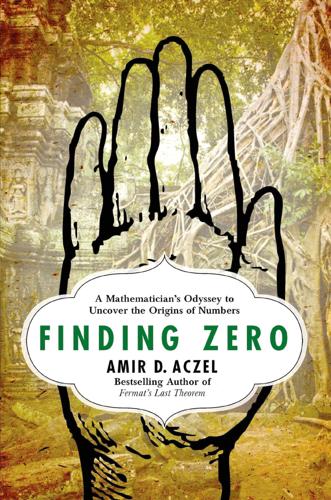
Finding Zero: A Mathematician's Odyssey to Uncover the Origins of Numbers
by
Amir D. Aczel
Published 6 Jan 2015
During the Han Dynasty in China (206 BCE to 220 CE), a mathematical work titled Nine Chapters on the Mathematical Art appeared, employing both positive numbers, colored red, and negative ones, colored black. And in Egypt of the third century, a leading Greek mathematician named Diophantus obtained negative answers to some of his equations but immediately dismissed them as unrealistic. So the idea for negative numbers is quite old, but people did not understand such numbers. The double-entry bookkeeping system used in accounting today was developed in Europe in the thirteenth century in part to avoid using negative numbers. To define negative numbers requires the concept of zero. Negative numbers are, in a sense, a reflection across zero of the positive numbers. You can see this if you draw the number line, starting at zero and going to the right to 1, 2, 3, and so on; and then extending the numbers to the left of zero to –1, –2, –3, and onward.
…
S., 43–4 çaka (dynasty), 95–7, 209–10, 214 Cambodia Cambodian National Museum, 102, 128–9, 165, 203–4, 218–19 Khmer Rouge, 98–9, 107–8, 125, 129, 150, 163, 166, 173, 176, 200, 202–3, 210, 219, 222 See also Angkor (Cambodian empire); Phnom Penh (Cambodian capital); Sambor on Mekong, Cambodia; Siem Reap, Cambodia Cantor, Georg (mathematician), 145–8 Cantor, Moritz, 74–5, 77 cargo ships, 18–19 Carnac stones, 22 Cartier, Pierre, 59 Casselman, Bill, 83, 186–8, 191, 197 catuskoti (four corners/possibilities, also tetralemma), 57, 60–1, 105–6, 137, 139–42, 148, 152 Chamroeun Chhan, 116–17, 166, 171–2, 189 Chandra (Hindu god), 103 Chao Phraya River, 113–15, 164 Chatur-bhuja temple, 78, 210 Chenla (ancient region, later Burma and Myanmar), 91–3, 205 China Chou Ta-kuan, 101–2 Cultural Revolution, 98 Fu Nan kingdom, 91–3, 205 Han Dynasty, 23 Nine Chapters on the Mathematical Art, 23 three-by-three squares, 48 Chou Ta-kuan (also Zhou Daguan), 101–2 Cœdès, Georges (archaeologist), 83–4, 100, 102, 106–8, 124, 150, 187, 204 Angkor, 92 birth and education, 85–9 career and life, 114–15, 117, 119–20, 128, 150, 156, 176 death and final years, 108, 216–17 on Khmer number system, 214–15 translation of K-127, 93–7, 107, 166, 176, 207–8, 210 Communism, 98, 118, 120, 131, 216 Khmer Rouge, 98–9, 107–8, 125, 129, 150, 163, 166, 173, 176, 200, 202–3, 210, 222 Copernicus, 194 counting, 20–2, 137, 216 cruise ships, 1–2, 7, 10, 15, 18, 52 Cultural Revolution, 98 Cunningham, Alexander (archaeologist), 45–6 Dalida (French-Italian singer), 3–4 decimals nonrepeating, 146 number systems, 23, 63, 212, 215 Dedekind, Richard (mathematician), 146 Descartes, René, 194–5 Devi (Hindu god), 102 Dieu, Eric, 115–16, 189–93 digamma (archaic Greek letter), 14 Diophantus (mathematician), 23 double-entry bookkeeping, 23 Dreyfus trial, 86 Dürer, Albrecht (artist), 49–50 Durga (Hindu goddess, also Parvati), 35, 45 École Française d’Extrême-Orient (EFEO), 118–19 École Pratique des Hautes Études, 87–8 Egypt, 63, 66, 103 Egyptian numbers, 25, 209, 213 Etruscan numbers, 82–3 Euclid (mathematician), 39, 56, 69 Evans, Arthur (archaeologist), 183–4, 186 Fermat’s Last Theorem, 83 Fibonacci sequence, 13, 19 Ford, Harrison, 179 fractions, 25, 147 French Colonial architecture, 115 French colonialism, 87, 114, 119, 133, 216 Fu Nan, Chinese Kingdom of, 91–3, 205 Galileo, 36, 194 Ganesha (Hindu god), 103 Garuda (mythical bird), 102, 139 Ghosh, B.
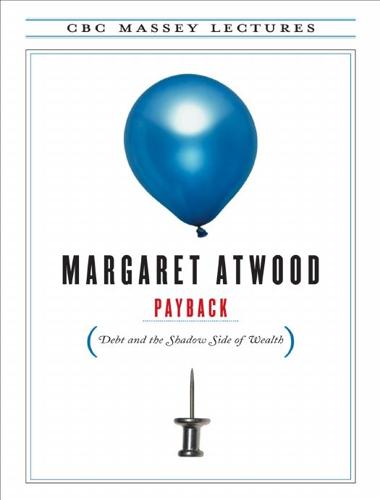
Payback: Debt and the Shadow Side of Wealth
by
Margaret Atwood
Published 15 Mar 2007
In order for a mental construct such as “debt” to exist — you owe me something that will balance the books once it is transferred to me — there are some preconditions. One of them, as I’ve said, is the notion of fairness. Attached to that is the notion of equivalent values: what does it take to make both sides of the mental score sheet or grudge tally or double-entry bookkeeping program we’re all constantly running add up to the same thing? If Johnny has three apples and Suzie has a pencil, is one apple for one pencil an acceptable exchange, or will there be an apple or a pencil remaining to be paid? That all depends on what values Johnny and Suzie place on their respective trading items, which in turn depend on how hungry and/or in need of communication devices they may be.
…
This book was put on trial for obscenity, and Flaubert defended it by brandishing Emma’s hideous-looking corpse as an example of the book’s inherent morality — the wages of sexual sin is arsenic, and not only does it kill you, it wrecks your looks — but that’s a red herring. Emma isn’t really punished for sex but for shopaholicism. Had she but learned double-entry bookkeeping and drawn up a budget, she could easily have gone on with her hobby of adultery forever — or at least until she got saggy — though she’d have done it in a more frugal manner. Or perhaps we should cross the Atlantic and trace the pitiful career of Lily Bart in Edith Wharton’s House of Mirth, who, had she known more about debt management, need not have ended up similarly selfpoisoned.
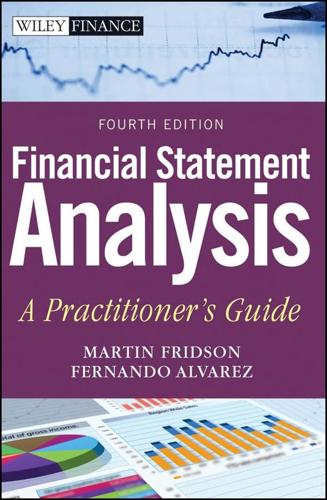
Financial Statement Analysis: A Practitioner's Guide
by
Martin S. Fridson
and
Fernando Alvarez
Published 31 May 2011
Form Type: 10-K Filed On: 9/11/2009 Years Ended July 25, 2009 Cash flows from operating activities: Net income $6,134 Adjustments to reconcile net income to net cash provided by operating activities: Depreciation, amortization, and other noncash items 1,768 Employee share-based compensation expense 1,140 Share-based compensation expense related to acquisitions and investments 91 Provision for doubtful accounts 54 Deferred income taxes (574) Excess tax benefits from share-based compensation (22) In-process research and development 63 Net losses (gains) on investments 80 Change in operating assets and liabilities, net of effects of acquisitions: Accounts receivable 610 Inventories 187 Lease receivables, net (222) Accounts payable (208) Income taxes payable and receivable 768 Accrued compensation 175 Deferred revenue 572 Other assets (780) Other liabilities 61 Net cash provided by operating activities 9,897 Cash flows from investing activities: Purchases of investments (41,225) Proceeds from sales of investments 20,473 Proceeds from maturities of investments 12,352 Acquisition of property and equipment (1,005) Acquisition of businesses, net of cash and cash equivalents acquired (426) Change in investments in privately held companies (89) Other (39) Net cash used in investing activities $(9,959) Cash flows from financing activities: Issuance of common stock 863 Repurchase of common stock (3,611) Issuance of long-term debt 3,991 Repayment of long-term debt (500) Settlement of interest rate derivatives related to long-term debt (42) Excess tax benefits from share-based compensation 22 Other (134) Net cash provided by (used in) financing activities 589 Net increase in cash and cash equivalents 527 Cash and cash equivalents, beginning of fiscal year 5,191 Cash and cash equivalents, end of fiscal year 5,718 Prior to that time, going as far back as the introduction of double-entry bookkeeping in Italy during the fifteenth century, financial analysts had muddled through with only the balance sheet and the income statement. Anyone with a sense of history will surely conclude that the introduction of the cash flow statement must have been premised by expectations of great new analytical insights.
…
Applied to corporate strategy, the term refers to participation in several unrelated businesses. The underlying premise is often countercyclicality, or the stabilization of earnings over time through the tendency of profits in certain business segments to be rising at times when they are falling in others. double-entry bookkeeping. A system of keeping accounts in which each entry requires an offsetting entry. For example, a payment to a trade creditor causes both cash and accounts payable to decline. Dow Jones Industrial Average. A widely followed index of the U.S. stock market composed of the common stocks of 30 major industrial corporations.
…
Tice Associates Death duties Debt: management's attitude toward return on equity and total, constitution of total-debt-to-cash-flow ratio Debt restriction disclosures Declining growth, rationalizations: diversification, mature markets and growth back on track, new products and year-over-year comparisons distorted Defaulting on debt Default risk models Deferred profit plan: accounting discrepancies background on from bad to worse lessons learned Deferred taxes, capital and Denari, Stephen Depreciation schedules Derivatives Dex One Corporation Dilution Disclosure/audits: artful deal death duties generally systematic problems, auditing and Discount rate Discretionary uses of cash Diversification Dividend discount model: dividends and future appreciation earning or cash flow future dividends/present stock price growing company, valuing Dividends Dooner, John J. Double-entry bookkeeping Dow Jones Industrial Average Downgrading of debt Drug business. See Channel-stuffing Dunn, Frank Du Pont formula, equity analysis and Dynegy Earnings: manipulation or cash flow, dividend discount model rainy day reserves and second take on Earnings multiple. See Price-earnings ratio (P/E ratio) Earnings per share (EPS) Earnings-smoother EBITDA: EBIT, total enterprise value and peer-group multiple based on predictability of, near term restructuring and EBITDA, applications/limitations: abusing EBITDA cash flow, more comprehensive measure credit analysis and EBIT, total enterprise value and generally working capital and Economic conditions, volatility and Economies of scale Economies of scope Elkind, Peter Energy, economic conditions and Enforcement Division Enron: media sensation: analysts, fraud detection and company background lessons learned magazines/books and misleading of investors EPS.
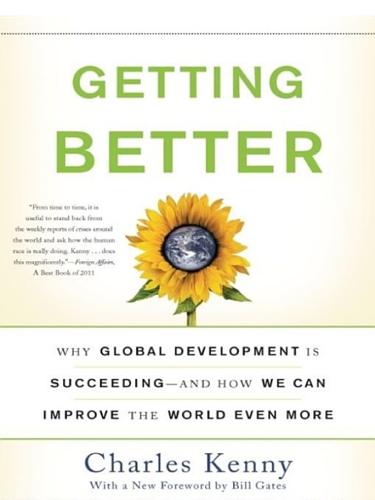
Getting Better: Why Global Development Is Succeeding--And How We Can Improve the World Even More
by
Charles Kenny
Published 31 Jan 2011
Economists define “technology” broadly—as anything that isn’t capital that might affect per-worker growth rates. For example, it can include inventions as usually imagined, like the steam engine or the transistor, but also new processes, like the assembly line, or new ways of doing business, like double-entry bookkeeping. Solow suggested that as these technologies spread across countries, workers and capital could be used more effectively to produce goods and services. This, he argued, was the secret to growth. He also assumed that technology spread across countries at a constant rate. So, every year, the gap between advanced and backward countries in terms of technological prowess shrank by a similar amount.
…
In such a system, Smith estimated that each small manufactory could make upward of forty-eight hundred pins per person, where one unskilled worker alone could make a single pin a day. The vital technology here is a “process” technology—the assembly line. Other such process technologies—a.k.a. institutions—might include double-entry bookkeeping, just-in-time management systems, transparent regulation, or even democracy. Paul Romer, a father of “endogenous” theories that emphasize barriers to technology adoption as the reason for slow growth, suggests that it is process technologies that are the key to the story. He argues that systems like Walmart’s management of inventory data have had a bigger impact on economic growth than inventions such as the transistor, for example.
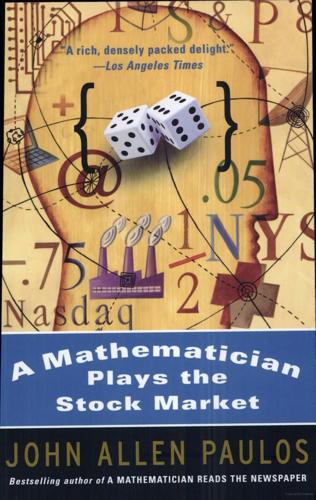
A Mathematician Plays the Stock Market
by
John Allen Paulos
Published 1 Jan 2003
Are these assumptions warranted? Once the assumptions are made and the model is adopted, however, the numbers and organizational clarity that result have an irresistible appeal. Responding to this appeal two hundred years ago, the German poet Goethe rapturously described accounting this way: “Double entry bookkeeping is one of the most beautiful discoveries of the human spirit.” Focusing only on the bookkeeping and the numerical output, however, and refusing to examine the legitimacy of the assumptions made, can be disastrous, both in mathematics and accounting. Recall the tribe of bear hunters who became extinct once they became expert in the complex calculations of vector analysis.
…
Brian auditors Aumann, Robert availability error average values compared with distribution of incomes risk as variance from averages average return compared with median return average value compared with distribution of incomes buy-sell rules and outguessing average guess risk as variance from average value averaging down Bachelier, Louis Bak, Per Barabasi, Albert-Lazló Bartiromo, Maria bear markets investor self-descriptions and shorting and distorting strategy in Benford, Frank Benford’s Law applying to corporate fraud background of frequent occurrence of numbers governed by Bernoulli, Daniel Beta (B) values causes of variations in comparing market against individual stocks or funds strengths and weaknesses of technique for finding volatility and Big Bang billiards, as example of nonlinear system binary system biorhythm theory Black, Fischer Black-Scholes option formula blackjack strategies Blackledge, Todd “blow up,” investor blue chip companies, P/E ratio of Bogle, John bonds Greenspan’s impact on bond market history of stocks outperforming will not necessarily continue to be outperformed by stocks Bonds, Barry bookkeeping. see accounting practices bottom-line investing Brock, William brokers. see stock brokers Buffett, Warren bull markets investor self-descriptions and pump and dump strategy in Butterfly Economics (Ormerod) “butterfly effect,” of nonlinear systems buy-sell rules buying on the margin. see also margin investments calendar effects call options. see also stock options covering how they work selling strategies valuation tools campaign contributions Capital Asset Pricing Model capital gains vs. dividends Central Limit Theorem CEOs arrogance of benefits in manipulating stock prices remuneration compared with that of average employee volatility due to malfeasance of chain letters Chaitin, Gregory chance. see also whim trading strategies and as undeniable factor in market chaos theory. see also nonlinear systems charity Clayman, Michelle cognitive illusions availability error confirmation bias heuristics rules of thumb for saving time mental accounts status quo bias Cohen, Abby Joseph coin flipping common knowledge accounting scandals and definition and importance to investors dynamic with private knowledge insider trading and parable illustrating private information becoming companies/corporations adjusting results to meet expectations applying Benford’s Law to corporate fraud comparing corporate and personal accounting financial health and P/E ratio of blue chips competition vs. cooperation, prisoner’s dilemma complexity changing over time horizon of sequences (mathematics) of trading strategies compound interest as basis of wealth doubling time and formulas for future value and present value and confirmation bias definition of investments reflecting stock-picking and connectedness. see also networks European market causing reaction on Wall Street interactions based on whim interactions between technical traders and value traders irrational interactions between traders Wolfram model of interactions between traders Consumer Confidence Index (CCI) contrarian investing dogs of the Dow measures of excellence and rate of return and cooperation vs. competition, prisoner’s dilemma correlation coefficient. see also statistical correlations counter-intuitive investment counterproductive behavior, psychology of covariance calculation of portfolio diversification based on portfolio volatility and stock selection and Cramer, James crowd following or not herd-like nature of price movements dart throwing, stock-picking contest in the Wall Street Journal data mining illustrated by online chatrooms moving averages and survivorship bias and trading strategies and DeBondt, Werner Deciding What’s News (Gans) decimalization reforms decision making minimizing regret selling WCOM depression of derivatives trading, Enron despair and guilt over market losses deviation from the mean. see also mean value covariance standard deviation (d) variance dice, probability and Digex discounting process, present value of future money distribution of incomes distribution of wealth dynamic of concentration UN report on diversified portfolios. see stock portfolios, diversifying dividends earnings and proposals benefitting returns from Dodd, David dogs of the Dow strategy “dominance” principle, game theory dot com IPOs, as a pyramid scheme double-bottom trend reversal “double-dip” recession double entry bookkeeping doubling time, compound interest and Dow dogs of the Dow strategy percentages of gains and losses e (exponential growth) compound interest and higher mathematics and earnings anchoring effect and complications with determination of inflating (WCOM) P/E ratio and stock valuation and East, Steven H.

Confessions of a Crypto Millionaire: My Unlikely Escape From Corporate America
by
Dan Conway
Published 8 Sep 2019
The FAANG companies (Facebook, Apple, Amazon, Netflix, and Google) have made it a gated community. Blockchain is an opportunity to organize in a different way. It has the potential to weaken the gatekeepers, rule makers, and monopolies through decentralization. In the years and decades ahead, it gives us a shot to revolutionize institutions the way double-entry bookkeeping did seven hundred years ago. And it might let outsiders like me storm the castle. Now, to the fucking money. My story involves large sums of money. When the boom was on, I felt like Pablo Escobar, with a chirpy attitude and a closet full of dad jeans. But my story is messy and unconventional.
…
Techcrunch summed up the revolutionary potential of Ethereum in the article “Business in the Age of Ethereum”: “Blockchain technology provides a platform for people to work together with the persistence and stability of an organization but without the hierarchy.” In an article titled “Disrupting the Trust Business,” The Economist placed this invention in its historical context: “If double-entry bookkeeping freed accounting from the merchant’s head, the blockchain frees it from the confines of an organisation.” Eventually, over time, as The Economist asserts, “Some companies could be no more than a bundle of smart contracts, forming true virtual firms that live only on a blockchain.” Chapter Seven Taking the Edge Off It was clear that this job was more difficult than I’d imagined it would be.
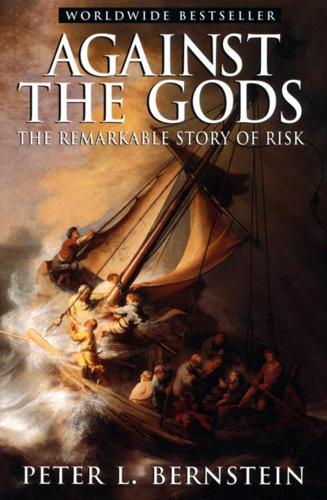
Against the Gods: The Remarkable Story of Risk
by
Peter L. Bernstein
Published 23 Aug 1996
The Summa sets out the basic principles of algebra and contains multiplication tables all the way up to 60 x 60-a useful feature at a time when printing was spreading the use of the new numbering system. One of the book's most durable contributions was its presentation of double-entry bookkeeping. This was not Paccioli's invention, though his treatment of it was the most extensive to date. The notion of double-entry bookkeeping was apparent in Fibonacci's Liber Abaci and had shown up in a book published about 1305 by the London branch of an Italian firm. Whatever its source, this revolutionary innovation in accounting methods had significant economic consequences, comparable to the discovery of the steam engine three hundred years later.
…
In 1654, a time when the Renaissance was in full flower, the Chevalier de Mere, a French nobleman with a taste for both gambling and mathematics, challenged the famed French mathematician Blaise Pascal to solve a puzzle. The question was how to divide the stakes of an unfinished game of chance between two players when one of them is ahead. The puzzle had confounded mathematicians since it was posed some two hundred years earlier by the monk Luca Paccioli. This was the man who brought double-entry bookkeeping to the attention of the business managers of his day-and tutored Leonardo da Vinci in the multiplication tables. Pascal turned for help to Pierre de Fermat, a lawyer who was also a brilliant mathematician. The outcome of their collaboration was intellectual dynamite. What might appear to have been a seventeenth-century version of the game of Trivial Pursuit led to the discovery of the theory of probability, the mathematical heart of the concept of risk.
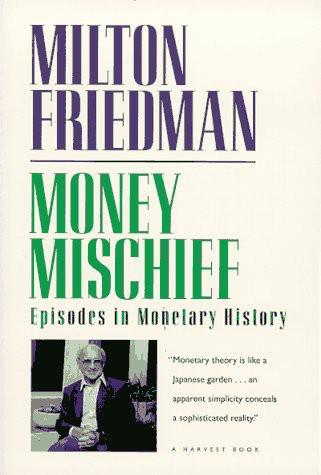
Money Mischief: Episodes in Monetary History
by
Milton Friedman
Published 1 Jan 1992
Every purchase can be viewed in two ways: the amount of money spent and the quantity of a good or service purchased multiplied by the price paid. Entering the amount of money on the left side and quantity times price on the right, and adding up those sums for all purchases, we have a standard case of double-entry bookkeeping. As in double-entry bookkeeping in general, the truism is highly useful. Consider once more our original question: What determines how much you can buy with the greenbacked five-dollar bill we started with? Nothing can affect P except as it changes one or more of the other items in the equation. Will a boom in the stock market, for example, change how much you can buy with a five-dollar bill?
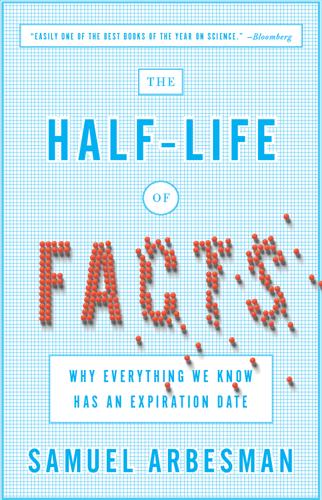
The Half-Life of Facts: Why Everything We Know Has an Expiration Date
by
Samuel Arbesman
Published 31 Aug 2012
CHAPTER 10 At the Edge of What We Know AN Italian Franciscan monk named Luca Pacioli wrote a book on mathematics in the late fifteenth century. This textbook, Summa de arithmetica, geometria, proportioni et proportionalita, was one of the earliest books published after the advent of the printing press. While focusing on algebra and other aspects of math, there also was a significant section on accounting. Pacioli chronicled double-entry bookkeeping—entering each entry twice, both as a debit and a credit, in order to reduce errors—which was the first time this method had been codified in print. This error-checking methodology, which was being used by Italian merchants, finally could be spread far and wide. Mary Poovey, an English professor at New York University and the author of the monograph History of the Modern Fact, has argued that the modern conception of the fact, with its notion of objective reality that often goes hand in hand with a certain quantifiable quality, was first seen during the Middle Ages.
…
Mary Poovey, an English professor at New York University and the author of the monograph History of the Modern Fact, has argued that the modern conception of the fact, with its notion of objective reality that often goes hand in hand with a certain quantifiable quality, was first seen during the Middle Ages. Specifically, Poovey identified the “invention” of the fact with the advent of double-entry bookkeeping. Only with the introduction of this methodology in the fifteenth century or so, Poovey argued, did humans become accustomed to thinking in terms of bits of information in quite this way. Of course, this doesn’t quite ring true. As humans we have been chronicling pieces of knowledge for millennia, if sometimes with a bit less objective mathematical truth than that found in a ledger.

Money Changes Everything: How Finance Made Civilization Possible
by
William N. Goetzmann
Published 11 Apr 2016
Florentine households and businesses used careful records to track their financial wealth. An Italian monk, friend of Leonardo da Vinci, mathematician, and the “father” of accounting, Lucca Pacioli published his most famous work of mathematics in 1494. Although much of the book was devoted to geometry, one section described the “Italian” technique of double-entry bookkeeping—a seemingly prosaic topic compared to the other subjects in his treatise. Yet this section immortalized Pacioli. Pacioli based his bookkeeping method on a journal, a documentary record through time of the monetary inflows and outflows of the business. Each transaction is captured by two entries—a debit from one account and a credit to another.
…
Each transaction is captured by two entries—a debit from one account and a credit to another. Debits and credits thus track the progress of the business through time, and they must balance each other when the accounts are periodically settled up—or else a mistake has been made. The genius of double-entry bookkeeping is that it was a means to reduce errors in documentation. But it also has a subtle effect. Once you begin to use it, you start to think of the world in terms of accounts. A household is not only a family, it is a sequence of expenses and periodic income. Even a soul can be envisioned as an account, with sins and penance needing to be totaled before passing on.
…
The following illustrations are from the author’s private collection: PARTS I and IV CHAPTERS 7, 8, 11, 12, 21, and 23 FIGURES 2, 14, 15, 17, 19, and 22 INDEX abacus, 83, 248 abacus schools, 246, 248. See also Liber Abaci (Fibonacci) abstract thought, monetization leading to, 95 abstract (intangible) wealth: in ancient Greece, 81, 82, 90; in second-millennium Ur, 51 accounting: in ancient Near East, 27–28; Chinese tools for, 199, 200, 201, 272; double-entry bookkeeping in, 246–47; by Templars, 211; Zhouli on, 173 Adams, Samuel: father of, 387, 388 Aeschylus, 87 agency problem, 167, 169; Chinese Legalism and, 170; incentives and, 171–72, 174; modern economic theory on, 171–72, 188; monitoring and, 167, 169, 171, 172–74; with publicly owned corporation, 303 agricultural societies: of ancient Near East, 21, 27, 30, 69; idea of interest in, 44 Aida (Verdi), 419, 420 Akkadian, 46, 49 Alexander the Great, 69–70 al-Khwārizmi, 241 Allen, Robert, 198 alternative use of capital: money fief and, 243; return on investment and, 237 American Bond & Mortgage Company, 478 American Revolution: Chinese revolution of 1911 and, 437; Dutch and French investors in financing of, 386, 390; land-backed certificates for veterans of, 394; land speculation and, 388–90, 399 Amiet, Pierre, 25 Amsterdam: The Great Mirror of Folly printed in, 375; insurance business in, 365, 366; negotiatie of 1774 floated in, 384–85 Amsterdam Exchange, 317–18 Anatolia: Mesopotamian trade with, 59, 60, 61, 64; Roman taxes imposed on, 123 Andersson, J.
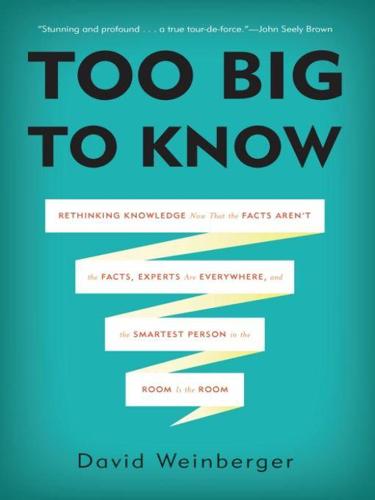
Too Big to Know: Rethinking Knowledge Now That the Facts Aren't the Facts, Experts Are Everywhere, and the Smartest Person in the Room Is the Room
by
David Weinberger
Published 14 Jul 2011
For our ancestors, knowledge was of universals—not of facts about this or that cat. The idea that knowledge was a slew of facts about particulars would have struck them as a misuse of our God-given instrument. So what happened in the nineteenth century to make facts the bedrock of knowledge? The path is twisty. Mary Poovey cites the invention in Italy of double-entry bookkeeping, which in the sixteenth century provided a process by which ledger entries could be proved accurate to anyone who, regardless of status, followed the proper procedure. 11 But most historians look to the seventeenth century, when the philosopher and statesman Francis Bacon, seeking to put knowledge on a more certain basis, invented the scientific method.
…
See Science at Creative Commons Crick, Francis Crisis of knowledge CrisisCommons.org Crowds Crowdsourcing information amateur scientists British Parliamentarians’ use of expertise and leadership effectiveness Netflix contest open-notebook science Culture, information overload and Cybercascades Cyberchiefs: Autonomy and Authority in Online Tribes (O’Neil) Darnton, Robert DARPA (Defense Advanced Research Projects Agency) Darwin, Charles amateur scientists’ contributions barnacle studies Hunch.com and insight and leap of thought long-form thinking science and publishing Data accuracy of published data crowdsourcing scientific and medical information data commons evaluating metadata information and overaccumulation of scientific data scientific knowledge Data.gov Data-information-knowledge-wisdom (DIKW) hierarchy Davis, John Debian Decision-making advantages of networked corporate and government networked decision-making Debian community Dickover’s social solutions facing reality Wikipedia policy Defaults Democracy echo chambers hiding knowledge and increasing group polarization reason, truth, and knowledge Denney, Reuel Deolalikar, Vinay Derrida, Jacques Descartes, René Dialogue, exploring diversity through Dickens, Charles Dickover, Noel Diderot, Denis The Difference (Page) Discourses Diversity appropriate scoping decreasing intelligence echo chambers forking moderating negative effects of of expertise race and gender respectful conversations over DNA Dr. Strangelove, Or How I Learned to Stop Worrying and Love the Bomb (film) Doctorow, Cory Dogger Bank Incident The Double Helix (Watson) Double-entry bookkeeping Dublin Core standard Dwarf planets eBird.org E-books Echo chambers Edge.org Ehrlich, Paul Einstein@Home Eliot, T.S. Embodied thought Emerson, Ralph Waldo Enders, John Engadget Environmental niche modeling Environmental Protection Agency (EPA) Eureqa computer program Evolutionary science Experiments, scientific method and Expert Labs Expertise Challenger investigation crowdsourcing diversity in networking knowledge networks outperforming individuals professionalization of scaling knowledge and networking sub-networks Extremism: group polarization Exxon Valdez oil disaster Facebook Fact-based knowledge as foundation of knowledge British backlash against British chimney sweep reform Darwin’s work on barnacles Hunch.com international dispute settlement See also Data Fact-finding missions Facts Linked Data standard Malthusian theory of population growth networked Failed science Fear, information overload and Federal Advisory Committees (FACs) Federal Highway Administration Feminism Filters information overload as filter failure knowledge management FoldIt Food, extending shelf life of Foodies Ford Motors Forking Forscher, Bernard K.
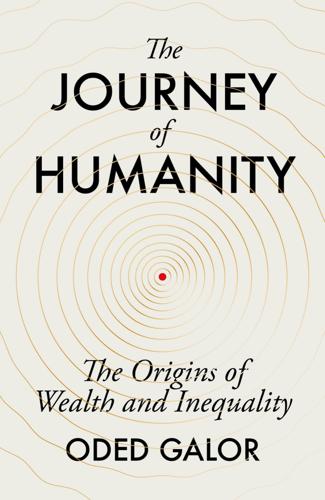
The Journey of Humanity: The Origins of Wealth and Inequality
by
Oded Galor
Published 22 Mar 2022
In the second half of the fifteenth century, Europe printed nearly 13 million copies of books; in the sixteenth century, over 200 million; in the seventeenth century over half a billion copies; and in the eighteenth century that number soared to approximately one billion copies of books – a growth rate far exceeding that of the population on the continent.[10] What is also apparent is that the rapid growth of the European book industry spurred further technological and cultural change, which in turn contributed to the enhancement of human capital formation. The late fifteenth century saw the mass printing of ‘commercial mathematics’ textbooks, written to teach trainee merchants how to price their stocks, convert currencies, and calculate profit margins and interest payments. Others disseminated the essential discipline of double-entry bookkeeping, an innovation that allowed merchants to manage their accounts rationally and professional textbooks proliferated across the European continent and became an indispensable source of knowledge for doctors, lawyers and teachers. Not surprisingly, therefore, cities that embraced the printing press in the late fifteenth century experienced greater population growth, predominantly due to inward migration, and became major hubs of intellectual thought and literature, further promoting literacy as a noble pursuit for respectable citizens and as a virtue in its own right.[11] During this period, Europe became the most literate and technological place in history.
…
A B C D E F G H I J K L M N O P Q R S T U V W X Y Z A Abbasid Caliphate (750–1258), 176, 184 abortion, 87–8 Aeneid (Virgil), 59 aeroplanes, 111 Africa agriculture in, 21, 179–80, 188–9 colonialism in, 157, 158, 187 diversity in, 220–32 emigration from, 127 fertility rates in, 112 Homo sapiens emergence in, 5, 18–20, 30, 119, 120, 124, 218–32, 221, 222, 237 income per capita in, 106 industrialisation in, 241 institutions in, 157, 187 livestock in, 179–80 living standards in, 7 malaria in, 180 marriage in, 87 Neolithic Revolution in, 202, 203, 204, 207 poverty in, 113 slave trade in, 173–4, 187 trade in, 136 trust in, 173–4 tsetse flies, 180 African Americans, 130–31, 155, 156, 215–17 Afrobarometer 173–4 Age of Enlightenment (c.1637–1800), 27, 58, 66, 170–71, 182, 212 agriculture climate and, 13, 15, 20, 21, 25, 155, 181, 186–7, 193–5, 203–4 comparative advantage in, 181, 211–12, 237 cooperation and, 168–9 diseases and, 8, 180 education and, 77, 81–3, 109, 140 future orientation and, 187–90, 213 gender roles and, 191–2 Green Revolution, 111, 117 hydraulic hypothesis, 184 innovations in, 61, 64, 181 institutions and, 208–10 irrigation, 22, 23, 120, 141–2, 160, 168, 184, 190 labour productivity, 131–2 livestock, 179–80, 203 Neolithic Revolution, see Neolithic Revolution soil and, 8, 21, 30, 141, 155, 186, 187, 191, 198, 204, 209, 236 Akkadian Empire (c.2334–2154 BCE), 23 algebra, 69 altitude, 51 American Civil War (1861–5), 62 Amsterdam, Netherlands, 40 Anatolia, 23, 40, 206 Angola, 154 antibiotics, 111 Aquinas, Thomas, 163 Arabian Nights, 59 Arctic region, 195 Argentina, 77, 154 Arkwright, Richard, 59, 72 Arrow, Kenneth, 172 art, 20, 22, 58, 62, 120, 216 Asia agriculture in, 188, 192 East–West orientation, 203 fertility rates in, 112 income per capita in, 106 industrialisation in, 241 living standards in, 7 marriage in, 87 Neolithic Revolution in, 202, 203 trade in, 136 see also Middle East Assyrian Empire (2500–609 BCE), 40 Athens, 40 Atlantic triangular trade, 136 Australia, 49, 106, 153, 154, 157 Austronesians, 206–7 automobiles, 61, 97, 101, 107, 111 Aztec civilisation, 154, 205 B Bab-el-Mandeb Strait, 19 Babylonian Empire (1895–539 BCE), 40 Bandy, Robert, 217 Banfield, Edward, 172 Bantu people, 207 Battle of the Books, The (Swift), 169 Belgium, 37, 64, 65, 72, 75, 138 Bell, Alexander Graham, 104 Berry, Charles ‘Chuck’, 216 Bessemer, Henry, 60 bicycles, 61 bifurcation theory, 46 Bill of Rights (1689), 148 biodiversity, 9, 29, 33, 202, 210, 236 Black Death (1346–53), 34–5, 36, 149–50, 159, 212 Blake, William, 57 Boas, Franz, 168 Bolivia, 131, 154, 229 Boserup, Ester, 191 brain, 14–17 Brazil, 103, 154, 216 Brexit (2016–20), 110 Brown, Moses, 72 Brown University, 1, 72, 239 Buddhism, 63 Byzantine Empire (395–1453), 48 C Caesar, Julius, 184 caloric yields, 189 Calvinism, 164 Cameroon, 207 Canada, 77, 108, 138, 154 canals, 61 Card, Addie, 78 cargo cults, 233–4 Caribbean, 113, 154, 155, 157, 186 Carthage, 23 Cartwright, Edmund, 59 Çatalhöyük, 23, 40 Catholicism, 148, 163, 217 Central America, see under Meso-America central heating, 101 centralised civilisations, 182–7 cephalopods, 14 de Cervantes, Miguel, 59 Chaplin, Charles, 105 Charlemagne, Emperor of the Romans, 184 Charles II, King of England and Scotland, 148 chemistry, 61, 69 Chicago, Illinois, 60 childbirth, 2, 41, 83 children education of, 8, 52–5, 62–83, 88–91, 94–8, 122, 129, 175 labour of, 57, 67, 78–83, 89, 93, 99, 122 mortality of, 2, 29, 41, 57, 89, 98, 121, 127, 128, 180 quantity–quality trade-off, 52–5, 88–91 Chile, 77, 146, 154 China agricultural productivity, 131 Black Death in (c. 1331–54), 34 centralised authority in, 182, 183, 184–6 coal mining in, 181 collectivism in, 190 dictatorship in, 146 diversity and, 226–9 education in, 64, 91 fertility rates in, 91 geography of, 182 growth in, 115 gunpowder, development of, 47, 61 income per capita in, 210 industrial regions, 108 naval exploration, 213 Neolithic Revolution in, 3, 21, 23, 122, 206, 210 New World crops in, 37–9 one-child policy (1979–2015), 112 Opium War, First (1839–42), 61 poverty in, 113, 114 printing, development of, 48 technological development in, 121, 176, 184 writing development of, 24 cholera, 205 Christianity, 63 Catholicism, 148, 163, 217 Protestantism, 63, 90, 163–4, 175, 184, 217 wealth, views on, 163 civil law systems, 154 civil liberties, 127 civilisations, dawn of, 22–5, 208–10, 236 class conflict, 73, 74, 78 climate, 13, 15, 20, 21, 25, 155, 181, 186–7, 193–5, 203–4 climate change, 116–18, 123, 241 coal mining, 59, 60, 71, 181 Cobbett, William, 86 Collapse (Diamond), 33 Colombia, 154 colonialism, 135–7, 140, 147, 152–9, 168, 175, 205, 235 Columbia, 103 Columbian Exchange, 35–9, 94–6, 195 Columbus, Christopher, 35, 47, 182–3 Comenius, John Amos, 65 common law systems, 154 Communist Manifesto, The (Marx and Engels), 62, 73 comparative advantage, 71, 137, 140, 141, 211–12 competition, 182–6, 198 concrete, 61 de Condorcet, Nicolas, 27 Confucianism, 63 consumption vs investment strategy, 188–90, 213 contraception, 85–6, 118 convergent evolution, 14–15 cooking, 15, 17 cooperation, 8, 168–9, 175, 236 Copernicus, Nicolaus, 44 Corinth, 40 Cortés, Hernán, 205 Covid-19 pandemic, 115, 130, 240 Crime and Punishment (Dostoevsky), 59 critical junctures, 212 Crompton, Samuel, 59 Cuba, 216 Cuitláhuac, Emperor of Tenochtitlan, 205 cultural traits, 51–5, 141, 161, 163–77, 187–98, 213 collectivism, 190–91 cooperation, 8, 168–9, 175, 236 entrepreneurship, 52, 72, 165, 182, 184, 193, 197 future orientation, 52, 141, 165, 169–71, 175, 187–90, 197–8, 213, 238 gender equality, see gender equality geography and, 181, 187–90, 208–10, 236 growth and, 169–71 human capital investment, 52–5, 80, 88–91, 94–8, 122, 165, 175 immigration and, 174 individualism, 165, 176, 190–91, 197 institutions and, 182 language and, 195–8 loss aversion, 192–5 prosperity and, 174–7 Protestant ethic, 164–5, 175, 184 racism and, 168 social hierarchies, 197 survival advantage of, 168 technology and, 52–5, 121, 169–70, 176, 231 transmission of, 171 trust, 8, 165, 172–4, 175, 236 Cyprus, 40 D Dante, 59 Darby, Abraham, 60 Darwin, Charles, 27, 50 decline of generations, 169 deindustrialisation, 107–10, 139, 140 democracy, 78, 151–2, 155, 160, 172–3 social capital and, 172–3 demographic dividend, 117 demographic transition, 6, 85–100, 106, 112–18, 175, 176, 198, 240 human capital and, 88–91, 112, 175, 211 Denmark, 104 Detroit, Michigan, 107–8, 217 Diamond, Jared, 21, 29, 32–3, 202, 203 Dickens, Charles, 57 dictatorships, 146 see also extractive institutions diet, 2, 25, 28, 30, 33, 95, 101, 107 diphtheria, 102 diseases, 2, 8, 40, 94, 102, 204–5, 236 agriculture and, 8, 180 Black Death (1346–53), 34–5, 36, 149–50, 159, 212 colonialism and, 156–7 germ theory, 102 immunity to, 51, 205 malaria, 156, 180, 205 sleeping sickness, 180 Spanish flu pandemic (1918–20), 106, 240 vaccinations, 102 diversity, 6, 9, 19, 142, 160, 215–32, 227–8, 237 innovation and, 9, 215–16, 226–30 measurement of, 223–4 origins of, 219–22 prosperity and, 217–18, 222, 224–32 Divine Comedy (Dante), 59 division of labour, 22, 191–2, 196–7, 204 Domino, Fats, 216 Don Quixote (Cervantes), 59 Dostoevsky, Fyodor, 59 double-entry bookkeeping, 65 E East Germany (1949–90), 144 Easter Island, 32, 207 economic ice age, 39–41 Edison, Thomas, 60, 104 Education Act (UK, 1902), 76 education, 8, 52–5, 62–83, 88–98, 99, 118, 129, 238 agriculture and, 77, 81–3, 109, 140 child labour and, 57, 67, 78–83, 122 fertility rates and, 89–98, 99, 113, 122 human capital, see human capital industrialisation and, 64, 67–83, 89, 99, 109, 140 inequality and, 127, 140 investment in, 52–5, 80, 88–91, 94–8, 122, 165 land ownership and, 77, 155 technology and, 62–83, 99, 109, 110, 111–12 trade and, 137 universal public, 73–9 women and, 91, 92, 112 Egypt, 3, 20, 23, 24, 40, 63, 87, 88, 121, 207 Einstein, Albert, 44 electricity, 61, 101, 129, 130, 144 elevators, 61 Elizabeth I, Queen of England, 147 Engels, Friedrich, 27, 62, 73 England, 3, 35, 37, 91, 147 Enlightenment (c.1637–1800), 27, 58, 66, 170–71, 182, 212 entrepreneurship, 52, 72, 165, 182, 184, 197 environmental degradation, 116–18, 241 Epic of Gilgamesh, 59 Ethiopia, 131, 229 Euphrates River, 20, 23, 206, 236 Europe income per capita, 106 industrialisation, see industrialisation institutions see institutions living standards in, 7, 41 Neolithic agriculture in, 35–7, 94–6, 188, 190, 192 Black Death (1346–53), 34–5, 36, 149–50, 159, 212 colonialism, 135–7, 140, 147, 152–9, 168, 175 competition in, 182–3, 184 East–West orientation, 203 economic growth in, 115 education in, 64–7 Enlightenment (c.1637–1800), 27, 58, 66, 170–71, 182, 212 fertility rates in, 85–6, 122 future orientation in, 190, 213 gender equality in, 92 geography of, 184–5 immigration to, 127, 192 Revolution in, 202, 203 New World crops in, 35–7, 94–6, 190 Protestant ethic in, 164–5, 175, 184 technological development in, 58, 61–2, 97, 212 trade in, 135–7 European Marriage Pattern, 86 European Miracle, 182, 213 European Social Survey, 189, 194 European Union (EU), 110 extinctions, 32, 88, 116, 167, 193, 203 extractive vs inclusive institutions, 145–61, 172, 186–7, 198, 209, 236 eye, evolution of, 14, 51 eyeglasses, 64 F Factory Acts (UK), 80 famines, 29, 40, 102, 193 Irish Famine (1845–9), 37, 96 Faust (Goethe), 59 feedback loops, 17, 48 feminism, 97 Ferdinand II, King of Aragon, 183 Fertile Crescent, 20, 21, 23, 33, 40, 48, 122, 202–4, 206, 210, 214, 226 fertility rates, 6, 85–98, 87, 112, 113, 117–18, 122, 123, 232 trade and, 137–8 feudalism, 62, 73, 147, 149–50, 159, 172 film, 105 financial crisis (2008), 115 Finland, 40 Florence, Italy, 34 food surpluses, 4, 28–41, 85, 94, 95 Ford, Henry, 107 France Black Death in, 34 colonialism, 153, 154 education in, 64, 67, 68, 70–71, 72, 75, 147 fertility rates in, 90 geography of, 185 guilds in, 150 industrialisation in, 109, 110, 138 late blight in, 37 life expectancy in, 40 living standards in, 147 Napoleonic Wars (1803–15), 62, 146, 153 Protestantism in, 164 trade in, 137 Fresnes-sur-Escaut, France, 70 future orientation, 52, 141, 165, 168–71, 175, 187–90, 197–8, 213, 236, 238 G Ganges River, 236 Gates, William ‘Bill’, 118 gender equality, 8, 91–4, 99, 106, 118, 122, 236 geography and, 191–2 language and, 196–7 wage gap, 91–4, 99, 122 general relativity, theory of, 44 General Social Survey, 194 Genoa, Republic of (c. 1000–1797), 183 geography, 179–99, 236 competition and, 182–6 future orientation and, 187–90, 197–8, 213 gender equality and, 191–2 individualism in, 190–91 institutions and, 181, 182, 186–7, 207, 208–10 language and, 195–8 loss aversion and, 192–5 Neolithic Revolution and, 203–4, 208–10, 212–14 geometry, 69 germ theory, 102 Germany, 64, 67, 75, 93, 110, 112, 137, 138, 164, 197 glass, 61 global warming, 116–18, 123 globalisation, 115, 137, 235 Godwin, William, 27 Goethe, Johann Wolfgang von, 59 Goldin, Claudia, 111 grass analogy, 140–42 Great Depression (1929–39), 106, 115, 240 Great Fire of London (1666), 150 Great Migration (1916–70), 215 Great Pyramid, Giza, 24 Greece, 3, 18, 23, 40, 48, 58, 63, 88, 121, 160, 170, 213 Green Revolution, 111, 117 Greenland, 33, 49 guilds, 150 gunpowder, 47, 61 Guns, Germs and Steel (Diamond), 21 Gutenberg, Johannes, 48–9, 64, 104 H Habsburg Empire (1282–1918), 173 Hamburg, Germany, 34 Hamlet (Shakespeare), 59 hands, evolution of, 17 Hargreaves, James, 59 Hawaii, 48 head starts, 29, 34, 48, 146, 181, 185, 201–2, 204, 206, 210–12, 236–7 agricultural comparative advantage and, 181, 211–12, 237 Hegel, Georg Wilhelm Friedrich, 9 Henry IV, King of France, 147 Henry VII King of England, 183 hierarchical societies, 98, 172, 197, 207, 208–10 high-yield crops, 111, 190, 213 Hill, Rowland, 104 Hine, Lewis, 78 Hobbes, Thomas, 2 Hofstede, Geert, 188 Holy Roman Empire (800–1806), 165, 172, 173 Homo erectus, 18 Homo technologicus, 119 Hong Kong, 154 hookworm, 90 hot-air balloons, 61 Huayna Capac, Incan Emperor, 205 Hugo, Victor, 59, 62 human capital, 6, 52–5, 66–73, 88–91, 93, 103, 111–12, 232 child labour and, 80, 81, 83, 122 colonialism and, 158 demographic transition and, 88–91, 112, 175, 232 dictatorships and, 146 industrialisation and, 66–73, 74, 76, 80, 81, 83, 109, 110, 140, 211 investment in, 52–5, 80, 88–91, 94–8, 122, 165, 175 resource curse and, 181 technology and, 62–83, 99, 109, 110, 111–12 human rights, 127 humanism, 170 Hume, David, 182 hunter-gatherer societies, 6, 17, 18, 20, 21–2, 30, 33–4, 203, 206, 207 hydraulic hypothesis, 184 I Ice Age, 18, 19 immigration, see migration Inca civilisation, 154, 205 inclusive vs extractive institutions, 145–61, 172, 186–7, 198, 209, 236 income effect, 89, 93 income per capita, 4, 8, 31, 102, 106, 109, 117, 122, 130, 131–5 diversity and, 229 future orientation and, 198 inequality, 131–5, 132, 134, 210 institutions and, 155, 160 trade and, 137 India, 23, 111, 112, 113, 131, 138, 154, 210 individualism, 165, 176, 190–91, 197 Indonesia, 154, 207 Industrial Revolution (1760–1840), see industrialisation industrialisation, 6, 45–7, 55, 57–62, 85, 86, 109, 121, 124, 139, 181, 198–9, 240 agriculture and, 181, 202 decline of, 107–10, 139, 140 education and, 64, 66–83, 89, 99, 109, 110, 140, 211 environment and, 116, 123, 241 institutions and, 147–51 skilled labour and, 67, 71, 137 trade and, 136, 138 inequality, 7, 9–10, 44, 74, 106 climate and, 155, 203–4 colonialism and, 135, 137, 140, 152–9, 235 cultural traits and, 163–77 diversity and, 215–32 education and, 127, 140 geography and, 179–99, 203–4 institutions and, 147–61, 172 legal systems and, 154–5 Neolithic Revolution and, 201–14, 236–7 trade and, 135–40 infant mortality, 2, 29, 41, 57, 89, 98, 121, 127, 128, 180 influenza, 205 innovation, 6, 58, 59, 111 age of growth, 111 climate change and, 118, 123 competition and, 184, 186, 198 cooking and, 17 diversity and, 9, 215–16, 226–30 education and, 53, 91, 99 food surpluses and, 4 industrialisation and, 58, 61–2, 65, 83 institutions and, 144, 161 literacy and, 72 Malthusian epoch, 4, 47, 48 Neolithic Revolution, 23, 120, 204 population size and, 47, 48, 120, 204 institutions, 147–61, 172, 175, 182–7, 198, 204, 213 climate and, 155–6 colonialism and, 152—9, 175 competition and, 182–6 democracy, 151–2, 172 geography and, 181, 182, 186–7, 198, 207, 208–10 technology and, 147–51, 176, 231 International Monetary Fund (IMF), 234 International Organization for Standardization, 111 Internet, 101, 111, 130 Inuit, 49, 195—6 invertebrates, 14 investment vs consumption strategy, 188–90, 213 Ireland, 36–7, 91, 94–6, 175 iron ore, 60 irrigation, 22, 23, 120, 141–2, 160, 168, 184, 190 Isabella I, Queen of Castile, 183 Islam, 63 Israel, 2, 13, 18, 201 Italy, 112, 127, 137, 147, 160, 171–3, 185 J Jacquard, Joseph-Marie, 150 James II and VII, King of England and Scotland, 148, 159 Japan, 62, 77, 112, 146, 210, 213, 226, 233 Jericho, 3, 22–3, 24 Jerusalem, 1–2 Jewish people; Judaism, 63, 88–9, 166–7, 169 João II, King of Portugal, 182–3 Joshua ben Gamla, 166 Judaean Revolt (66–70 CE), 166 Judah ha-Nasi, 166 K Kahneman, Daniel, 192 Kant, Immanuel, 170 Karataş, 40 Kay, John, 59 Kenya, 131 kettle analogy, 43, 46, 100 Keynes, John Maynard, 115 Khirokitia, 40 Khoisan, 207 Kitson, James, 75 Korea, 77, 91, 143, 144, 146, 151, 159, 171, 177, 185, 212, 226, 231 L labour productivity, 131 lactase persistence, 24–5 land ownership of, 77, 155 strategies of use, 188–90 see also agriculture landlocked countries, 181 language, 195–8, 221–2 Latin America, see Central America; South America law of diminishing marginal productivity, 133 Lee, William, 147 legal systems, 154–5 Leo X, Pope, 163 Lerna, 40 life expectancy, 2, 41, 57, 89, 99, 102–3, 103, 114, 121, 127, 128, 130 light bulbs, 60 linguistic niche hypothesis, 196 literacy, 2, 63–8, 66, 70–71, 72, 88, 92, 95, 107, 112 Judaism and, 166, 167 Ottoman Empire and, 184 Protestant Reformation and, 90, 164, 165, 167 literature, 58, 59, 62, 216 livestock, 179–80 living standards, 1–10, 28, 94, 99, 101–7, 114, 121–4, 127–31, 240 diversity and, 217–18, 222, 224–32 hunter-gatherer societies, 30, 33 Malthusian thesis and, 3–5, 6, 28–41, 240 London, England, 34, 150 long-term orientation, see future orientation loss aversion, 192–5 lost paradise myth, 34 Lumière brothers, 105 Luther, Martin, 90, 163 Luxembourg, 160 M Madagascar, 207 Madrid, Spain, 40 Mahabharata, 59 maize, 21, 35, 37–9, 190, 203 malaria, 156, 180, 205 Malthus, Thomas, 3–5, 27–30, 50 Malthusian epoch, 3–5, 6, 27–41, 45–7, 83, 85, 99–100, 102, 112, 151, 156, 232 cultural traits and, 52, 54, 89, 94, 95, 97, 98, 188, 193 economic ice age, 39–41 geography and, 181, 188, 193 population composition, 50, 54 population swings, 6, 33–9 poverty trap, 5, 25, 45, 121, 235, 240 Mamluk Sultanate (1250–1517), 48 manufacturing, 107–10 Marconi, Guglielmo, 104 marriage, 86–7, 87 Marx, Karl, 9, 27, 62, 73, 74, 78 Mary II, King of England and Scotland, 148 Massachusetts, United States, 81 Mayan civilisation, 3, 33, 46, 121, 154 McCloskey, Deirdre, 57–8 McLean, Malcolm, 111 measles, 205 mechanical drawing, 69 Mediterranean Sea, 13, 19, 20, 127, 213 Meiji Restoration (1868), 62, 146, 213 Memphis, Egypt, 23 Meso-America colonialism in, 154, 155, 156, 157, 158, 186–7, 205–6 diversity in, 220–21 emigration from, 127 fertility rates in, 112 income per capita in, 106 industrialisation in, 241 institutions in, 156, 157, 158, 160, 186–7, 236 land ownership in, 77, 155 living conditions in, 7 Malthusian crises in, 33 Neolithic Revolution in, 21, 202, 203, 204, 205–6 population density in, 154, 156 poverty in, 113 trade in, 136 writing, development of, 24 Mesolithic period, 40 Mesopotamia, 23, 24, 40, 59 see also Fertile Crescent Methodism, 164 Mexico, 103, 108, 111, 154, 205 microscopes, 64 middle class, 62, 152 Middle East agriculture in, 20, 21, 23, 192, 202–4, 206, 210, 214 emigration from, 127 hunter-gatherer societies in, 33 life expectancy in, 40 marriage in, 87 Neolithic Revolution in, 20, 21, 23, 40, 48, 122, 192, 202–4, 206, 210, 214 migration, 127, 174, 217, 218 Mill, John Stuart, 27 mining, 59, 60, 61, 70, 71 Misérables, Les (Hugo), 59 mita system, 152–3 Mitochondrial Eve, 18 Modernisation Hypothesis, 152 Mokyr, Joel, 170 Mongol Empire (1206–1368), 34 Morse, Samuel, 60 mosquitoes, 180 moths, 51 Mount Carmel, Israel, 13, 18 multicultural societies, 218 Murasaki Shikibu, 59 music, 58, 215–16 N nanotechnology, 119 Naples, Italy, 40 Napoleon, Emperor of the French, 184 Napoleonic Wars (1803–15), 62, 146, 153 Native Americans, 33, 155 Natufian culture (13,000–9500 BCE), 20 Nea Nikomedeia, 40 Neanderthals, 13 Neolithic Revolution, 6, 9, 20–25, 29–41, 46, 48, 51, 120, 122, 199, 201–14, 210, 236–7 diseases and, 204–5 geography and, 199, 203–4 head start and, 29, 34, 48, 202, 204, 206, 210–12, 236–7 technology and, 29–30, 48, 120, 201–2, 204, 206, 207, 209–12 Netherlands, 37, 40, 64, 65, 75, 147, 148, 164, 213 New Guinea, 21, 207 New World crops, 35–9, 94–6, 195 New York City, 23, 60, 61, 217 New Zealand, 106, 153, 154, 157, 207 Newcomen, Thomas, 59 Nigeria, 207 Nile River, 18, 20, 23, 206, 207, 236 North America, 7, 41, 58, 62, 98 colonialism in, 37, 153, 154, 155, 157, 158 economic growth in, 115 fertility rates in, 85 industrialisation, 60, 72, 107, 241 institutions in, 153, 154, 155, 157, 158, 160, 175 land ownership in, 77, 155 Malthusian crises in, 33 Neolithic Revolution in, 202, 203, 204 technological development in, 58, 61–2 North Korea, 143, 144, 146, 151, 159, 171, 177, 212, 231 North, Douglass, 145 Norway, 104 nuclear energy, 44, 111 numeracy, 63, 67, 88 nurturing strategy, 53 O obesity, 171, 198 Oceania, 7, 32, 87, 105, 202, 203, 207 Ohalo II site, Israel, 201 oil crisis (1973), 115 Opium War, First (1839–42), 61 opportunity cost, 89, 93 Ottoman Empire (1299–1922), 1–2, 64, 173, 182, 183–4 Out of Africa hypothesis, 5, 18–20, 30, 119, 120, 124, 218–32, 221, 222, 237 outsourcing, 115 Owen, Robert, 75 P Pakistan, 111 Palmer, Robert, 215 paper, 61 Paraguay, 103 Paris, France, 34, 40, 150 Pasteur, Louis, 102 Paul the Apostle, 163 Pawtucket, Rhode Island, 72 pendulum clocks, 64 per capita income, see income per capita Perry, Matthew, 62 Persia, 48, 63, 121, 213 Peru, 152–3, 205 Pharisees, 166 phase transition, 43–6, 50, 83, 98, 99–100, 122, 151 Philippines, 207 phonographs, 104 Pickford, Mary, 105 Pitcairn Islands, 33 Pizarro, Francisco, 205 Plato, 9 Pleistocene period, 19 ploughing, 191–2 pneumonia, 205 politeness distinctions, 197 political extremism, 106 political fragmentation, 182–7, 207 pollution, 116–18 Polynesia, 32, 48 population, 46–55, 47 composition of, 50–55 demographic transition, 6, 85–100, 106, 112–18, 175 diseases and, 204–5 diversity of, 9, 142, 160, 177, 214, 215–32, 237 institutions and, 208 labour and, 34–5 Malthusian thesis, 3–5, 6, 28–41, 46, 50, 156 technology and, 5, 29–30, 31, 47–55, 89, 120–24, 156, 179, 181, 202, 211 unified growth theory, 46–55 Portugal, 38, 153, 154, 182–3 positive feedback loops, 17, 48 postal services, 104 potatoes, 36–7, 94–6 poverty, 113–14, 114 poverty trap, 5, 25, 45, 121, 235, 240 Presley, Elvis, 216 printing, 48–9, 64–5, 104, 183–4, 213 production lines, 61 property rights, 92, 144–6, 148, 154, 155, 167, 197, 198, 204, 234 Protestantism, 217 cultural traits, 164–5, 175, 184 Reformation (1517–1648), 63, 90, 163–4, 184 proximate vs ultimate factors, 9, 140–42, 198 Prussia (1525–1918), 68–9, 72, 90, 146, 153, 165 Puritans, 175 Putnam, Robert, 172 Pygmies, 207 Q Qing Empire (1636–1912), 61 Quakers, 175 quantity–quality trade-off, 52–5, 88–91 quantum mechanics, 44 quasi-natural historical experiments, 38–9, 70, 90 Quebec, 54 R racism, 106, 168, 198, 215, 216, 217 radio, 101, 104–5, 111 Rational Optimist, The (Ridley), 216 Red Sea, 19 Reformation (1517–1648), 63, 90, 163 refrigerators, 101 Renaissance (c. 1400–1600), 64, 170 resource curse, 181 Ricardo, David, 27, 144 rice, 190 Ridley, Matt, 216 Roberts, Richard, 80 rock ’n’ roll music, 215–16 Rockefeller Sanitary Commission, 90 Rome, ancient, 1–2, 40, 46, 63, 88, 121, 166, 170, 212 Rome, city of, 23 Roosevelt, Franklin, 217 Royal African Company, 148 rule of law, 144, 186, 204 running water, 101 Russian Empire (1721–1917), 73, 77 Russian Revolution (1917), 73 Rust Belt, 108, 110 S Sadducees, 166 Sahara Desert, 21, 179, 204, 214, 236 Sámi, 195–6 Scandinavia, 185, 211 science, 20, 22, 58, 69, 75, 120, 216 Scotland, 175 Scramble for Africa (1884–1914), 158 Sea of Galilee, 201 serial founder effect, 219–22 Seven Years War (1756–63), 154 sewerage, 101 Shakespeare, William, 59 Shimon ben Shetach, 166 Siberia, 236 silk, 81 Silk Road, 34 Sinai Peninsula, 18 Singapore, 146, 154 skin pigmentation, 51 skyscrapers, 60, 61 Slater, Samuel, 72 slavery, 8, 106, 136, 148–9, 154, 155, 168, 198, 236 sleeping sickness, 180 smallpox, 96, 102, 205 Smith, Adam, 144 smoking, 198 social capital, 172–3, 175 social cohesion, 9, 160, 167, 175, 186, 197, 218, 226, 229–31, 234, 237 social hierarchies, 98, 172, 197, 207, 208–10 soil, 8, 21, 30, 141, 155, 186, 187, 191, 198, 204, 209, 236 Solow, Robert, 132–3 Song Empire (960–1279), 176, 184 South America agricultural productivity in, 131 colonialism in, 154, 156, 157, 158, 186–7, 205 diversity in, 220–21 emigration from, 127 fertility rates in, 112 geography of, 186–7 income per capita in, 106 industrialisation in, 241 institutions in, 154, 156, 157, 158, 160, 186–7 land ownership in, 77, 155 living standards in, 7 Neolithic Revolution in, 202, 203, 204, 205–6 population density in, 154, 156 poverty in, 113 trade in, 136 South East Asia, 19, 20, 21, 131, 180, 184, 202 South Korea, 77, 91, 144, 146, 151, 159, 171, 177, 210, 212, 231 Soviet Union (1922–91), 59 Spaichi, Hans, 150 Spain, 40, 148–9, 152–3, 154, 183, 185, 205 Spanish flu pandemic (1918–20), 106, 240 Sputnik 1 launch (1957), 59 squirrels, 1, 239 Sri Lanka, 103 state formation, 208–10 steam engines, 59, 60, 70–71, 97 steam locomotives, 60, 97 steel, 60, 61 Stockholm, Sweden, 97–8 subsistence, 1, 4–5, 20, 32, 33, 36–7, 39, 94–6 substitution effect, 89, 93 Sumer (c. 4500–1900 BCE), 23, 24, 59 Sweden, 40, 93, 97–8, 104, 137, 138, 160 Swift, Jonathan, 169 Switzerland, 72, 104, 138, 160, 164, 185 T Taiwan, 77, 146, 206 Tale of Genji, The (Shikibu), 59 Tanna, Vanuatu, 233–4, 237–8 Tasmania, 49 taxation, 175, 208, 209, 211, 234 technology, 3, 20, 22, 24, 25, 111–12, 120–24, 147, 240 accelerations, 58–62 agricultural comparative advantage and, 181, 211–12, 237 competition and, 182–6 cultural traits and, 52–5, 121, 169–70, 176, 231 diversity and, 215–16, 226–30 education and, 62–83, 99, 109, 110, 111–12 hands, evolution of, 17 head starts, 29, 34, 48, 146, 181, 185, 201–2, 204, 206, 210–12, 236–7 institutions and, 147–51, 176, 231 living standards and, 104 Neolithic Revolution and, 29–30, 48, 120, 201–2, 204, 206, 207, 209–12 population and, 5, 29–30, 31, 47–55, 89, 120–24, 156, 179, 181, 202, 211 regressions in, 49 Tel Aswad, Syria, 201 Tel Jericho, West Bank, 201 telegraph, 60, 104 telephones, 104 telescopes, 64 television, 101, 111 textiles, 72, 79, 80, 93, 138, 147 Theory of Everything, 44 theory of general relativity, 44 thrifty gene hypothesis, 171 Tigris River, 20, 23, 206, 236 Titanic, 105 toilets, 101 Tonga, 48 trade, 135–40, 144, 185, 235 fertility rates and, 137–8 geography and, 181, 185 Transcaucasia, 21 Trump, Donald, 109–10 trust, 8, 165, 172–4, 175, 236 tsetse flies, 180 Turkey, 23, 40, 210 Tversky, Amos, 192 typhus, 37 U Uganda, 131 ultimate vs proximate factors, 9, 140–42, 198 unified growth theory, 44–55 United Kingdom Brexit (2016–20), 110 child labour in, 80–81 colonialism, 61, 138, 147, 153–5 education in, 67–8, 71–2, 75–6, 78, 91, 96–7 fertility rates in, 91, 83, 97 gender wage gap in, 93 geography of, 185 income per capita in, 210 industrial decline in, 108, 110 industrialisation in, 59, 67–8, 71–2, 75, 96–7, 138, 147, 148, 181 institutions in, 147–51, 154–5, 159 literacy in, 65 Neolithic Revolution in, 210 Opium War, First (1839–42), 61 postal service in, 104 Protestantism in, 164 trade in, 136–7 United Nations, 13 United States African Americans, 130–31, 155, 156, 215–17 agricultural productivity, 131 Apollo program (1961–72), 59 child labour in, 78, 81–3 Civil War (1861–5), 62 education in, 75, 77, 90 fertility rates in, 85, 92, 93 future orientation, 190 gender wage gap in, 93 Great Migration (1916–70), 215 hookworm in, 90 immigration to, 127, 192, 217 income per capita in, 106 industrial decline in, 107–8, 109–10 industrialisation in, 60–61, 67, 69, 71, 72, 138 infant mortality in, 130–31 institutions in, 155, 157, 175 land ownership in, 77 life expectancy in, 130 living standards in, 101, 103, 105, 106, 130 Pacific War (1941–5), 233 Ur, 23 urbanisation, 149, 153, 167, 211–12, 237 Uruguay, 77 Uruk, 23 V vaccinations, 102 Vanuatu, 48, 233–4, 237–8 Venice, Republic of (697–1797), 183 vertebrates, 14 Vietnam, 146 Vikings, 47 Virgil, 59 vitamin D, 51 Voltaire, 154 W wages, 39, 40 Black Death and, 34–5, 36, 149 fertility rates and, 89, 93 women, 91–4, 99, 122 Wallace, Alfred Russel, 27 War of the Worlds, The (Wells), 105 war, 39, 102, 123, 149, 154 washing machines, 101 Washington Consensus, 234 Watt, James, 59 Weber, Max, 164 welfare state, 74 Wells, Herbert George, 105 Wesley, John, 164 wheat, 21, 23, 28, 34, 36, 40, 94, 111, 133, 136, 190, 201, 202, 203 whooping cough, 102 Why Nations Fail (Acemoglu and Robinson), 145–6 William III and II, King of England and Scotland, 148, 159 Wittfogel, Karl, 184 Wizard of Oz, The (1939 film), 105 women childbirth, 2, 41, 83 education of, 91, 92, 112 gender wage gap, 91–4, 99, 122 woodwork, 61 World Bank, 112, 113, 234 World Values Survey, 189, 192, 194 World War I (1914–18), 105, 106, 136, 240 World War II (1939–45), 106, 115, 233, 240 writing, 24, 59 Y Yangtze River, 122, 185, 236 yellow fever, 156 Z Zealots, 166 A B C D E F G H I J K L M N O P Q R S T U V W X Y Z About the Author Oded Galor is Herbert H.

An Empire of Wealth: Rise of American Economy Power 1607-2000
by
John Steele Gordon
Published 12 Oct 2009
Tangible inventions, such as the printing press and the full-rigged ship, usually get far more attention from historians, but intellectual inventions are often just as important. And two intellectual inventions of the Renaissance, double-entry bookkeeping and the corporation, proved vital to the development of European civilization in the New World and particularly in what is now the United States. Accounting had been known since civilization arose in Mesopotamia. Indeed, writing, the defining attribute of civilization, was in all likelihood invented to help keep the books. But accounting did not advance much for several thousand years thereafter, until double-entry bookkeeping was developed in Italy in the fifteenth century. Double entry makes it much easier to detect errors and allows a far more dynamic financial picture of an enterprise to emerge from the raw numbers.
…
Double entry makes it much easier to detect errors and allows a far more dynamic financial picture of an enterprise to emerge from the raw numbers. Because of double-entry bookkeeping, it became possible for people to invest in distant enterprises and still keep track of how their investment was doing. Ferdinand and Isabella saw to it that an accountant sailed with Columbus on his first voyage, to ensure that they got their full share of the hoped-for profits. The joint-stock company proved equally important. Exploring far-distant lands in full-rigged ships was both hazardous—many ships simply never returned—and extremely capital-intensive by the standards of the sixteenth century.
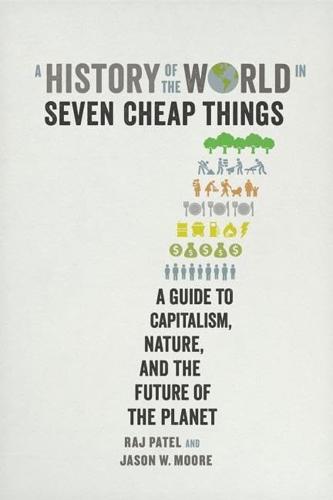
A History of the World in Seven Cheap Things: A Guide to Capitalism, Nature, and the Future of the Planet
by
Raj Patel
and
Jason W. Moore
Published 16 Oct 2017
Blickle 1981. 36. Ibid., 198–99. 37. Münzer 1524, quoted in Marx 2000, 68. 38. Braudel 1972, 339, 388–89. 39. Epstein 1996. 40. Lopez 1964. 41. Braudel 1972, 339. 42. Coles 1957, 18. 43. Heers 1961; Dotson and Agosto 1998, 11. 44. Coles 1957, 19. 45. To keep track of public finances, double-entry bookkeeping was necessary. The earliest Casa ledgers, dating from 1340, are in this format. Although this system was developed independently in Korea (O. Miller 2007) and drew on ideas that were established in the Middle East (Zaid 2004), it’s not insignificant that it was a technology that features in modern finance.
…
See also Feudalism; Genoese banking; specific nations extrahuman natures: appropriation of, 63, 95; care work and, 110, 117; redistribution and, 210; temporal relationship with, 98; threats to, 226n44; value and, 101; work of, 24–25, 119, 164 Fair Labor Standards Act of 1938, 136 Félix, Georges, 212 Ferdinand V, King of Spain, 65, 66, 74 feudalism: decline of, 49, 59, 72, 96–97; in Europe, 9–13, 100, 163; Little Ice Age and, 48 finance: accumulation, 88–89; debt repayment, 39; double-entry bookkeeping, 223n45; financialization, 68–70, 87, 125–28; financier advancement, 28; Glass-Steagall Act, 40; Greece debt crisis, 89–90; interest rates, 70, 77, 222n30; International Monetary Fund (IMF), 87, 89, 131, 136; investment returns, 27, 28; low interest, 68; microfinance, 224n92; monetary systems, 71–74; women’s inheritance rights, 125–28.

The Price of Time: The Real Story of Interest
by
Edward Chancellor
Published 15 Aug 2022
Datini, whose life is recorded in Iris Origo’s biography The Merchant of Prato, is a precursor to the modern capitalist: his nature was anxious, ambitions limitless and exertions without end. Although Datini’s ledgers opened with the words, ‘In the name of God and of Profits’, the accounts were kept with the newfangled system of double-entry bookkeeping – a Venetian invention that was spreading across northern Italy.fn4 Datini was in the vanguard of a banking revolution that turned the cities of Florence, Venice and Genoa into great financial centres. He belonged to the rising class of international traders who opened up Mediterranean and European trade, settling their bills through foreign agents and at the great fairs of Lyons, Champagne and Geneva.
…
W., 72 Charles II, King of England, 33, 38 Chase National Bank, 87, 88 Chaumont, the Widow, 54–5 Child, Sir Josiah, xxii, 33–4, 35, 36–7, 37*, 38–40, 41, 43, 44, 202 China: authoritarian relapse in recent years, 288–9; back-alley banking, 281–3; capital controls in, 262, 266, 285; capital flight from, 285–6; and ‘commodity super-cycle (from 2010), 173–4, 255–6; corporate zombies in, 277, 281, 285, 289; corruption in, 270, 274, 275, 287–8, 287*; currency devaluation (2015), 227; debt-deflation in, 280–81; Deng’s reform era, 265, 266, 267; and digital currencies concept, 294; economic stimulus plan (2008/9), 270, 271–81, 282, 289, 292; export driven expansion, 132, 182, 267–70; and financial repression, 264–5, 265*, 266–81, 268*, 283, 286–9, 292; foreign capital inflows, 254–5, 256, 265–6, 267, 270, 270*; garlic bulb bubble, 173, 271, 282; ‘great divergence’ from West, 288; growing inequality in, 287–8, 287†; high occurrence of elevator accidents, 274, 274*; high-speed rail expansion, 275; housing boom during Covid pandemic, 310; increased share of world trade, 260; ‘iron rice bowl’ removed, 268; joins WTO (2001), 267; as leading producer of greenhouse gases, 277–8; long tradition of impressive investments, 276; ‘national team’ of state enterprises, 272, 272*; and new technologies, 177, 276, 283, 284; paper money invented in, 265; ‘Red Capitalism’, 280, 284, 292; savings/current account surpluses, 129, 268–9, 270; ‘shadow banks’ in, 266, 270, 282*, 283–5, 286; SHIBOR lending rate, 284; and taper tantrum (June 2013), 256, 284; treatment of Uighurs, 288; Trump’s trade wars with, 262; uncoordinated investment in, 266, 269, 270, 272–4, 275–9, 280–81; undervalued exchange rate, 267–8, 270, 271; unscrupulous vested interests, 270, 286–9; unstable bubbles in, 270, 271–4, 282, 288; unsustainable debt in, 270, 279–81, 282–5, 289; US loss of manufacturing jobs to, 261, 261*; vast investment boom in, xxiii, 128, 267–81, 280*, 282–9; wealth management product (WMP), 283–4; Wenzhou’s credit crunch (2011), 282–3 Chu, Charlene, 280 Citigroup, 232† Clapham, Sir John, 79 Clarida, Richard, 310 classical economists, 12, 14, 27–8, 31, 41, 85*, 130–31, 132–3, 183 see also Smith, Adam Clifford & Sons, 63 climate change, 255, 277–8 cloth trade, 14–15, 22, 23 Cobham, Thomas of, 19–20, 26 Coffin, Charles, 156 Cole, Christopher, 229*, 231 collateralized debt obligations (CDOs), 116, 227 collateralized loan obligations (CLOs), 227 Commerzbank, Germany, 245 compound interest, xvii, 8–9, 190, 200, 202 Conard, Joseph, 141* Connally, John, 251, 262 Consols (British bonds), 62–3, 65, 65†, 70, 77, 79, 80, 126 Conti, Louis Armand II, Prince of, 55 Coolidge, Calvin, 87, 92–3 corporate sector: benefits of low interest rates for, xxii; the financialized firm, 166–7; ‘good will’ on balance sheets, 169, 180; profits bubble in post-crisis USA, 183, 185, 211; ‘shareholder value’ philosophy, 163–6, 167, 170–71 corruption, 63, 258, 274, 275, 287*, 288; in China, 270, 274, 275, 287–8, 287*; Galbraith coins ‘bezzle’ term, 287 Coughlin, Father Charles, 242 Coupe, Mike, 160 ‘coveitise’, practice of, 24 Covid-19 pandemic, xxii, 224*, 304, 305–7, 309–10 Cowen, Tyler, 198 Coxey’s Army, 201 credit: in ancient Near East, 3, 5–10, 11, 15; and Borio’s financial cycle, 132, 134, 135; causes of booms, 42, 43, 44, 118, 176–7, 220; central bank dominion over markets, xxii, 292–3, 293*; collapse in quality in post-crisis decade, 222–4, 231, 233, 237–8; decline in quality during booms, 112, 116, 135–6; Defoe on, 28; emergence of modern credit cycle, 62–4; expansion in 1920s USA, 87–91, 92–4, 96–8, 112, 203; growth before 2008 crisis, 112–13, 114, 115, 116; Law’s credit theory, 47, 60; in medieval Italy, 22–3, 35; poor quality in expanding China, 266; as pre-dating barter, 3, 14; psychological elements, 64; rationing under Bretton Woods system, 291; strong growth of as red flag, 132, 135; unequal access to, xxii, xxv, 14, 15, 215; vast investment boom in China, xxiii, 128, 267–81, 280*, 282–9; Wenzhou’s credit crunch (2011), 282–3 Credit Suisse, 229 Creditanstalt, collapse of (1931), 93, 93*, 243, 261 Cruz, Gaspar da, 276 cryptocurrencies, 173, 177–9, 307–8, 312 Culpeper, Sir Thomas, the Younger, 34–5, 44 Culpeper, Sir Thomas, ‘Tract Against Usury’ (1621), 34, 35 Cyprus, 262 Dalio, Ray, 217, 229, 291 Datini, Francesco, 21–3, 24 Dawes Loan (1924), 91 Deaton, Angus, 213 debt: after 2008 crisis, 138–9, 237, 237†; ancient debt tablets, 5–6; ‘balance sheet recessions’, 191; cancellation/jubilees/clean slates, 9, 300; dangers of cheap credit, 32, 44; debt bondage, 5, 9, 18; ‘debt supercycle’, 135; ‘debt trap’, 43, 135, 280; debt-deflation, 98–9, 100, 119, 280–81; debt–service ratio, 135; ‘evergreening’ of bad debts, 136, 145–6, 280; late payment penalties, 10, 14, 25; Lord King on (2019), 304; as missing link in secular stagnation narrative, 135–6, 138–9; mortgage equity withdrawal, 112–13, 191, 205; problem of compound interest, 8–9; Proudhon on, xvii, xviii; revival of subprime market, 215, 221, 224; student debt ‘bubble’, 212, 213; tax structures favour over equity, 164; transferable/heritable in Babylon, 7 deflation: after 1929 Crash, 98–9, 100, 101, 105, 108; Austrian economists’ view of, 100, 101, 105, 113, 133–4; crisis of 2008 revives fears of, 119, 122; debt-deflation, 98–9, 100, 119, 280–81; in early-1920s Britain, 85–6; and Fed’s post-2008 policies, 236–8; ‘forgotten depression’ (1921), 84, 86, 100, 143; and high rates of interest, 42, 43, 64; impact of zombies, 237, 237†; impact on working people, 99–100; in Japan from 1990s, 100–101, 107–8, 114, 119, 135, 136, 145–6, 147, 148, 182, 191, 193; in late nineteenth century, 78–80, 99, 101; in post-Great War period, 84, 85–6; as preoccupation of modern central bankers, xxiii, xxv, 76, 112, 115, 115†, 122; Say’s view of, 99; and Victorian era, 76; view of as good/not harmful, 99–101, 113–14, 132; and Wicksell’s view of interest, 42 Defoe, Daniel, 28, 46, 47, 56, 57, 202, 308 Del Monte Foods, 222 democracy, 293, 293†, 296, 297; the old as largest voting cohort, 211–12; rise of populism, xxii, 299; weakening support for, 299 demographics: ageing societies, 29, 127; ‘Bank of Mum and Dad’, 212; generational impact of 2008 crisis, 211–12, 213; Alvin Hansen on, 126; and interest, xxiv, 10, 12, 126–7, 131, 133; largest voting cohort as old, 211–12; life expectancy statistics, 198, 213; and secular stagnation argument, 125, 126, 129; student debt ‘bubble’, 212, 213; and ‘time preference’ theory, 29 Demosthenes, 18† Deng Xiaoping, 265, 266, 267 Denmark, 242, 244, 245, 247 Deutsche Bank, 147* Dodd, David, 90–91 Dodd–Frank Act (2010), 232 Dogecoin, 308 Dollar Standard, 118, 251–2, 253, 261, 262–3, 267 Dostoyevsky, Fyodor, 294 Dotcom bubble, 111–12, 136–7, 176, 204, 206 double-entry bookkeeping, 21–2 Douglas, C. H., 242 Draghi, Mario, 61, 122–3, 145, 146, 147, 240, 293, 305 Drucker, Peter, 163 Dudley, William, 238 Dugas, Laurent, 56 Dumoulin, Charles, 25 Dutch Republic, 13, 33, 35–6, 39, 49, 63, 68 Dutot, Nicholas, 53–4, 57 East India Company, 33, 36–7, 37*, 53, 70 Easterly, William, 189–90 ecological systems, 154–5 economic growth: and Borio’s thinking, 134, 135–9; Brazilian ‘miracle’, 257–8; and ‘bubble economy’ concept, 183–7; during deflationary periods, 100–101; and digital technologies, 127–8, 151–2, 176–7; and Draghi’s policy at ECB, 146–8; and Fed’s easy money policy, 111, 112, 115, 124, 152–3, 182–3, 238; and global interest rates prior to crisis, 118, 135; and globalization, 260–61; in Great Depression era, 142–3; and Hayek, 296, 298; and inequality, 203–6, 216–17, 237, 299; and inflation, 108, 108*; and inflation targeting, 123; in Japan of 1980s, 105–8; in Japan of 1990s, 100–101, 146, 147; led by finance, 266; and meaning of ‘wealth’, 179–82, 193–5; negative impact of building booms, 135–6, 144–5, 148; and Piketty’s theory, 216–17; in post-crisis Iceland, 300–301; productivity collapse in post-crisis decade, 150–51, 152–3; and reduced interest rates after a bubble, 114, 136, 138, 145–6; relation to interest rates, xxiv, xxv, 10, 12, 44, 89, 124–9, 141, 162, 237–8; secular stagnation concept, 77, 124–9, 131, 132–9, 151, 205–6; slow recovery from Great Recession, 124–5, 126–9, 131–2, 150–53, 298–9, 304; in Soviet Union of 1950s, 278; as strong after Second World War, 126, 302; as strong in 1920s USA, 89, 89–90, 108, 143; as subordinated to financialization, 162–71, 182–3, 203–6, 237, 260; vast expansion in China, 265–74, 275–82, 283–9 economic models: canonical model used by central banks, 118, 131, 153*, 207; and demographics, 127, 131; distributional issues as suppressed in, 207; ignoring of resource misallocations, 153*; no place for money and credit in, 118; and perceptions of risk, 230; and productivity puzzle, 151; rational actors/perfect foresight assumptions, 118; unreal reality of academic models, 138, 207 The Economist, 63, 67, 71–2, 73, 77 EDF (French utility), 225 Edmunds, John C., 181 Egypt, 77, 78, 255, 262 Einstein, Albert, 8 Elizabeth II, Queen, 114 Ellington Capital Management, 223 Emden, Paul, 80* emerging markets: Brazilian crash (2012–13), 257–8; BRICs, 254–5, 257–8; capital controls return after 2008, 262, 291; capital flight from (starting 2015), 262, 285–6; demand for industrial commodities, 128; epic corruption scandals, 258; and extended supply chains, 261; flooding across South East Asia (2010), 255; ‘Fragile Five’, 258–9; growth of foreign exchange reserves, 252, 253, 254–5, 256; impact of ultra-low interest rates on, xxiii, 253–60, 262–3; international carry Trade, 137, 237–8; overheating during 2010, 255, 256; post-crisis capital flows into, xxiii, 253–9, 262–3; and recent phase of globalization, 260–61; recovery from 2008 crisis, 124; and savings glut hypothesis, 129, 268–9; ‘second phase of global liquidity’ after 2008 crisis, 253–9, 262–3; and taper tantrum (June 2013), xxiii, 137, 239, 256–7, 259, 263; Turkish debt, 258–60; vulnerability to US monetary policy, 137, 262–3, 267–8 see also China employment/labour markets, xx, 151–2, 240, 260–61, 260*, 296; after 2008 crisis, 210, 211; new insecurity, 211, 298 Erdogan, Recep Tyyip, 259 European Central Bank (ECB), 144, 145, 147, 239, 240, 293; inflation targeting, 119, 120, 122–3; and quantitative easing, 146, 241, 242; sets negative rate, 147, 192–3, 244, 299 European Union, 187, 241, 262 Eurozone, 124, 150–51, 226; and political sovereignty, 293, 293†; sovereign debt crisis (from 2010), 144–8, 226, 238, 239, 241, 273, 293 Evans, David Morier, 73 Evelyn, John, 36, 45 Evergrande (Chinese developer), 279, 288, 310 executive compensation schemes, 152, 162, 163–4, 170, 204, 206, 207 Extinction Rebellion, 201 ExxonMobil, 166 Fang’s Money House, Wenzhou, 281–2 farming: agricultural cycle, 11, 14, 88; and ‘Bank of John Deere’, 167; barley loans in ancient Mesopotamia, 5–6, 6*, 7, 8, 10, 11, 14; bubbles in post-crisis decade, 173; in China, 283; and language of interest, 4–5; loans related to consumption, 6, 25; US deflation of 1890s, 99 Federal Reserve, US: asymmetrical approach to rates, 136–7; as carry trader, 222; cognitive dissonance in, 118–19; Federal Reserve Act (1914), 83; ‘forgotten depression’ (1921), 84, 86, 100, 143; forward guidance policy, 131*, 133, 238, 239, 240, 241; and Gold Exchange Standard, 85, 87, 90*; the ‘Greenspan put’, 111, 186; impact on foreign countries, 137, 239, 240–41, 255–6, 259, 262–3, 267–8, 285; inflation targeting, 119, 120, 241; Long Island meeting (1927), 82–3, 88, 92; mandates of, 240, 262; and March 2020 crash, 305–6; Objectives of Monetary Policy (1937), 97; Open Market Committee (FOMC), 109, 112–13, 115†, 120, 164, 228, 238, 239, 240; Operation Twist (2011), 131*, 238; parallel with US Forest Service, 154–5; and post-Great War inflation, 84; as the ‘price of leverage’, xxi–xxii; quantitative easing by, 12*, 76, 131*, 137, 175, 215, 228, 236, 238, 239–40, 241; raised rates announcement (2015), 138, 239; reaches ‘zero lower bound’ (2008), 243–4; response to 1929 Crash, 98, 100, 101, 108; suggested as responsible for 2008 crisis, 116–17, 118–19, 155, 204, 226–7; TALF fund, 175; taper tantrum (June 2013), xxiii, 137, 239, 256–7, 259, 263; ultra-easy money after 2008 crisis, xxi, 60, 124, 131–8, 146, 149, 152–5, 181–3, 206–17, 221–4, 230, 235–41, 243–4, 262, 291–2; Paul Volcker runs, 108–9, 145; Janet Yellen runs, 120 see also Bernanke, Ben; Greenspan, Alan Feldstein, Martin, 119 Ferri, Giovanni, 277* Fetter, Frank, 30 Field, Alexander, The Great Leap Forward, 142–3 financial crisis (2008): accelerates financialization, 182–3; and complex debt securities, 116, 117–18, 231; ‘crunch porn’ on causes of, 114; economists who anticipated crisis, 113–14, 132; failure of unconventional monetary policies after, xxi, xxii, 43–4, 291–4, 298–9, 301–3; Fed’s monetary policy as suggested cause, 116–17, 118–19, 155, 204, 226–7; generational impact of, 211–12, 213; as ‘giant carry trade gone wrong’, 253–5; global causes of, 117–18; Icelandic recovery from, 301–2; and inequality, 204, 205–17, 299; interest at lowest level in five millennia during, xxi, 243–4, 247; Law’s System compared to, 49, 60–61; low/stable inflation at time of, 134, 135; monetary policy’s role in run-up downplayed, 115–16, 115*, 115†; and quoting of Bagehot, 76; recovery of lost industrial output after, 124; regulatory interpretation of, 114–15, 117; and return of the state, 292–5, 297, 298; return to ‘yield-chasing’ after, 221–6, 230–31, 233–4, 237–8; the rich as chief beneficiaries of, 206–10; savings glut hypothesis, 115–16, 117, 126, 128–9, 132, 191, 252, 268–9; ‘second phase of global liquidity’ after, 253–9, 262–3; unwinding of carry trades during, 221, 227; warnings from BIS economists before, 113–14, 131–4, 135–9 see also Great Recession financial derivatives market, 225–6 financial engineering: buybacks, 53, 152, 163–6, 167, 169, 170–71, 183, 224; crowding out of real economy by, 158–9, 160, 166–71, 182–3, 185, 237; ‘funding gap’ as impetus, 164, 176–7, 291; merger ‘tsunami’ after 2008 crisis, 160–63, 161*, 168–70, 237, 298; ‘promoter’s profit’ concept, 158–9, 160, 161, 164; and ‘shareholder value’, 163–6, 167, 170–71; Truman Show as allegory for bubble economy, 185–7; use of leverage, 111, 116, 149, 155, 158–71, 204, 207, 223, 237, 291; zaitech in Japan, 106, 182, 185 financial repression: in China, 264–5, 265*, 266–81, 268*, 283, 286–9, 292; and inequality, 287–8; McKinnon coins term, 264; political aspects, 265, 265*, 286–9, 292; returns to West after 2008 crisis, 291–3; after Second World War, 290–91, 302 financial sector: bond markets as ‘broken (2014), 227; complex securitizations, 116, 117–18, 221, 227, 231; decades-long bull market from early 1980s, 203–4; economics as fundamentally monetary, 132, 138–9; Edmunds’ ‘New World Wealth Machine’, 181–2; expansion in 1920s USA, 203; finance as leading growth, 266; financial mania of 1860s, 72–4, 75–6; fixed-income bonds, 68–9, 193, 219, 222, 225, 226; foreign securities/loans, 66, 77–8, 91; investment trusts appear (1880s), 79; liquidity traps, 114; mighty borrowers within, 202; profits bubble in post-crisis USA, 183, 183†, 185, 211; robber baron era in USA, 156–9, 203; stability as destabilizing, 82, 143, 233, 263, 285; stock market bubble in post-crisis decade, 175–7, 176*; trust companies in US, 83–4, 84*; US bond market ‘flash crash’ (2014), 138; and volatility, 153, 228–30, 233, 234, 254, 304, 305; volatility as asset class, 229–30, 229*, 233, 234, 304, 305; ‘Volmageddon’ (5 February 2018), 229–30, 234 see also banking and entries for individual institutions/events financial system, international: Asian crisis, 114, 252, 278; Basel banking rules, 232; Borio on ‘persistent expansionary bias’, 262–3; complex mortgage securities, 116, 117–18; crash (12 March 2020), 304–6; ‘excess elasticity’ of, 137; global financial imbalances, 137, 138; Louvre Accord (1987), 105–6; stock market crash (October 1987), 106, 110–11, 229 financialization, 162–71, 182–3, 185, 203–8, 237 Fink, Larry, 209, 246 Finley, Sir Moses, Economy and Society in Ancient Greece (1981), 18* fire-fighting services, 154–5 First World War, 84, 85 Fisher, Irving: and debt-deflation, 98–9, 100, 119, 280; first to refer to ‘real’ interest rate, 88–9, 219*; founds Stable Money League (1921), 87, 96; and Gesell’s rusting money, 243, 246; on interest, 29–30, 82, 189, 189*, 201; losses in 1929 crash, 94; monetarist view of 1929 Crash, 98–9, 100, 101, 108; ‘money illusion’ concept, 87*; on nature’s production, 4–5; on negative interest, 246; The Theory of Interest, xxiv, xxv, xxvi*, 16, 173 Fisher, Peter, 194 Fisher, Richard, 164 Fitzgerald, F.
…
Demosthenes claimed that the slave-prostitute Neara bought her freedom by raising eranos contributions from former clients. fn3 Bonaventura’s comment contains the germ of Marx’s ‘labour theory of value’. In contradiction, Böhm-Bawerk pointed out that a bottle of wine, placed in the cellar, increases in value without any additional labour input. fn4 Double-entry bookkeeping represents an extraordinary intellectual feat of quantification. Every asset and each exchange is given a monetary value and recorded in the same currency. The use of Arabic numerals enabled figures to be readily calculated. The German sociologist Werner Sombart, author of the six volume Modern Capitalism (first published in 1912), went so far as to claim that, by encouraging regular record-keeping, mathematical order and the reduction of events to numerical abstractions, double-entry contains the germ of the later Scientific Revolution.
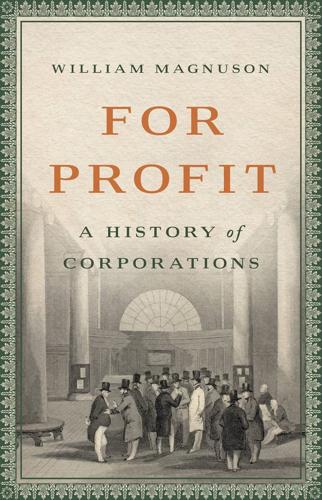
For Profit: A History of Corporations
by
William Magnuson
Published 8 Nov 2022
The Medici Bank had to keep track of its assets and liabilities over long periods and across borders if it wanted to grow its business and perpetuate its elaborate anti-usury subterfuges. To do so, the Medici Bank used a system known as double-entry bookkeeping, a brilliant form of accounting that remains in widespread use today. Under the double-entry system, each transaction of the bank led to two entries in the bank’s accounts: one credit and one debit. The system helped the bank to prevent sloppy record keeping, as mistakes were easily detectable if one side of the account did not balance with the other. Though the Medici didn’t invent double-entry bookkeeping—other Florentine banks of the time also used the method, and there is evidence of its use in Genoa as early as 1340—they perfected the art.
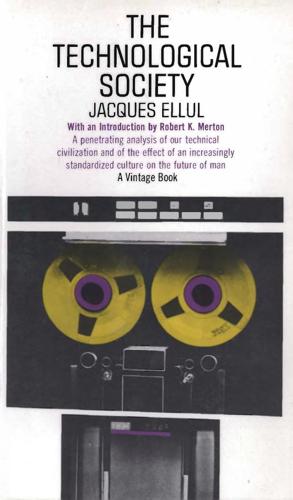
Ellul, Jacques-The Technological Society-Vintage Books (1964)
by
Unknown
Published 7 Jun 2012
Commercial techniques developed at the beginning of the nineteenth century with the same velocity as industrial techniques. These commercial techniques exploited all the old systems which had previously existed sporadically and The Technological Society (113 without much vigor. Bills of exchange, banks, clearing houses, double-entry bookkeeping, and the like, were further developed. The need to distribute manufactured goods thus acted to produce a powerful commercial technique, which, however, proved to be incapable of assuring proper distribution. The accumulation of capital (produced by the machine and also necessitated by it) be came tlie source of an international financial organization, with its systems of great firms, insurance, credit, and the corporation with limited liabilities.
…
In fact, of all techniques, financial technique had evolved most rapidly; it had already arrived at a stage at which no further improvement was thought necessary. Here, too, the state was the prime mover. Philip IV had initiated a number of financial techniques which were completed between the fourteenth and the sixteenth centuries. Among Philip's innovations were double-entry bookkeeping, budg etary management and forecasting, separation of the services of the Budget and the Treasury, and the theory of loan management. The state, however, did not play an exclusive role in matters re lating to financial techniques. There were financiers who were also merchants and who used for their own ends a merchandising tech nique they helped to develop.
…
Productivity, which seemed heretofore to be a purely economic concept, has made its appearance in the last few years in the political framework. It is necessary to evaluate the cost of every administrative operation and to apply the law of marginal yield. Funds are assigned to each department on the basis of a standard cost established through service. By introducing modern double-entry bookkeeping, it is possible to carry out a constant inspection of activities on every level and to establish the relation between actual and standard expenses. In this way, the law of the technician transforms the administrative perspective. Every administration becomes an object, as formerly the worker became an object in Taylor’s hands.

What Technology Wants
by
Kevin Kelly
Published 14 Jul 2010
In White’s view, the adoption of the lowly foot stirrup for horse saddles enabled riders to use weapons on horseback, which gave an advantage to the cavalry over infantry and to the lords who could afford horses, and so nurtured the rise of aristocratic feudalism in Europe. The stirrup is not the only technology that has been blamed for feudalism. As Karl Marx famously claimed, “The hand-mill gives you society with the feudal lord; the steam-mill, society with the industrial capitalist.” Double-entry bookkeeping, invented in 1494 by a Franciscan monk, enabled companies to monitor their cash flow and for the first time to steer complex business. Double-entry accounting unleashed the banking industry in Venice and launched a global economy. The invention of moveable-type printing in Europe encouraged Christians to read their religion’s founding text themselves and make their own interpretations, and that launched the very idea of “protest” within and against religion.
…
clocks clothing cloud computing coal power coevolution Cole, John Colonial America compass, magnetic complex adaptive systems complexity future scenarios of as long-term trend specialization and computer chips transistors in see also Moore’s Law computers digital storage in DNA increased software complexity of invention of multiple functions of obsolete specialty computer simulations computer viruses contingency choices in in convergent inventions convergence see also inventions, convergence of “Convergent Evolution” (McGhee) conviviality Conway, John Cooke, William corals Bryozoa cornets Correns, Karl Erich crafts Crichton, Michael Cro-Magnons, see Sapiens crossbows cryptochromes customization, personal Daguerre, Louis Darwin, Charles Davies, Paul Davis, Mike Dawkins, Richard DDT Dean, Bashford decentralization de Duve, Christian deforestation demographic transition Dennett, Daniel Denton, Michael desert environments de Vries, Hugo Diamond, Jared Didion, Joan dinosaurs convergent lineages of diversity cultural differences in of ethnic and social preferences excessive choices offered by fringe of intelligence as long-term trend uniformity in DNA invented alternatives to mutation rate in mysterious origins of self-organization of synthesis of DNA sequencing Dobe tribe dolphins intelligence of domestication animal crop independent inventions of double-entry bookkeeping du Chaillu, Paul Dunn, Mark Dyson, Freeman Earth First! Journal Earth Summit (1992) Easterbrook, Gregg Easterlin, Richard Economist economy consumer spending in dematerialization of free market global Moore’s Law and nongrowth population growth and and prohibited technology of slums ecosystems ecumenopolis Edison, Thomas Edison’s Electric Light: Biography of an Invention (Friedel, Israel, and Finn) education efficiency Egypt, ancient Eigen, Manfred Einstein, Albert relativity theories of Einstein: His Life and Universe (Isaacson) Eisely, Loren Eldredge, Niles electric incandescent lightbulb electricity Amish and electric motors Ellington, A.
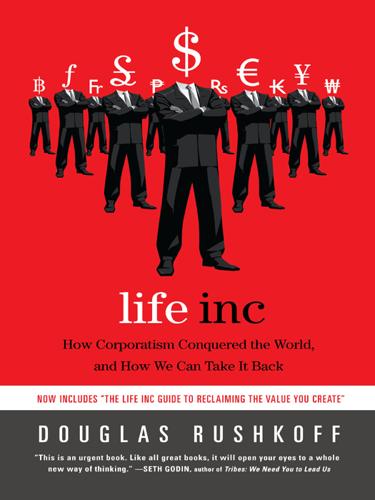
Life Inc.: How the World Became a Corporation and How to Take It Back
by
Douglas Rushkoff
Published 1 Jun 2009
Most of the business and finance innovations of the early corporate era—inventions we still look on fondly today—were really just ways of preserving and extending the reach of this new business entity. The health of a corporation was understood purely in terms of money, as measured by the new accounting technique of double-entry bookkeeping. Any transaction resulted in the debiting of one account and the crediting of another. This made achieving a favorable balance of trade the highest priority, and fostered a zero-sum-game mentality among all participants. International trade became a fierce competition between states for positive balances, which led to wars unlike any seen before.
…
And, in both cases, after a few hundred years, the continual debasement of currency led to the fall of the empire. We’re fast approaching the limits of our own currency system, instated to benefit corporate interests and adjusted over time to do it ever more efficiently and automatically. If double-entry bookkeeping can be thought of as the spreadsheet software on which businesses learned to reconcile their debits and credits, central currency was the operating system on which this accounting took place. Like any operating system, it has faded into the background now that a program is running, and it is seemingly uninvolved in whatever is taking place.
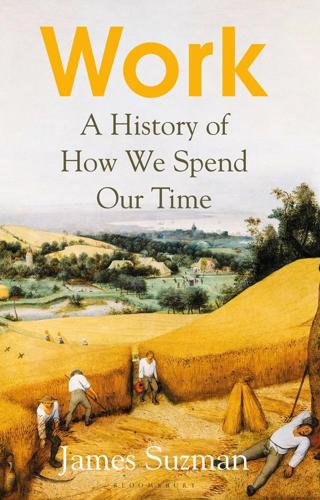
Work: A History of How We Spend Our Time
by
James Suzman
Published 2 Sep 2020
The oldest recorded use of the phrase is in the book Della Mercatura et del Mercante Perfetto (Commerce and the Perfect Merchant), a tome published in 1573 by a Croatian trader, Benedetto Cotrugli, who was also the first person anywhere to challenge readers with a detailed description of the principles of double-entry bookkeeping. But the sentiment behind this apparently self-evident idea is far older still, and like our contemporary attitudes to work, also had its origins in farming. The basic correspondence between time, effort and reward is as intuitive to a hunter-gatherer as it is to a packer in a warehouse sealing boxes on minimum wage.
…
Index aardvarks here, here abiogenesis here Abrahamic religions here, here Académie des Sciences here acetogens here Acheulean hand-axes here, here, here Adam and Eve here, here adenosine triphosphate (ATP) here advertising here Africa, human expansion out of here agriculture and the calendar here, here catastrophes here and climate change here, here human transition to here inequality as consequence of here and investment here Natufians and here, here, here, here productivity gains here, here, here, here, here proportion employed in here spread of here and urbanisation here Akkadian Empire here Alexander the Great here American Federation of Labor here American Society of Mechanical Engineers here animal domestication here, here, here, here, here animal tracks here animal welfare here animals’ souls here anomie here anthrax here Anthropocene era here anti-trust laws here ants here, here, here Aquinas, Thomas here, here, here archery here Archimedes here, here, here Aristotle here, here, here, here Arkwright, Richard here armies, standing here Aronson, Ben here artificial intelligence here, here, here, here, here, here, here, here, here ass’s jawbone here asset ownership here AT&T here Athens, ancient here, here aurochs here Australian Aboriginals here, here, here, here, here Australopithecus here, here, here, here, here, here, here, here automation here, here, here, here, here, here, here, here, here Aztecs here baboons here Baka here BaMbuti here, here, here, here, here bank holidays here, here Bantu civilisations here barter here, here, here, here, here Batek here Bates, Dorothea here beer here, here, here, here, here bees here, here, here, here Belgian Congo here, here Bergen Work Addiction Scale here Biaka here billiards here biodiversity loss here, here, here birds of paradise here bison, European here Black-Connery 30-Hours Bill here Blombos Cave here, here Blurton-Jones, Nicholas here boa constrictors here boats, burning of here Bolling Allerød Interstadial here, here, here Boltzmann, Ludwig here boredom here, here Boucher de Crèvecœur de Perthes, Jacques here, here bovine pleuropneumonia here bowerbirds here, here brains here, here, here increase in size here and social networks here Breuil, Abbé here Broca’s area here Bryant and May matchgirls’ strike here bubonic plague here ‘bullshit jobs’ here butchery, ancient here Byron, Lord here Calico Acts here Cambrian explosion here cannibalism here caps, flat here carbon dioxide, atmospheric here, here cartels here Çatalhöyük here, here Cato institute here cattle domestication of here as investment here cave paintings, see rock and cave paintings census data here CEOs here, here, here, here, here, here cephalopods here cereals, high-yielding here Chauvet Cave painting here cheetahs here, here, here child labour here childbirth, deaths in here Childe, Vere Gordon here, here, here, here chimpanzees here, here, here, here, here, here, here China here, here, here, here, here, here Han dynasty here medical licensing examination here Qin dynasty here services sector here, here Shang dynasty here, here Song dynasty here value of public wealth here Chomsky, Noam here circumcision, universal here Ciudad Neza here clam shells here Clark, Colin here, here climate change here, here, here see also greenhouse gas emissions Clinton, Bill here clothing, and status here Club of Rome here, here coal here Coast Salish here, here cognitive threshold, humans cross here, here ‘collective consciousness’ here ‘collective unconscious’ here colonialism here commensalism here Communism, collapse of here Conrad, Joseph here consultancy firms here Cook, Captain James here cooking here, here, here coral reefs here Coriolis, Gaspard-Gustave here coronaviruses here corporate social responsibility here Cotrugli, Benedetto here cotton here, here, here credit and debt arrangements here Crick, Francis here crop rotation here cyanobacteria here, here Cyrus the Great here Darius the Great here Darwin, Charles here, here, here, here, here, here, here, here debt, personal and household here deer here, here demand-sharing here Denisovans here Descartes, René here, here, here, here DeVore, Irven here Dharavi here diamonds here, here diamphidia larvae here Dinka here division of labour here, here, here DNA here, here, here mitochondrial here dogs here, here, here, here, here, here domestication of here Lubbock’s pet poodle here Pavlov’s here wild here, here double-entry bookkeeping here dreaming here Dunbar, Robin here, here Durkheim, Emile here, here, here, here Dutch plough here dwellings drystone-walled here mammoth-bone here earth’s atmosphere, composition of here earth’s axis, shifts in alignment of here East India Company here, here ‘economic problem’ here, here, here, here, here, here, here, here, here, here economics ‘boom and bust’ here definitions of here, here formalists v. substantivists here fundamental conflict within here ‘trickle-down’ here ecosystem services here Edward III, King here efficiency movement here egalitarianism here, here, here, here, here, here egrets here Egypt, Roman here, here Egyptian Empire here einkorn here Einstein, Albert here elands here, here elderly, care of here, here, here, here elephants here, here, here, here, here, here energy-capture here, here, here Enlightenment here, here, here, here Enron here Enterprise Hydraulic Works here, here entropy here, here, here, here, here, here EU Working Time Directive here Euclid here eukaryotes here eusociality here, here evolution here, here and selfish traits here see also natural selection Facebook here, here Factory Acts here, here factory system here, here famines and food shortages here, here fertilisers here, here fighting, and social hierarchies here financial crisis (2007–8) here, here financial deregulation here fire, human mastery of here, here, here, here, here see also cooking fisheries here flightless birds here foot-and-mouth disease here Ford, Henry here, here, here, here, here fossil fuels here, here, here, here, here, here, here Fox, William here foxes here, here bat-eared here Franklin, Benjamin here, here, here, here, here, here, here free markets here, here, here free time (leisure time) here, here, here, here, here, here, here, here, here freeloaders here, here, here Freud, Sigmund here Frey, Carl, and Michael Osborne here funerary inscriptions here Galbraith, John Kenneth here, here Galileo here Gallup State of the Global Workplace report here Garrod, Dorothy here, here gazelle bones here, here genomic studies here, here, here, here, here, here, here, here, here and domesticated dogs here geometry here gift giving here Gilgamesh here glacial periods here, here gladiators here Gladwell, Malcolm here globalisation here Göbekli Tepe here, here Gompers, Samuel here Google here Google AlphaGO here Gordon, Wendy here Gorilla Sign Language here gorillas here, here, here, here see also Koko Govett’s Leap here Graeber, David here, here granaries here graves here graveyards, Natufian here Great Decoupling here, here Great Depression here, here, here ‘great oxidation event’ here, here Great Zimbabwe here greenhouse gas emissions here, here see also climate change Greenlandic ice cores here grewia here Grimes, William here Gurirab, Thadeus here, here gut bacteria here Hadzabe here, here, here, here, here, here, here Harlan, Jack here harpoon-heads here Hasegawa, Toshikazu here Health and Safety Executive here health insurance here Heidegger, Martin here Hephaistos here Hero of Alexandria here Hesiod here hippopotamuses here Hitler, Adolf here hominins, evidence for use of fire here Homo antecessor here Homo erectus here, here, here, here, here, here, here, here, here, here Homo habilis here, here, here, here, here, here, here, here Homo heidelbergensis here, here, here, here, here Homo naledi here horses here, here wild here household wealth, median US here housing, improved here human resources here, here, here Humphrey, Caroline here Hunduism here hunter-gatherers, ‘complex’ here hyenas here, here, here, here, here immigration here Industrial Revolution here, here, here, here, here, here, here, here, here, here, here, here, here, here, here, here, here, here, here, here, here inequality here, here, here, here, here in ancient Rome here influenza here ‘informavores’ here injuries, work-related here Institute of Bankers here, here Institute of Management here intelligence here, here evolution of here interest here internal combustion engine here, here Inuit here, here, here, here Iroquois Confederacy here Ituri Forest here jackals here Japan here, here, here jealousy, see self-interest jewellery here, here, here, here, here Ju/’hoansi here, here, here, here, here, here, here, here, here, here, here, here, here, here, here and animals’ souls here contrasted with ‘complex hunter-gatherers’ here contrasted with farming communities here, here, here creation mythologies here and ‘creatures of the city’ here and demand-sharing here, here egalitarianism here, here, here, here, here, here energy-capture rates here life expectancy here and mockery here village sizes here Jung, Carl Gustav here kacho-byo (‘manager’s disease’) here kangaroos here Karacadag here karo jisatsu here, here karoshi here, here Kathu Pan hand-axes here, here, here Kavango here Kellogg, John Harvey here Kellogg, Will here Kennedy, John F. here Keynes, John Maynard here, here, here, here, here, here, here, here, here, here, here, here, here Khoisan here, here, here Kibera here Kish here Koko here, here, here Kubaba, Queen here Kwakwaka’wakw here, here labour/debt relationships here labour theory of value here Lake Eyasi here Lake Hula here Lake Turkana here, here language arbitrary nature of here evolution of here Gossip and Grooming hypothesis here, here Grammaticalisation theory here processing here Single Step theory here langues de chat (cat’s tongues) here latifundia here le Blanc, Abbé Jean here leatherwork here Lee, Richard Borshay here, here, here, here, here leisure activities here leisure time, see free time Leopold II, King of the Belgians here, here Lévi-Strauss, Claude here, here, here, here Liebenberg, Louis here life expectancy here, here life on earth, evolution of here lignin here Limits to Growth, The here lions here, here, here, here, here, here, here, here, here, here literacy, see writing living standards, rising here Loki here, here London neighbourhoods here longhouses here Louis XIV, King of France here Louis XVI, King of France here Löwenmensch (Lion Man) sculpture here Lubbock, Sir John here, here Luddites here, here, here Luoyang (Chengzhou) here, here luxury goods here McKinsey and Co. here, here, here ‘malady of infinite aspirations’ here Malthus, Rev.
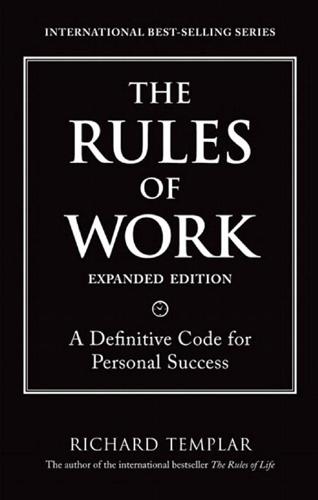
The Rules of Work, Expanded Edition: A Definitive Code for Personal Success (The Rules by Richard Templar)
by
Richard Templar
Published 26 Sep 2002
What for? Your boss couldn’t give two monkeys whether you smile at the customers or not. All he wants is to shine at his appraisal. This sort of thing goes on a lot more at work than most people like to think. Once, I volunteered to attend college every Monday to do a course in payroll and double entry bookkeeping. My boss thought I was keen, self-motivated, and very enthusiastic. Nonsense. I wanted to get out of the office every Monday because that was the day we had to do all the filing and I hated it. Going to college seemed a good cop-out. Question the motives of everyone and everything. This doesn’t mean you have to become paranoid.

Consumed: How Markets Corrupt Children, Infantilize Adults, and Swallow Citizens Whole
by
Benjamin R. Barber
Published 1 Jan 2007
For all of this, the Fuggers remained faithful Catholics, and Jacob Fugger actually drew the ire of Martin Luther (if also a certain grudging admiration).58 But Fugger’s business practices and experience as “a manager of modern character” whose “advanced knowledge and innovations, forbidden transactions involving interest and monopolies and the giving and taking between himself and the great powers of his time” suggested what Weber would see as a Protestant mentality that both absorbed and helped generate the new ethos Weber would later celebrate—an ethos that made it possible for the Fuggers to capture, control, and deploy the fantastic new energy of monopoly capital.59 The secret weapons of the Fuggers, along with cartelism, were double entry bookkeeping and Giro credit transfers that allowed commodities to be converted into cash and cash into the cashless moving and accumulation of wealth. The Fuggers had learned their bookkeeping secrets in the great Renaissance trading port of Venice and then, propelled by their mining and trading interests, put them into practice in Germany and the rest of Europe with consequences that were to impact profoundly European capitalism.
…
When, for example, he introduced rational bookkeeping into large-scale businesses, he not only tamed the wild capitalist adventure that was the Pennsylvania oil boom but managed to sacralize accounting and ennoble the most quotidian moments in his mundane commercial life. The day on which he got his first appointment as an assistant bookkeeper to the firm of Hewitt and Tuttle (September 26, 1855) he commemorated as “job day.” The double entry bookkeeping ledgers that enabled him to impose rational control over the chaos of early capitalist oil and commodity markets became “sacred books that guided decisions and saved one from fallible emotions.” His first ledger in time took on the aspect of a “sacred relic.”61 We do not then need to read Protestantism into Rockefeller’s life.
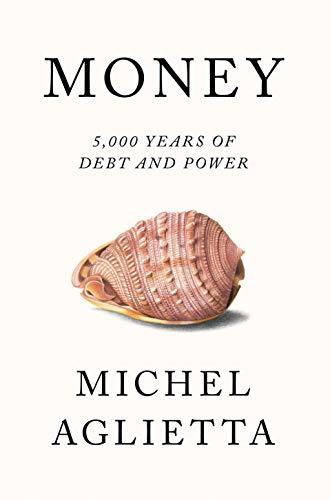
Money: 5,000 Years of Debt and Power
by
Michel Aglietta
Published 23 Oct 2018
The balances of payments that result from the double-entry recordings link the operating accounts of the period concerned to balance sheets, which both bear the memory of the past and lead onto the future. Together, the accounts of all actors constitute a system. This owes to the mirrored recording of the decentralised exchanges between actors, following the principle of double-entry bookkeeping. Each exchange has a double record: a record of the flow of payment, and a record of the equivalent value of the object transferred. It follows from this that agents’ accounts balance out. Exchanges are decentralised, but at the same time they have a unity. This owes not to prices, but to the flows of money that circulate between accounts.
…
See also Great Depression d’Estaing, Valéry Giscard, 324 de Tocqueville, Alexis, 134 Deutsche Mark, 365 discord, as state of relations among states, 358, 359 disequilibria, 16, 257, 263, 295, 333, 336, 337, 390, 393 dokima money, 90, 91, 96 dokimon, 94 dollar, 150, 311–41, 342–3, 348, 357, 374, 380, 385, 386 dollar cycle and its trend (real effective exchange rate), 337f dollar semi-standard, 10, 336–41, 345, 377, 385, 392 double-entry bookkeeping, 33, 34 dualist system, 109–10, 113–15, 117, 120–5, 135, 195–200, 208, 316, 384 Dumont, Louis, 105n26, 129 Dupuy, Jean-Pierre, 20, 64 dynamic vulnerabilities, 273, 275 E ECB (European Central Bank), 348, 362, 363, 365, 367 Economic Consequences of the Peace (Keynes), 306t Economic Cooperation Administration (ECA), 318 economic coordination, 5, 6, 7, 17, 20, 54 economic fluctuations, 27, 390 economic indicators of stability, comparison of for UK and USA, 302t economics.
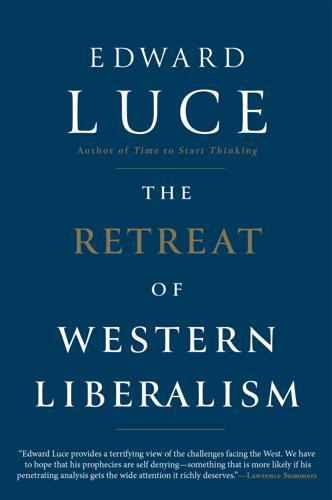
The Retreat of Western Liberalism
by
Edward Luce
Published 20 Apr 2017
What most would be unlikely to know is the degree to which Chinese technology provided critical sparks to the Industrial Revolution. Among other techniques and inventions, Europe took far-superior iron and steel production; the printing press; navigational tools, including the compass; gunpowder; and paper money from China. From Islam, Europe took binary mathematics (originally from India), astronomy, double-entry bookkeeping and much of its own forgotten knowledge from classical Greece and Rome. ‘[Much] of the European revival was based on the ideas, institutions, and technologies borrowed from the advanced civilizations in the Middle and Far East,’ notes Richard Baldwin, whose book on today’s Great Convergence is rightly acclaimed.9 The shift of power from the Islamic world to the Christian in the late Middle Ages had, in turn, been enabled by the destructive westward sweep of Genghis Khan’s Mongol hordes in the thirteenth century.
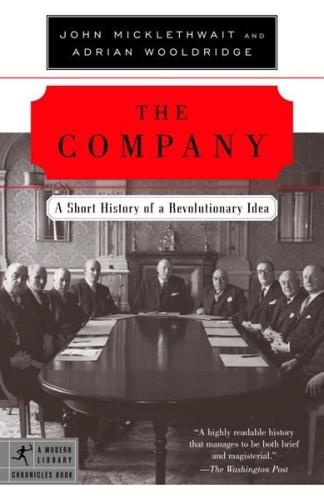
Company: A Short History of a Revolutionary Idea
by
John Micklethwait
and
Adrian Wooldridge
Published 4 Mar 2003
The word compagnia is a compound of two Latin words (cum and panis) meaning “breaking bread together.” Like their Venetian equivalents, the compagnie became more sophisticated as time went by, trying to attract investment from outside the family circle. Perhaps as early as 1340, they introduced double-entry bookkeeping, largely to keep their foreign offices honest. A Genoese merchant would record money sent to his agent in Bruges as “paid” in his accounts, while the latter put down the amount as “received.” And rather than sending coins, the bigger merchants began to trust each other with letters of exchange—a business that Italian banks would dominate.
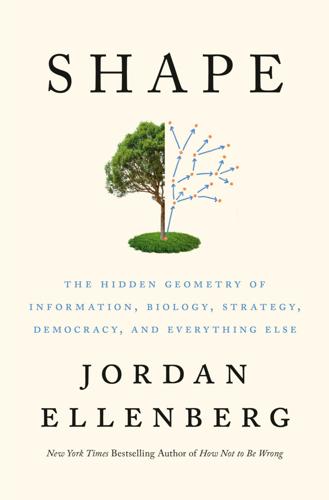
Shape: The Hidden Geometry of Information, Biology, Strategy, Democracy, and Everything Else
by
Jordan Ellenberg
Published 14 May 2021
It’s the same reason there’s a seemingly ineradicable tradition of describing Nim as an “ancient Chinese game,” though this claim appears to be wholly invented, and Nim is first attested in a sixteenth-century book of mathematical puzzles and magic tricks by Fra Luca Bartolomeo de Pacioli, a buddy of Leonardo da Vinci, a Franciscan friar, and the generally recognized “Father of Double-Entry Bookkeeping.” Isn’t that at least as interesting as being ancient and from China?) The thing about Survivor is that the conventional wisdom holds it to be one of the dumbest programs on television when in fact it’s one of the smartest. How many shows are there where you get to watch people think, actually think, in real time?
…
In 1926 he fell ill from a nasty infestation of parasitic amoebas, and he had to move back to the United States. A few years afterward, the stock market went haywire and threw the world into depression, so Elliott had a lot of free time, and a lot of motivation to restore some order to a financial world that no longer fit into neat double-entry bookkeeping. Elliott surely didn’t know about Louis Bachelier’s work on stock prices as a random walk, but if he had, he wouldn’t have given it a minute. He didn’t want to believe stock prices were randomly jittering like dust suspended in fluid. He wanted something more like the comforting physical laws that kept the planets safely in their orbits.
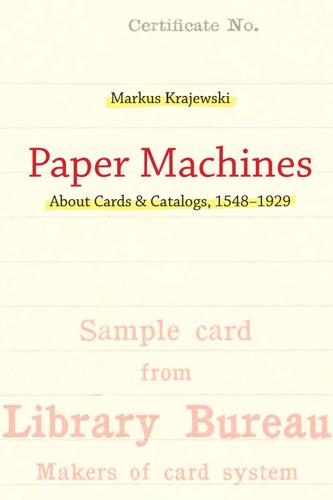
Paper Machines: About Cards & Catalogs, 1548-1929
by
Markus Krajewski
and
Peter Krapp
Published 18 Aug 2011
Complemented by copying procedures that transfer card entries into ledgers and thereby prevent errors, the permanent accounting book comes to dominate bookkeeping, subverting the law by means of widespread practical application.59 “The chamber has agreed to the admissibility of loose-leaf bookkeeping under the condition of the preservation of the principle of order and completeness,” reads a commentary in perfect Nominalstil in the journal Rationelle Betriebsführung.60 By 1929, it becomes clear that the use of permanent accounting books and consequently of index card registers will have no legal consequences. Already by the following year, Büroorganisation trumpets in anticipation of a possible storage area for discarded accounting media: “Bound accounting books for double entry bookkeeping will be relegated to book museums and accounting museums. They shall be replaced by loose sheets of paper in folders, index cards and index card books, etc.”61 The tacitly subverted law grants a fragmented, distributed, and highly adaptable space to the basic accounting technique, whereby the psychotechnically optimized organization of the universal card index machine can rule.
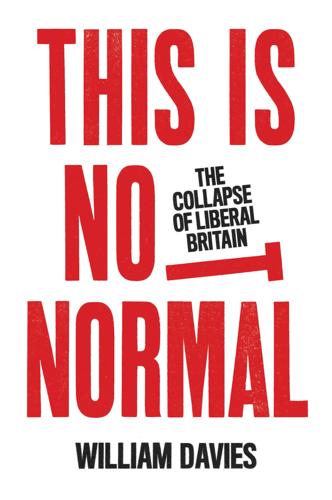
This Is Not Normal: The Collapse of Liberal Britain
by
William Davies
Published 28 Sep 2020
To the great frustration of the Remain campaign, their ‘facts’ never cut through, whereas Leave’s statistics (most famously the £350 million/week price tag of EU membership) were widely accepted. What is a ‘fact’ exactly? Mary Poovey argues that a new way of organising and perceiving the world came into existence at the end of the fifteenth century with the invention of double-entry book-keeping.3 This new style of knowledge is that of facts, representations that seem both context-independent, but also magically slot seamlessly into multiple contexts as and when they are needed. The basis for this magic is that measures and methodologies (such as accounting techniques) become standardised, but then treated as apolitical, thereby allowing numbers to move around freely in public discourse without difficulty or challenge.
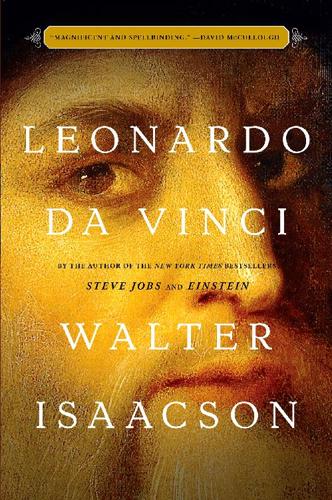
Leonardo Da Vinci
by
Walter Isaacson
Published 16 Oct 2017
In 1472 there were eighty-four wood-carvers, eighty-three silk workers, thirty master painters, and forty-four goldsmiths and jewelry craftsmen working in Florence. It was also a center of banking; the florin, noted for its gold purity, was the dominant standard currency in all of Europe, and the adoption of double-entry bookkeeping that recorded debits and credits permitted commerce to flourish. Its leading thinkers embraced a Renaissance humanism that put its faith in the dignity of the individual and in the aspiration to find happiness on this earth through knowledge. Fully a third of Florence’s population was literate, the highest rate in Europe.
…
“Proportion is not only to be found in number and measure, but also in sounds, weights, times and places and every force that exists,” he wrote.6 LUCA PACIOLI One of Leonardo’s close friends at Milan’s court was Luca Pacioli, a mathematician who developed the first widely published system for double-entry bookkeeping. Like Leonardo, he was born in Tuscany and attended only an abacus school, which provided a trade education in arithmetic but no Latin. He worked as a wandering tutor to boys from wealthy families and then became a Franciscan friar who never moved into a monastery. He wrote a math textbook in Italian, rather than Latin, which was published in Venice in 1494; it thus became part of the explosive spread of learning in vernacular languages triggered by the printing press in the late fifteenth century.
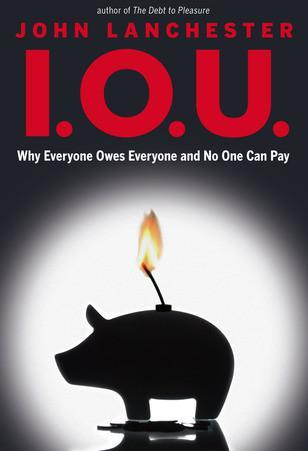
I.O.U.: Why Everyone Owes Everyone and No One Can Pay
by
John Lanchester
Published 14 Dec 2009
The man who wrote down the method for gathering and recording the relevant information was Luca Pacioli, a Franciscan monk and friend of both Piero della Francesca and Leonardo da Vinci, whose assistant he was for many years. Pacioli wrote Summa de Arithmetica, the book which laid out the method of double-entry bookkeeping which is still in use in more or less every business in the world. (He also wrote about magic, in the sense of conjuring. I’d like to think he would have enjoyed the old joke about accountants: “What’s two plus two?” “What would you like it to be?”) There’s something amazing about the fact that a method used in Venice in the thirteenth century and written down in Tuscany in the fifteenth should still be in daily use in every financial enterprise in the developed world.
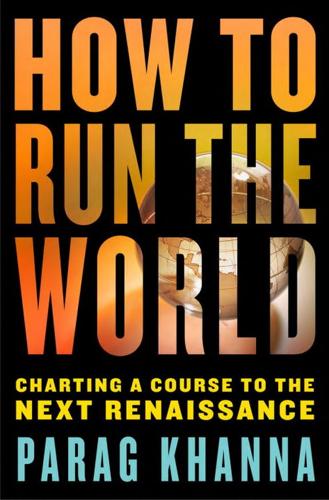
How to Run the World: Charting a Course to the Next Renaissance
by
Parag Khanna
Published 11 Jan 2011
Even as his Oration on the Dignity of Man was taken as a secular manifesto, in fact his true effort was to reconcile the church with classical strains of logic such as Aristotle’s. His lesson for today’s age is that our fruitless debates between the West and Islam should instead become a more inclusive discourse on achieving spiritually and morally informed governance. Similarly, the Renaissance witnessed innovations such as double-entry bookkeeping and large-scale credit, bringing new commercial opportunities to Europeans whose geographic and cultural horizons were gradually opening as Crusaders returned home. The manner in which the current economic turbulence has shaken up our financial architecture could do the same. Chastened bankers from Lehman Brothers are actually leading an effort to revise models of financial analytics to emphasize value creation, not just wealth creation.
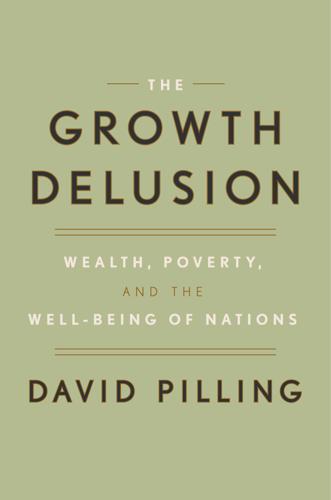
The Growth Delusion: Wealth, Poverty, and the Well-Being of Nations
by
David Pilling
Published 30 Jan 2018
Though almost everyone has heard of GDP, few know it was invented as recently as the 1930s as a tool to counter the Great Depression and then reworked as a means to prepare for the Second World War. The first thing to understand is that the economy is not a natural phenomenon, a truth to be discovered. Before 1930 it practically didn’t exist. It is a man-made thing, like cotton candy or car insurance or double-entry bookkeeping. If GDP were a person, it would be indifferent, blind even, to morality. It measures production of whatever kind, good or bad. GDP likes pollution, particularly if you have to spend money clearing it up. It likes crime because it is fond of large police forces and repairing broken windows.
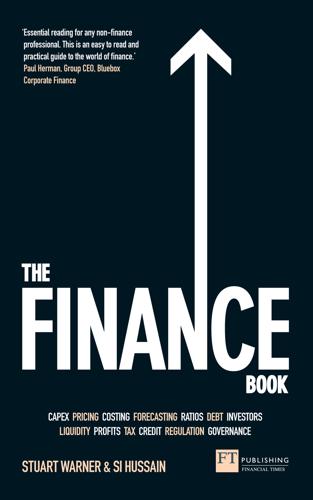
The Finance Book: Understand the Numbers Even if You're Not a Finance Professional
by
Stuart Warner
and
Si Hussain
Published 20 Apr 2017
Optional detail Debtor and creditor days Debtor and creditor days can be calculated by using the following formulas: (See Chapter 24 Working capital and liquidity management). The debit and credit confusion The terms ‘debtors’ and ‘creditors’ are derived from the terms ‘debits’ and ‘credits’. Debits and credits are part of the system of double entry bookkeeping underpinning accounting. It’s the perspective which is confusing to many. As we saw earlier, debtors are business assets because cash will be received in the future. However, the word debtors is related to the word ‘debt’, which has negative connotations. This is also because banks use the term ‘debit’ to refer to overdrawn cash balances.
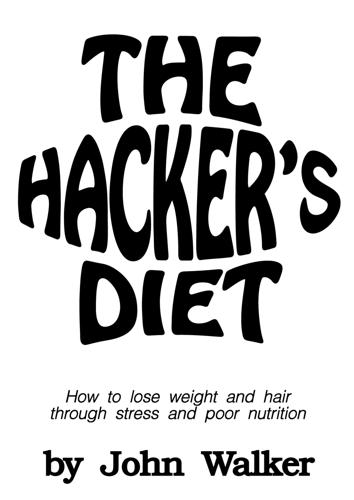
The Hacker's Diet
by
John Walker
Also, you'll come to learn which restaurant foods are roughly equivalent in calories to your normal allocation for each meal. As this happens, you'll probably conclude that meal planning, which originally seemed likely to endow something you once derived great joy from, eating, into an exercise with all the romance and excitement of double-entry bookkeeping, is actually liberating. No longer do you have to worry whether you're eating too much or too little. No more do you have to forego something you like because you gulped too much at lunchtime. Now you'll be able to know, in advance, how much food to make or order, eat everything you make, and enjoy it all without feeling guilty.
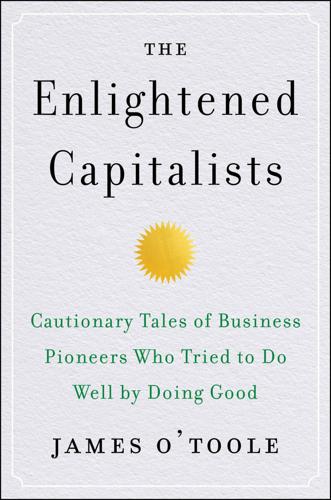
The Enlightened Capitalists
by
James O'Toole
Published 29 Dec 2018
The record confirms that those two concerns were the only deep, abiding ones in his life—with a strong accent on the latter.1 Datini’s documents have been an invaluable resource for business historians since they were discovered in the 1870s, providing insights into accounting, finance, marketing, and strategic methods of the distant past—a past that looks remarkably like the present. What his vast archive demonstrates is that Datini was quite nearly a modern businessman. According to Charles Handy, Datini used double-entry bookkeeping a century before it is said to have been invented by an Italian monk.2 Datini began his career as an importer in his Tuscan hometown of Prato, eventually expanding his operations internationally with offices as far away as France, Spain, Belgium, and England. For most of his career he was a workaholic.
…
Ford Motor Company and, 113–15, 438 economic growth and standard of living, xxxv economies of scale and, 440 environmental issues, responses to, 443, 459 ethical investing and, 459 future of, 473 history of, xxii hollow virtual corporations, 473–75, 477 “impact” or ESG (environmental, social, governance) investors, 459–60 Johnson’s Or Forfeit Freedom and, 153–55 new social contract for, xiv–xv opposition to corporate do-goodism, xxxvi, xxxvii “primacy of shareholder value,” xli, 113–14, 373, 395, 423–24, 425, 438–39 proponents of corporate do-goodism, xxxviii–xl separation of “ownership” from professional management and, 47 shareholder response to corporate misconduct, 429 short-termism of executives, xiv, 67–68, 113, 115, 116, 197–98, 268, 281, 395, 423, 446 socially virtuous practices and, xiii, xiv, xxxvi, xlii, 373, 438, 476 Up the Organization and management, 280 See also specific business leaders; specific companies Correnti, John, 275–76 Costco, 197 controlling labor costs at, 101 Couette, Yves, 391 Cousteau, Jacques, 307 Cray, Seymour, 244–45, 246 Cray Research, 246 credit unions, 419 Crompton, Samuel, 4, 9 Cummins Engine Corporation, 313, 314–19, 424, 426 company ownership and, 317, 395 environmental practices, 316–17 ethics-focused organizational culture, 315–16 expansion of, 315 financial and environmental problems under Schacht, 318–19 headquarters, Columbus, Ind., 315 hiring practices, 316, 317–18 labor unions and, 316 minority hiring at, 316 “organizational entropy” and, 319 profitability and, 315 Schacht as CEO, 318 test of values (2010), 319 customers Body Shop and, 352–53 corporate social responsibility and, xxxviii–xxxix Herman Miller Company and, 237 John Lewis Partnership and, 128 Lewis and, 122 Lincoln’s philosophy and, 96 Marks & Spencer and, 210, 211–12, 213–17 no consumer demand for virtue, 429 Nucor and, 275 Owen’s ethical practices and, 8, 19 Penney and Penney Principles, 33, 37–39, 45–46 SWA and, 293–94 Dale, David, 11–12, 27 Dalton, John, 10 Dana, 424 D’Antonio, Michael, 80, 92, 489n Hershey, 489n Datini, Francesco (the Merchant of Prato), xxii, xxiii–xxv, xxxvii, xlii, 362, 396, 444 double-entry bookkeeping, xxiii foundation established by, xxv historical record of, xxiii motto of, xxiii Davids, Bob, 285–86 Davis, Jacob, 176–77, 179 Davis, Simon, 179–80 “Davos Conscience,” xii Davos World Economic Forum, 461 2018: social responsibility discussion, xiv Dayton-Hudson (now Target), 424 Deere, 424 Deere, John, xxxiii Defoe, Daniel, 3, 4 Della Femina, Jerry, 172 Del Monte, 470 De Pree, Dirk Jan (D.J.), 227–30 entrepreneurial skills, 228 founding of Herman Miller Company, 227 human-centered organizational culture and, 229–30 legacy of, 228–30 religious motivation for virtuous practices, 227–28 De Pree, Hugh, 230 De Pree, Max, 318, 323, 427 Chappell compared to, 365–66 Christian values and managerial philosophy, 227–28, 231, 360, 365 employee relationships as “covenantal,” 231 ethical principle of respect, 235–36 Herman Miller Company and, 227–42 institutionalization of practices, 435 intellectual influences on, 430 Leadership Is an Art, 231 “organizational entropy” and, 242, 319, 426 retirement from the Herman Miller board, 240 “servant leadership” and, 233, 317 “theory fastball” (philosophy of enlightened leadership), 228, 231–38 “tribal story telling,” 231, 365, 366 Dewhirst, I.
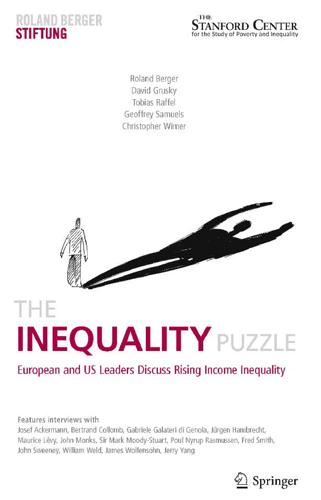
The Inequality Puzzle: European and US Leaders Discuss Rising Income Inequality
by
Roland Berger
,
David Grusky
,
Tobias Raffel
,
Geoffrey Samuels
and
Chris Wimer
Published 29 Oct 2010
Again, going back to the comments I just made, if you list the top one hundred or five hundred CEOs’ compensation in the last five to ten years, I would be very surprised if a disproportionate number of the ones who have received the eye popping packages are not in the financial sector. Second, the Black-Scholes model for the value of stock options makes compensation reports often misleading. For the first time since double-entry bookkeeping, you have an expense that is dragged through the profit-and-loss statement, and if the value of the options goes south, you never reverse the entry. That’s never been done. The thing that bothers me about it is that the man who came up with this formula is one of the architects of Long-Term Capital Management, so I’m not sure I really have a lot of confidence in this valuation formula.

The botany of desire: a plant's-eye view of the world
by
Michael Pollan
Published 27 May 2002
The memes that prove themselves best adapted to their “environment”—that is, the ones that are most helpful for people to keep in their brains—are the ones most likely to survive and replicate and become widely regarded as good, true, or beautiful. Culture at any given moment is the “meme pool” in which we all swim—or rather, that swims through us. Cultural change occurs whenever a new meme is introduced and catches on. It might be romanticism or double-entry bookkeeping, chaos theory or Pokémon. (Or the notion of memes itself, which seems to be catching on today.) So where in the world do new memes come from? Sometimes they spring full-blown from the brains of artists or scientists, advertising copywriters or teenagers. Often a process of mutation is involved in the creation of a new meme, in much the same way that mutations in the natural environment can lead to useful new genetic traits.
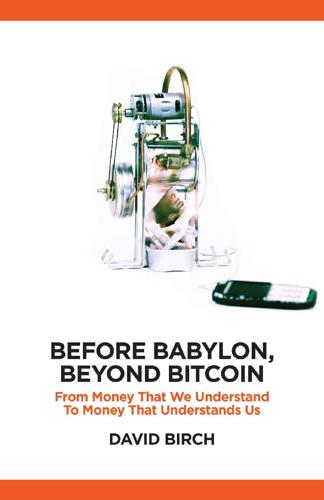
Before Babylon, Beyond Bitcoin: From Money That We Understand to Money That Understands Us (Perspectives)
by
David Birch
Published 14 Jun 2017
The distributed ledger technology of the tally had been used to convert a means for deferred payment into a store of value and then into a means of exchange, and the sticks remained in widespread use for hundreds of years. The Bank of England, being a sensible and conservative institution naturally suspicious of new technologies, continued to use wooden tally sticks until 1826: some 500 years after the invention of double-entry bookkeeping and 400 years after Johannes Gutenberg’s invention of the printing press. At this time, the Bank came up with a wonderful British compromise: they would switch to paper but they would keep the tallies as a backup (who knew whether the whole ‘printing’ thing would work out, after all) until the last person who knew how to use them had died.
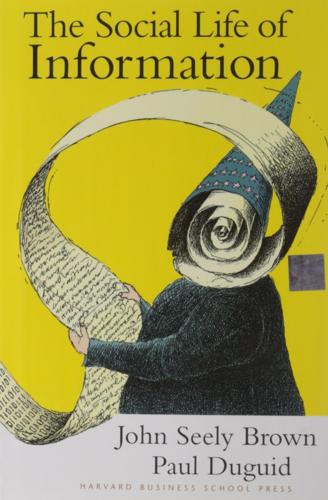
Social Life of Information
by
John Seely Brown
and
Paul Duguid
Published 2 Feb 2000
When people are championing the decline of old institutions and the rise of new ones, for example, it's always worthwhile to look around to see if there are any old ones that sweeping visions take for granted. For instance, while many people talk about the new landscape of business and finance, it's worth noting that the "bottom line" is a 600-year-old relic from double-entry bookkeeping. The institutions of profit-and-loss accounting still exert remarkable influence over our thinking. Reengineers may have told us all to "forget all we know," but few of those caught up in reengineering were allowed to forget the bottom line. Or, again, while people rightly talk so enthusiastically about the new economics of e-business, the power of the Web, and the emerging markets, it's worth noticing how much is predicated on the continuation of advertising.

How to Speak Money: What the Money People Say--And What It Really Means
by
John Lanchester
Published 5 Oct 2014
Pacioli didn’t invent the set of accounting techniques he described, which were in use in mainly Venetian banking circles, but he was the first person to write them down. It’s a remarkable fact that every business in the world uses them on a daily basis more than five hundred years later. The fundamental feature of Pacioli’s system, known as double-entry bookkeeping, is that everything is recorded twice, as an asset in one place and a liability in another, and that the two sides of the balance sheet are always equal: assets = liabilities + equity. There’s a beautiful descripton of the system’s impact in James Buchan’s book Frozen Desire: To be able to keep books in double-entry is to have a machine for calculating the world.
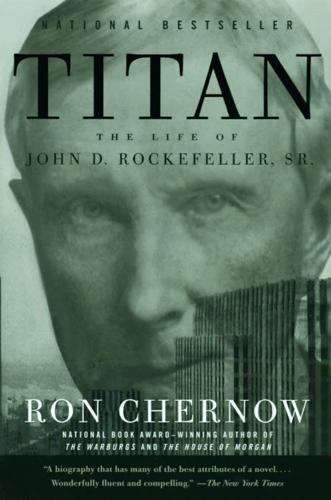
Titan: The Life of John D. Rockefeller, Sr.
by
Ron Chernow
Published 1 Jan 1997
Following his father’s suggestion, John paid forty dollars for a three-month course of study at E. G. Folsom’s Commercial College, a chain college with branches in seven cities. The Cleveland branch occupied the top floor of the Rouse Building, the town’s premier office building, which overlooked the Public Square. It taught double-entry bookkeeping, clear penmanship, and the essentials of banking, exchange, and commercial law—the sort of purposeful courses that appealed to John. By the time his studies ended in the summer of 1855, he had turned sixteen and was ready to flee the traumas of his family life by focusing his energies on a promising business situation.
…
In The Protestant Ethic and the Spirit of Capitalism, Max Weber identified “rational bookkeeping” as integral to capitalism’s spirit and organization.36 For Joseph Schumpeter, capitalism “turns the unit of money into a tool of rational cost-profit calculations, of which the towering monument is double-entry bookkeeping.”37 It thus seems fitting that John D. Rockefeller, the archetypal capitalist, betrayed a special affinity for accounting and an almost mystic faith in numbers. For Rockefeller, ledgers were sacred books that guided decisions and saved one from fallible emotion. They gauged performance, exposed fraud, and ferreted out hidden inefficiencies.
…
It was out in Ohio, under the ministration of a dear old minister, who preached, ‘Get money; get it honestly and then give it wisely.’ I wrote that down in a little book.”74 This echoed John Wesley’s dictum, “If those who ‘gain all they can’ and ‘save all they can,’ will likewise ‘give all they can,’ then the more they will grow in grace.”75 Rockefeller operated by such spiritual double-entry bookkeeping, with his charity serving, in time, as incontestable proof of his fortune’s purity. It might well be that his early commitment to charity gave him some inner license needed to pursue wealth with unparalleled—and at times unprincipled—vigor. As Max Weber observed, ascetic Christianity was a matchless breeding ground for would-be businessmen.
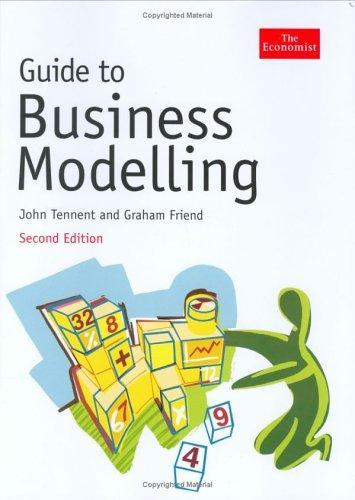
Guide to business modelling
by
John Tennent
,
Graham Friend
and
Economist Group
Published 15 Dec 2005
The content of the output sheets was the subject of Chapter 3. Templates for the profit and loss, balance sheet and cash flow can also be created if these form part of the solution. During the model-building process the financial statement templates can be completed continuously, as if performing double-entry book-keeping. The modeller can ensure the accuracy of the work by checking that the balance sheet continues to balance throughout the development of the model. Sheets containing the input templates should also be created at the start of the process. Populate input templates with base or test data The input templates must be populated with data to allow model development to continue.
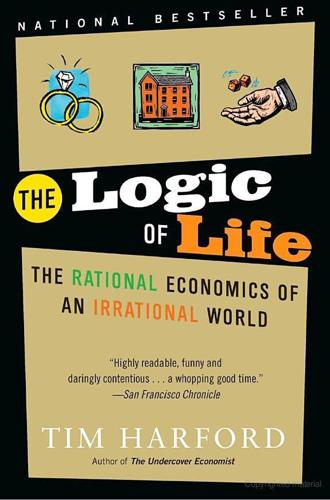
The Logic of Life: The Rational Economics of an Irrational World
by
Tim Harford
Published 1 Jan 2008
By 1800, the dawn of the Industrial Revolution, with a billion people in the world, the innovation rate would have risen to one stunning idea every year. By 1930 it would be one world-changing idea every six months. With six billion minds on the planet we should now be producing this kind of idea every two months; such ideas could be anything from double-entry bookkeeping to crop rotation. It’s an absurd, grotesquely oversimplified model; it also fits the data perfectly. Kremer suggests simply taking population growth as a measure of technological progress: The faster the human population is able to grow, the more advanced technology must have become. It turns out that these eminently Malthusian assumptions fit very nicely indeed, at least until 1960 and the pill.
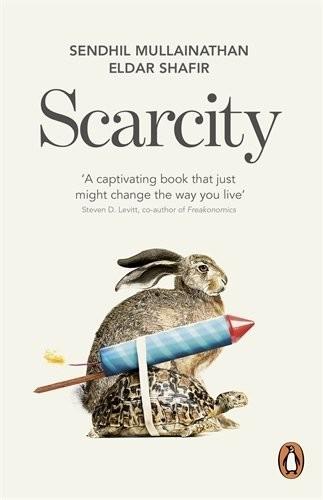
Scarcity: The True Cost of Not Having Enough
by
Sendhil Mullainathan
Published 3 Sep 2014
This prevented the commingling of home money and business money that makes it difficult to determine how much they were spending at home versus how much the business was earning. (Some of the women kept one wad of cash in their bra’s left cup, and the other in the right cup.) This is not quite double-entry bookkeeping, but it was effective and simple. It economized on bandwidth and preserved most of the benefits. Schoar collected the best rules of thumb and designed a different “financial education” class based on them. Her class was shorter and much easier to grasp. It used a lot less bandwidth, and this showed up in the data.
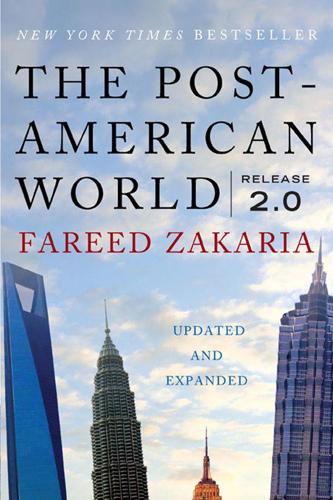
The Post-American World: Release 2.0
by
Fareed Zakaria
Published 1 Jan 2008
Western styles have become the standard mode of work dress for men, signifying modernity. The Death of the Old Order Westernization is not merely about appearances. Executives all over the world manage their companies by means of what we could call “standard” business practices. The truth is that these standards, from double-entry bookkeeping to dividends, are all Western in origin. And it’s not just true of business. Over the last two centuries, and especially the last two decades, government institutions everywhere have also become more alike, encompassing parliaments, regulatory agencies, and central banks. Surveying several countries in Europe and Latin America, two scholars found that the number of independent regulatory agencies (American-style bodies) rose sevenfold between 1986 and 2002.16 Even politics has an increasingly familiar feel across the globe.
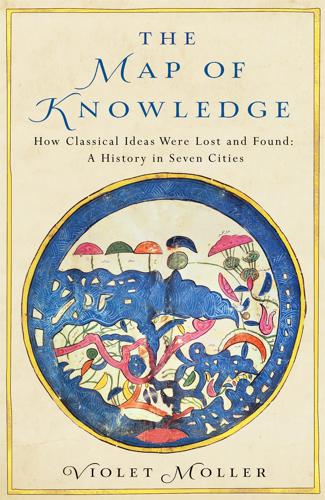
The Map of Knowledge: How Classical Ideas Were Lost and Found: A History in Seven Cities
by
Violet Moller
Published 21 Feb 2019
His itinerant lifestyle made him one of the best-connected men of his time, at home in every noble court and university in northern Italy. He stayed with the architect Leon Battista Alberti in Rome, visited Naples and, in Florence, lived with Leonardo da Vinci for a time. He holds the important, if unexciting, epithet, ‘the father of accounting’, thanks to his lucid explanation of the ‘method of Venice’ (now known as double-entry bookkeeping), which was used by generations of merchants. Pacioli’s mathematical interests were especially broad; he wrote on arithmetic, was an expert on Euclid and regularly lectured on The Elements, producing new editions in both Latin and Italian. He brought all his knowledge together in his magnum opus, the Summa de arithmetica, written in Italian so as to be accessible to as many people as possible, and published in Venice, in 1494.
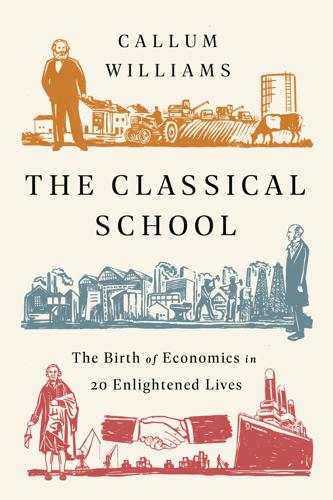
The Classical School
by
Callum Williams
Published 19 May 2020
I am grateful to Simon Cox for suggesting this argument. 7. Some historians have suggested that the “bullionist” maxim was in fact around for hundreds of years before the mercantilists made it theirs. Coleman, however, points out that “the idea of the ‘balance’ of trade… probably derived from Italian double-entry book-keeping practices… marked advances in the analytical treatment of the subject|”. Coleman’s paper on mercantilist thinking is the best attempt to explain why mercantilist ideas emerged, though he largely focuses on England. 8. Quoted in Murray Rothbard, An Austrian Perspective on the History of Economic Thought, vol. 1. 9.

Green Swans: The Coming Boom in Regenerative Capitalism
by
John Elkington
Published 6 Apr 2020
It was supposed to provoke deeper thinking about capitalism and its future, even if many early adopters understood the concept as a balancing act, adopting a trade-off mentality. With the financial (sic) element seen as dominant, social, or (even more likely) environmental, trade-offs were only to be expected. As it happens, the concept surfaced exactly 500 years after Luca Paccioli published the world’s first treatise on double-entry bookkeeping, the cornerstone for single bottom line thinking. It is now clear that the advent of the triple bottom line was a key branching point. It helped inspire and was followed by Double and Quadruple Bottom Lines; Social Return on Investment; multiple capital models; Full Cost Accounting; ESG (a framework focusing investors and financial analysts on Environmental, Social, and Governance factors); the Environmental Profit & Loss approach pioneered by Trucost, Puma, and Kering; Net Positive; Blended and Shared Value; Integrated Reporting; Impact Investment; and a range of proprietary versions, including consultancy BCG’s Total Societal Impact framework.

Life After Google: The Fall of Big Data and the Rise of the Blockchain Economy
by
George Gilder
Published 16 Jul 2018
Like Keats’s stout Cortez, high on a cliff in Central America, I found myself staring at the oceanic expanse of a new realm of economics, driven by new forms of money. After all, enabling all economic growth over the millennia had been new forms of money. Mired in the impossibly sticky sloughs of barter, world wealth would be a tiny fraction of what it is. Double-entry bookkeeping had fostered the commercial revolution in Venice. Now the bitcoiners were speaking of “triple-entry bookkeeping” with a new permanent ledger in the blockchain. It is indisputable that the invention of money and finance was indispensable for the accumulation of all the world’s fortunes. The worth of money springs from its power to enable and measure trillions of transactions and to store value that is portable over time and space.
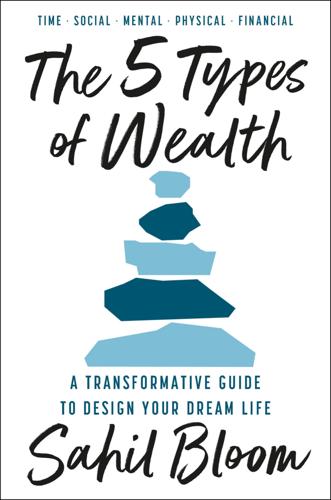
The 5 Types of Wealth: A Transformative Guide to Design Your Dream Life
by
Sahil Bloom
Published 4 Feb 2025
Peter’s Basilica, Jakob Fugger was there (repayment of this loan required a massive sale of indulgences—sin-forgiveness tickets—to regular citizens, a practice that drew the ire of a reformer named Martin Luther, who went on to lead the Protestant Reformation).[2] Fugger’s money—and, by extension, his power and influence—shaped the course of the European continent. His innovative use of accounting methods—he was one of the first to use double-entry bookkeeping, and he established the now standard practice of consolidating multiple operations into a single set of financial statements—allowed him to keep tabs on the entirety of his financial empire, which was vast during his later years. By the time of his death, Jakob Fugger had amassed a fortune equal to $400 billion in today’s money and that represented approximately 2 percent of Europe’s GDP at the time.
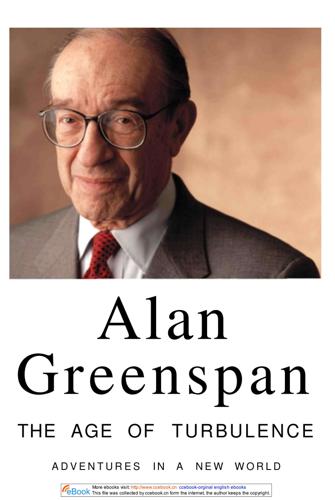
The Age of Turbulence: Adventures in a New World (Hardback) - Common
by
Alan Greenspan
Published 14 Jun 2007
I cannot count how many letters I received from Capitol Hill in the 1990s outlining one scheme or another to spend more or tax less, with the pay-go requirement 233 More ebooks visit: http://www.ccebook.cn ccebook-orginal english ebooks This file was collected by ccebook.cn form the internet, the author keeps the copyright. T H E AGE OF T U R B U L E N C E satisfied by some sleight-of-hand financing obscurity, the purpose of which was to hide the cost of the scheme. In the Congress, double-entry bookkeeping had become a lost art. It finally dropped the pretense. During the final year of the Clinton administration, Congress had ignored its self-imposed discretionary spending caps to legislate an estimated $ 1 trillion of additional spending over ten years. Without this spending, the record $237 billion surplus in 2000 would have been even larger.
…
The beauty of a market system is that when it is functioning well, as it does almost all the time, it tends to create its own balance. The populist view is equivalent to single-entry bookkeeping. It scores only credits, such as the immediate benefits of lower gasoline prices. Economists, I trust, practice double-entry bookkeeping. Burdened by its dearth of meaningful economic policy specifics, populism, to attract a following, has to claim a moral justification. Accordingly, 338 More ebooks visit: http://www.ccebook.cn ccebook-orginal english ebooks This file was collected by ccebook.cn form the internet, the author keeps the copyright.
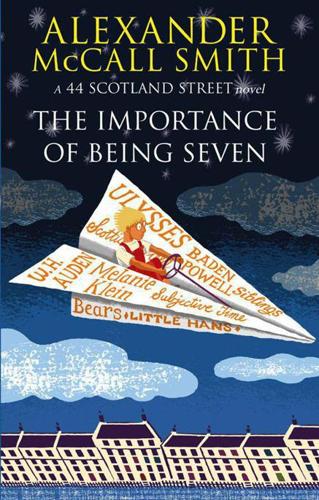
The Importance of Being Seven
by
Alexander McCall Smith
Published 1 Jan 2010
Anything good, anything positive, was seen by him as a dubious privilege that would be paid for dearly; even a fine day – in Scotland a rare gift of those most fickle local weather gods – would be paid for by cold and damp later on. The bill for a warm spring was a miserable, rain-sodden summer; the bill for happiness was subsequent anxiety about the loss of exactly that happiness – it was a bleak system of double-entry book-keeping, but one that had a firm root in the Scottish psyche. And was that what she was like, she asked herself. The egg boiled, and Elspeth sat down to eat it. Matthew sat at the table opposite her. He was jumpy – she could tell that. And this nervousness increased until the telephone rang and he shot up from his chair to answer it.
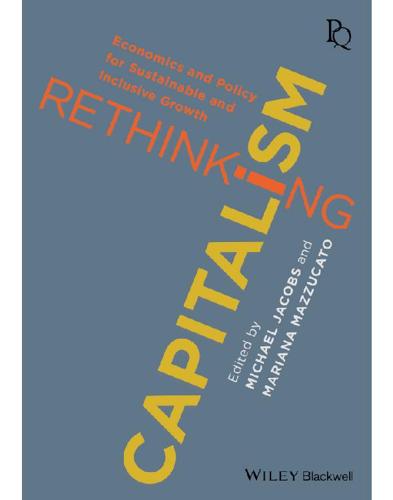
Rethinking Capitalism: Economics and Policy for Sustainable and Inclusive Growth
by
Michael Jacobs
and
Mariana Mazzucato
Published 31 Jul 2016
But, as anyone who understands monetary operations knows, this gets things completely backwards.20 To see this, one can run through the balance sheet entries, tracing the debits and credits that arise as the government spends, taxes and issues bonds.21 Or, perhaps more straightforwardly, one can rely on the internal logic of double-entry bookkeeping and simply interpret the sector balance model. Either way, careful analysts will discover that deficits add to (rather than subtract from) the financial balances of other economic agents. Simply put, government deficits are a flow of funds that increases the stock of net financial assets to the non-government sector.22 The government’s deficits (flow) accumulate to financial debt (stock).
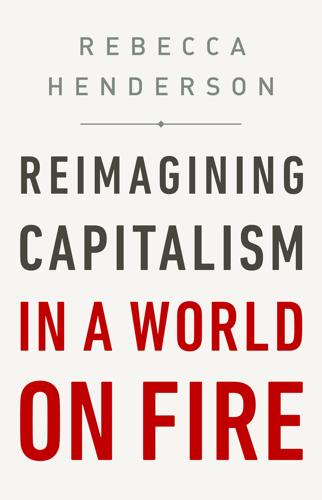
Reimagining Capitalism in a World on Fire
by
Rebecca Henderson
Published 27 Apr 2020
Give Investors Better Data It took me a surprisingly long time to embrace the idea that accountants hold the key to saving civilization. Even after I’d read Jacob Soll’s wonderful book, The Reckoning: Financial Accountability and the Rise and Fall of Nations—a blow by blow account of how the invention of double entry bookkeeping enabled the creation of the modern state—I secretly thought of accounting as the dusty, dry part of business—about as interesting as plumbing. But then I noticed a strange thing. I knew plenty of businesspeople who were only mildly worried about the fact that we were running our entire economy on the basis of the idea that generating massive amounts of CO2 typically doesn’t cost firms a dime, or that it was equally costless (to the firm) to hollow out a community, pay one’s employees bottom dollar, and push for tax cuts.
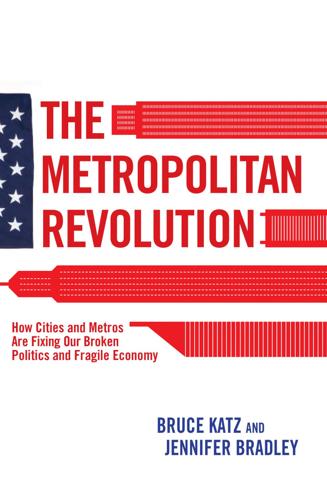
The Metropolitan Revolution: How Cities and Metros Are Fixing Our Broken Politics and Fragile Economy
by
Bruce Katz
and
Jennifer Bradley
Published 10 Jun 2013
But in general, casting a wider net makes it more likely that one person’s idea will interact usefully with another person’s idea and that something 02-2151-2 ch2.indd 37 5/20/13 6:48 PM 38 NYC: INNOVATION AND THE NEXT ECONOMY beneficial will emerge. Steven Johnson points to fourteenth-century Italian market cities as examples of networked economies: these were the places from which emerged double-entry bookkeeping—the notion of recording each transaction as a debit or a credit, which was one of financial accounting’s biggest innovations. This network effect applies to the game-changers approach as well: “They didn’t magically create some higher-level group consciousness. They simply widened the pool of minds that could come up with and share good ideas.

Adapt: Why Success Always Starts With Failure
by
Tim Harford
Published 1 Jun 2011
Evolution is effective because, rather than engaging in an exhaustive, time-consuming search for the highest peak – a peak that may not even be there tomorrow – it produces ongoing, ‘works for now’ solutions to a complex and ever-changing set of problems. In biological evolution, solutions include photosynthesis, pairs of eyes and mothers’ milk. In economic evolution, solutions include double-entry book-keeping, supply-chain management and ‘buy one, get one free’. Some of what works seems to be perennial. The rest, such as being a Tyrannosaurus rex or the world’s most efficient manufacturer of VHS video cassettes, is rooted in a particular place and time. We know that the evolutionary process is driven by variation and selection.
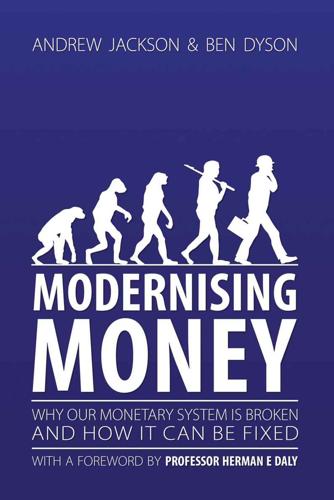
Modernising Money: Why Our Monetary System Is Broken and How It Can Be Fixed
by
Andrew Jackson (economist)
and
Ben Dyson (economist)
Published 15 Nov 2012
The social unrest this created would be so great that the only way to stop society breaking down (or the rulers being overturned) would be to periodically forgive everyone their debts – a debt jubilee. 4. These innovations included: courier services to convey messages; carrier services for the transport of goods; double entry bookkeeping; the extension of joint enterprises for longer durations (previously these had been established for single ventures and then dissolved); the accepting of deposits by businesses for funding purposes and the payment of interest on them (rather than a share in the profits); and bills of exchange (which allowed local payments to be made without the need to transport coins or bullion). 5.
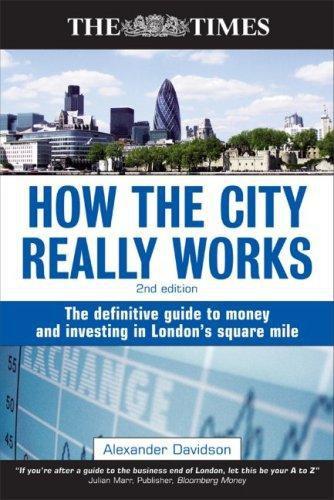
How the City Really Works: The Definitive Guide to Money and Investing in London's Square Mile
by
Alexander Davidson
Published 1 Apr 2008
Commercial banks today Commercial banks are mainly involved in deposit taking and lending. Deposits build up when people leave surplus money in saving accounts. When banks lend money to their clients, it comes from other banking clients. In effect, what goes into one person’s account as a loan must come out of another’s. The banking system is said to be like double-entry bookkeeping. 20 HOW THE CITY REALLY WORKS __________________________________ Banks pay a small rate of interest on cash deposited, and lend out much of it at a much higher rate, making a margin on the difference. In common alone with the government, they keep bank accounts with the Bank of England.
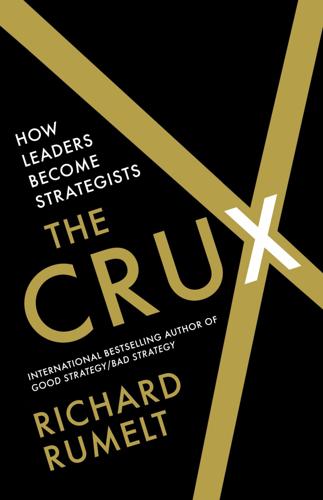
The Crux
by
Richard Rumelt
Published 27 Apr 2022
Going into users’ homes, Intuit managers found that the users of the original Quicken checkbook balancing program were actually using it as an accounting tool for small businesses. However, most had little familiarity with formal accounting terms. Intuit then built QuickBooks to minimize the appearance of double-entry bookkeeping. Brad Smith, Intuit CEO from 2008 to 2018, said, “What you get from a follow-me-home you can’t get from a data stream. You’ve got to look somebody in the eye and feel the emotion.”3 ‘Indego Materials’ faced a threat and handled it with an intense focus on coupling with key customers. Powdered metals are used to fabricate a wide variety of items, ranging from toys to jet-engine blades.

Empire of the Sum: The Rise and Reign of the Pocket Calculator
by
Keith Houston
Published 22 Aug 2023
Almost coincidentally, in posing a problem regarding rabbit populations, Leonardo—later called Fibonacci, probably after an old family surname—inadvertently stamped his name in the annals of mathematical history. Today, he stands with Al-Khwārizmī as one of the progenitors of the way we count and calculate. From the beginning, there was bad blood between the “algorists” and the “abacists.” In Italy, in Fibonacci’s time, merchants embraced the new numerals, developing double-entry bookkeeping as they did so to make even better use of them. But the forms of the new numbers were still fluid, and fraud was rife. Perhaps as a result, in 1299 the city of Florence forbade the use of Hindu-Arabic numerals in banks. A later edict in Padua stated that book prices had to be listed in Roman numerals.92 Outside Italy, Roman numerals clung on in mercantile circles until the fifteenth century and, in more conservative environs such as monasteries, even longer than that.93 Even in 1543, Nicolaus Copernicus’s De revolutionibus orbium coelestium (On the Revolutions of the Heavenly Spheres), a text widely considered to mark the start of the Scientific Revolution, contained a mix of Roman, Hindu-Arabic, and written-out numbers.94 Ultimately, however, the advantages of Hindu-Arabic numerals became too hard to ignore.

The Measure of Progress: Counting What Really Matters
by
Diane Coyle
Published 15 Apr 2025
But t here is a key piece missing in the national accounts, the consumer transaction with the digital company. The national accounts are in effect quadruple entry: double-entry accounting for both the seller and buyer in a transaction. As the ONS national accounts handbook explains: The traditional double-entry book-keeping principle, whereby a transaction gives rise to a pair of matching debit and credit entries within the accounts of each of the two parties to the transaction, is a basic axiom of economic accounting. For example, recording the sale of output requires not only an entry in the production account of the seller but also an entry of equal value, often described as the counterpart, in the seller’s financial account to record the cash, or short- term financial credit, received in exchange for the output sold.
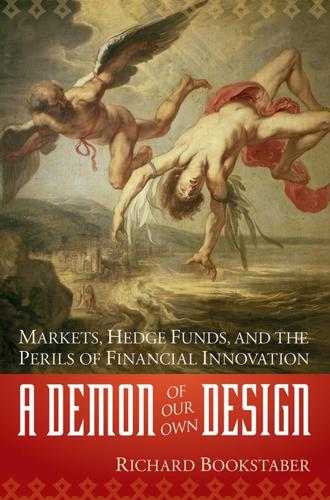
A Demon of Our Own Design: Markets, Hedge Funds, and the Perils of Financial Innovation
by
Richard Bookstaber
Published 5 Apr 2007
As a favor to one of his patrons, Pacioli included in the Summa a discussion on the Venetian method of bookkeeping. The Venetian method recorded every business transaction in two parts, a debit (an account that received funds) and a credit (an account that provided funds). If that sounds familiar, it is; this is the source of double-entry bookkeeping, which makes up the core premise of accounting 500 years later. The propagation 136 ccc_demon_125-142_ch07.qxd 2/13/07 1:46 PM Page 137 COLOSSUS of the Venetian method through Pacioli’s work was a key ingredient in the voyages of discovery of the sixteenth century. It provided a reliable system to record investments and returns, essential in attracting wealthy merchants to provide the backing required for these voyages, which opened the way for trade with the New World and the Far East.8 DA VINCI’S ACCOUNTANT IS STILL KEEPING OUR BOOKS This approach has remained the foundation of accounting to the present, first blossoming in the United States with the building of railroads.

The Blockchain Alternative: Rethinking Macroeconomic Policy and Economic Theory
by
Kariappa Bheemaiah
Published 26 Feb 2017
But in the meantime the reliable data (i.e., precise information that is free of bias and manager manipulation) was kept in the hands of the executives and obscured from view. The dichotomy between the reliable and relevant reported data stems from the conflicting interests of businesses and investors. The source of the contradiction is not double-entry bookkeeping, but rather it is due to bias. Information producers, in this case managers and executives, are constantly faced with a conundrum: do they provide the most objective and true version of the information regarding their business (income and cash flow generation capability, assets and liabilities, etc.), or should they only provide the most relevant information that investors would normally seek?
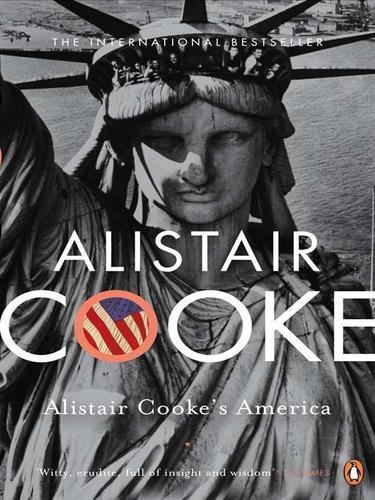
Alistair Cooke's America
by
Alistair Cooke
Published 1 Oct 2008
His responsibility to the Cleveland money men at an end, Rockefeller and his partner pooled their savings and invested all of $4,000 in the candlemaker’s refinery. Very soon, Rockefeller got richer men to build more refineries, and richer men still. Since his habits were more austere than theirs, he absorbed them. And then he sat back and he dreamed a dream. He was of the type of Columbus, and Fray Marcos, but with a gift for double-entry bookkeeping. There really wasn’t anything to stop him making his refinery business in Cleveland the biggest in Ohio, the biggest in the Midwest, in America. Why not the world? When he was thirty, he formed the Standard Oil Company of Ohio and bought twenty-five refineries. Rockefeller built a monopoly by means both genteel and ruthless, and it was rudely hinted that he had in the palm of his hands the best state legislatures and United States Senators that money could buy.

Human Frontiers: The Future of Big Ideas in an Age of Small Thinking
by
Michael Bhaskar
Published 2 Nov 2021
There are limits to incrementalism: you can improve the horse or cart or embellish Newtonian mechanics all you like, but doing so doesn't deliver the automobile or special relativity. Big ideas can be found in all areas of human endeavour. You find the above pattern with linguistic philosophy; the Internet; human rights; the concept of zero; the steam engine; the iPhone; utilitarianism; calculus; the periodic table; helicopters; entropy; double-entry bookkeeping; written constitutions; writing itself; deep machine learning techniques; Jacobean tragedy; Spacewar! and Grand Theft Auto; information theory, quantum theory and game theory; Cartesian grids, rationality and ego. This is an ecumenical approach to ideas, but only by taking such an approach can we see the overarching picture of change, or its absence

The Ascent of Money: A Financial History of the World
by
Niall Ferguson
Published 13 Nov 2007
Goldthwaite, ‘The Medici Bank and the World of Florentine Capitalism’, Past and Present, 114 (Feb. 1987), pp. 3-31. On the background to the Medicis’ rise, see Raymond de Roover, The Rise and Decline of the Medici Bank, 1397-1494 (Cambridge, MA, 1963), pp. 9-34. 34 Venetian State Archives, Mediceo Avanti Principato, MAP 133, 134, 153. 35 Franz-Josef Arlinghaus, ‘Bookkeeping, Double-entry Bookkeeping’, in Christopher Kleinhenz (ed.), Medieval Italy: An Encyclopedia, vol. 1 (New York, 2004). The first book to describe the method was Benedetto Cotrugli’s Il libro dell’arte di mercatura, published in 1458. 36 Raymond de Roover, ‘The Medici Bank: Organization and Management’, Journal of Economic History, 6, 1 (May 1946), pp. 24-52. 37 Venetian State Archives, Archivio del Monte, Catasto of 1427.

These Strange New Minds: How AI Learned to Talk and What It Means
by
Christopher Summerfield
Published 11 Mar 2025
That hasn’t happened yet, and is not imminent – presumably because these highly trained professionals do much more than just spotting dodgy blobs in the lungs. Until recently, people working in the creative industries felt comfortably shielded from the incursion of AI, because we all believed that the capacity to dream up beautiful cover art for a novel or design striking graphics for a fantasy video game was much harder to automate than (say) double-entry bookkeeping or legal casework. However, it is now clear that artists, designers, and scriptwriters are next in line for automation, and it was fear of AI replacement that drove the Writers Guild of America strike which brought Hollywood’s film industry to a standstill for several months in 2023. DALL·E 3, the AI-mediated image generation tool that is now embedded in GPT-4, can produce astonishingly professional-looking images and designs – but only, of course, because it has copied human-made material from the internet.

Bourgeois Dignity: Why Economics Can't Explain the Modern World
by
Deirdre N. McCloskey
Published 15 Nov 2011
For instance, the first person in Europe to suggest that accounting could be applied to the affairs of an entire nation, as though the nation were a business firm, appears to have been the popularizer of the decimal point and the discoverer of equal temperament in musical scales, the Dutch mathematician and statesman Simon Stevin(us) (1548–1620). Among other bourgeois schemes, Stevin persuaded the city of Amsterdam and the king of Sweden to adopt double-entry bookkeeping.2 Public calculation is characteristic of the bourgeois world, such as the political arithmeticians of the seventeenth century, first in Holland and then in England and then in France. The theory of probability came out of an aristocratic fascination with games of chance, but the fascination quickly became plebeian too, applied to thoroughly bourgeois projects such as fire insurance.
…
He continued to use Roman numerals for the years, because calendar years, like regnal years, or Elizabeth II or Superbowl XX, are not subject to calculation.19 English official accounts did not use Arabic numerals until the 1640s. “On the church at Chedworth in the Cotswolds,” Eric Jones notes, “there are dates of the 1490s carved in Arabic form, probably having been introduced by Italian merchants who came there to buy wool.”20 Fra Luca Pacioli of Venice popularized double-entry bookkeeping at the end of the fifteenth century, and such sophistications in accounting rapidly spread in bourgeois circles. The metaphor of a set of accounts was nothing new, as in God’s accounting of our sins, or the three servants in Jesus’s parable (Matt. 25:14–30) rendering their account of their uses of the talents—the Greek original uses logon, the word “word” being also the usual term for “commercial accounts”: “My soul more bent / To serve therewith my Maker, and present / My true account, lest he returning chide.”
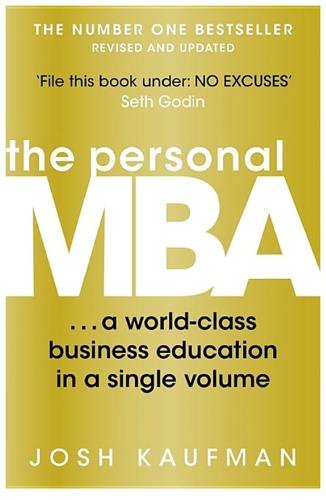
The Personal MBA: A World-Class Business Education in a Single Volume
by
Josh Kaufman
Published 2 Feb 2011
—WARREN BUFFETT, CHAIRMAN AND CEO OF BERKSHIRE HATHAWAY AND ONE OF THE WEALTHIEST INDIVIDUALS IN THE WORLD Finance, in the meantime, was steadily increasing in complexity. Before the twentieth century, accounting and finance were a matter of common sense and relatively simple arithmetic. The widespread adoption of double-entry bookkeeping (a thirteenth-century innovation) brought many benefits, like increased accuracy and ease of detecting anomalies like theft, at the cost of simplicity. The introduction of statistics to financial practice simultaneously enhanced analytical capability at the cost of abstraction, increasing opportunities to fudge the numbers without anyone noticing.

Blockchain Revolution: How the Technology Behind Bitcoin Is Changing Money, Business, and the World
by
Don Tapscott
and
Alex Tapscott
Published 9 May 2016
So the blockchain is a distributed ledger representing a network consensus of every transaction that has ever occurred. Like the World Wide Web of information, it’s the World Wide Ledger of value—a distributed ledger that everyone can download and run on their personal computer. Some scholars have argued that the invention of double-entry bookkeeping enabled the rise of capitalism and the nation-state. This new digital ledger of economic transactions can be programmed to record virtually everything of value and importance to humankind: birth and death certificates, marriage licenses, deeds and titles of ownership, educational degrees, financial accounts, medical procedures, insurance claims, votes, provenance of food, and anything else that can be expressed in code.
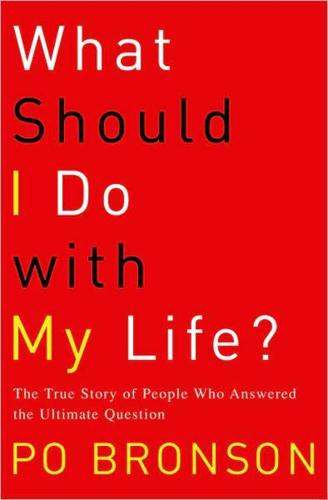
What Should I Do With My Life?
by
Po Bronson
Published 2 Jan 2001
He was surrounded by “fat ugly women” who had made the school district their life, and there was a woman down the hall who was very upset that Mark wasn’t “getting it.” She was making his life hell. “How long have you been there?” I asked. “A few months. I was hired to handle their finance. I thought it would mean managing their investment portfolio. Turns out they needed a clerk to handle accounting on a prehistoric non-double-entry bookkeeping system. It sucks. I’m making twenty percent of what I was earning just two years ago. I can’t believe how badly I screwed up.” “You’re living your brother’s life,” I said. “Except for the wife and kids and house part.” “Are you still with that woman I met?” He laughed, like No way. “Nicole?

City: A Guidebook for the Urban Age
by
P. D. Smith
Published 19 Jun 2012
Credit transactions became common, as did international banking, with many monarchs – and even entire cities, such as Venice – borrowing money. At the same time, domestic banking grew as people began depositing money, first in Genoa and then in Florence, Barcelona and Bruges. By the early fourteenth century, Florence had eighty banks. The Italians pioneered the bill of exchange, shipping insurance and double-entry book-keeping. According to Niall Ferguson, ‘banks and the bond market provided the material basis for the splendours of the Italian Renaissance’.15 By the seventeenth century, the dynamic commercial city of Amsterdam was the capital of banking and finance in Europe. London and Paris took over this role in the industrial age, with the City of London becoming increasingly dominant.

Dr. Johnson's London: Coffee-Houses and Climbing Boys, Medicine, Toothpaste and Gin, Poverty and Press-Gangs, Freakshows and Female Education
by
Liza Picard
Published 1 Jan 2000
At two o’clock they went to the Exchange for an hour or so until it shut at 3 o’clock. At three or four o’clock they went to ‘lounge a little longer at the coffee house and then dine about four … dinner concluded the day, they give the rest of it to their friends’.8 M. Grosley was struck by English commercial methods. Although double-entry bookkeeping was now widely used, the record most relied on by a merchant was a ‘debt-book which [he] carries always in his pocket’, so he could carry on his business on the hoof, in coffeehouses or the Royal Exchange, which must have been an astonishing sight. It was open between one and three every day, not only to English merchants, but also to foreigners from as far away as Japan and Moscow.9 Each trade had its own spot, called a ‘walk’, in the courtyard, some under the arcades and some, including the stockbrokers, in the open space10 – no wonder they migrated to coffeehouses.
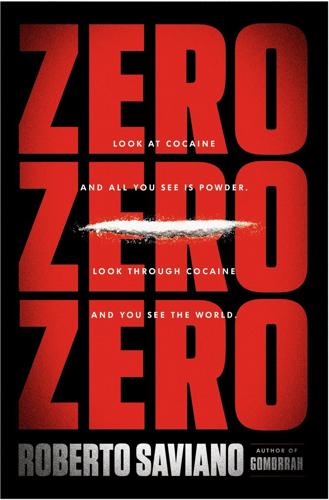
ZeroZeroZero
by
Roberto Saviano
Published 4 Apr 2013
He’s just been hired as a senior money-laundering reporting officer in the bank’s London office. Punctilious and precise, maniacal about order. Just the right person for a bank aiming to adhere scrupulously to the new money-laundering protocols. But Martin isn’t merely a zealous employee who is good with numbers and loves double-entry bookkeeping. He is a former agent of the National Crime Squad. This gives him a huge advantage over his banking peers around the world: Martin understands people. He knows how to talk with them, how to read their gestures, how to weigh the nuances of their moods. Money is just one of the many variables, just one of the many color gradations, on his personal grid for evaluating people.
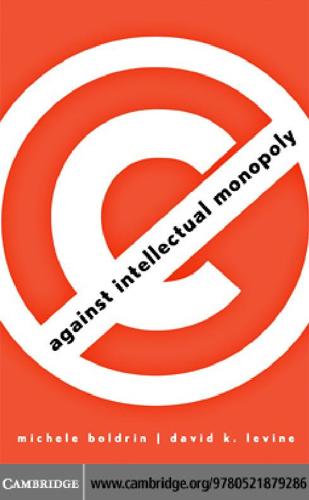
Against Intellectual Monopoly
by
Michele Boldrin
and
David K. Levine
Published 6 Jul 2008
Instead they were brought to Lubeck, from there to Hamburg, and finally to France, where Colbert was determined to start an iron industry on the Swedish model.21 P1: KNP head margin: 1/2 gutter margin: 7/8 CUUS245-07 cuus245 978 0 521 87928 6 May 21, 2008 16:55 166 Against Intellectual Monopoly Yet another example of the slow spread of knowledge is the use of double-entry bookkeeping. This was invented in Italy at the end of the fourteenth century, and widely used in Venice in the fifteenth century. It did not reach the Hanseatic League cities in northern Europe until well into the sixteenth century. However, one does not have to turn to the Middle Ages to find examples of the difficulty in transferring ideas.
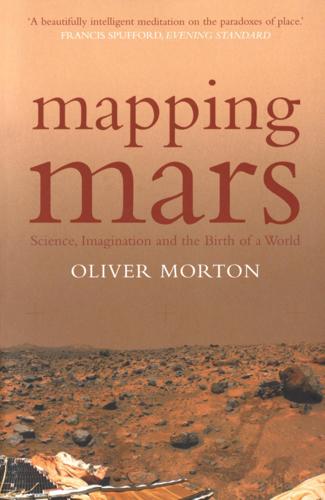
Mapping Mars: Science, Imagination and the Birth of a World
by
Oliver Morton
Published 15 Feb 2003
Airy’s transit circle came to define the world. Airy was, by all accounts, an uninspiring but meticulous man. He recorded his every thought and expenditure from the day he went up to Cambridge University to more or less the day he died, throwing no note away, delighting in doing his own double-entry book-keeping. He applied a similar thoroughness to his stewardship over the Royal Greenwich Observatory, bringing to its workings little interest in theory or discovery but a profound concern for order, which meant that the production of tables for the Admiralty (the core of the observatory’s job) was accomplished with mechanical accuracy.
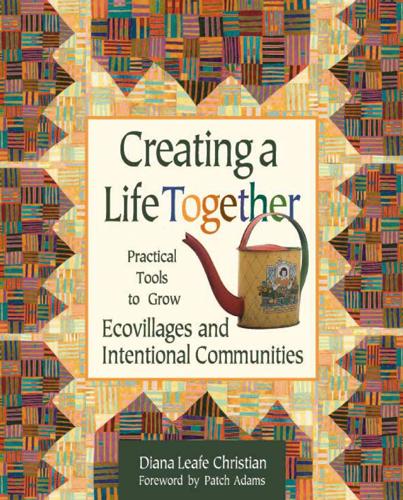
Creating a Life Together: Practical Tools to Grow Ecovillages and Intentional Communities
by
Diana Leafe Christian
Published 1 Jan 2003
Like all corporations, a 501(c)3 requires ongoing record-keeping. This begins with the filing of the initial documents with the state, and continues with an annual report of activities and other mandatory forms. IRS requirements can also be intimidating. You must keep meticulous financial records with double-entry bookkeeping to prove that your 501(c)3 continues to deserve its tax-exempt status, prepare annual non-profit IF YOU’RE USING A TAX-EXEMPT NON-PROFIT informational tax returns, and, if it has employees, deal with payroll tax withholding and reporting. Often the idealists who want to set up 501(c)3s are unfamiliar with these business procedures, but if they fail to do these things the IRS can freeze their bank account and bring all their non-profit activities to a halt.
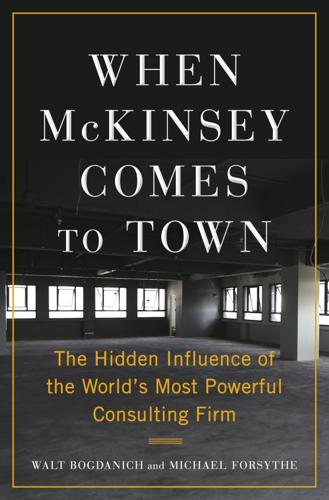
When McKinsey Comes to Town: The Hidden Influence of the World's Most Powerful Consulting Firm
by
Walt Bogdanich
and
Michael Forsythe
Published 3 Oct 2022
“We can’t just be a Firm of takers and appliers,” he told his fellow directors in Vienna in 1980. “More of us must be givers and creators of new thinking and new ideas.” Lowell Bryan thought he had a solution, an idea so big that in the annals of financial history it ranked right up with the invention of double-entry bookkeeping in fifteenth-century Venice. If McKinsey could own this new idea—he called it a “technology”—banks all over the world would be clamoring to hire the firm. Bryan’s big idea: the securitization of credit. While he did not invent securitization, he became one of its biggest, most visible promoters.

The Medical Detectives
by
Berton Roueche
Published 1 Jan 1980
The fog of amnesia increased as I came forward in time. The events of the past several years were the blurriest and the blankest. Another area that didn't seem to be affected was ingrained habits—repetitive acts and procedures. I mean, I hadn't lost my command of the English language, I still knew the multiplication tables, I could still do double-entry bookkeeping. And then there was an area that I call emotional. I could still remember experiences from any period of my life that had had a big emotional impact. Good and bad. I could remember pains and hurts. And I could also remember a trip we took to Spain only a few years ago. A wonderful trip. "But the worst of all my problems was that I couldn't seem to retain.

The Shifts and the Shocks: What We've Learned--And Have Still to Learn--From the Financial Crisis
by
Martin Wolf
Published 24 Nov 2015
Moreover, banks automatically create money as a by-product of their normal lending (a point explained in full in Chapter Six below). That is a fundamental characteristic of banks. When they lend, they create a debt from their client to the bank and, simultaneously, a debt from the bank to the client. This is just double-entry bookkeeping. A debt from a bank to a client is a deposit and a deposit is money. So the growth of the stock of money in the hands of the public declines when the growth of bank lending falls. The fourth reason why post-crisis economies are weak is that inflation may become too low or, worse, deflation may set in.
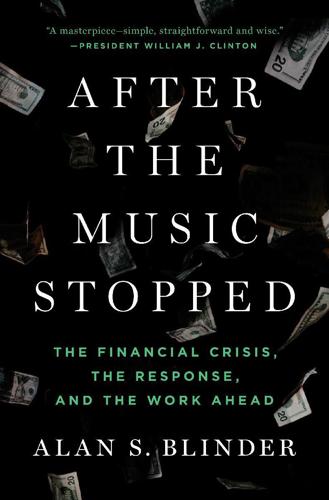
After the Music Stopped: The Financial Crisis, the Response, and the Work Ahead
by
Alan S. Blinder
Published 24 Jan 2013
Hope Now focused on outreach, counseling, and encouraging delinquent borrowers to talk to their mortgage servicers about ways to become current again. It was more about minimizing lenders’ prospective losses than about reducing homeowners’ financial burdens. Such a tilt is hardly surprising in a voluntary, industry-led effort. After all, any mortgage modification that reduces homeowners’ payments must, by the inexorable laws of double-entry bookkeeping, also reduce lenders’ receipts. For that simple reason, as Paulson’s aide Phill Swagel put it, “avoiding more foreclosures required someone—either the government or lenders—to write a check.” No one should expect lenders to volunteer for that honor with enthusiasm. Nonetheless, by now many of the mortgages modified voluntarily have reduced principal, interest payments, or both—and the program continues.
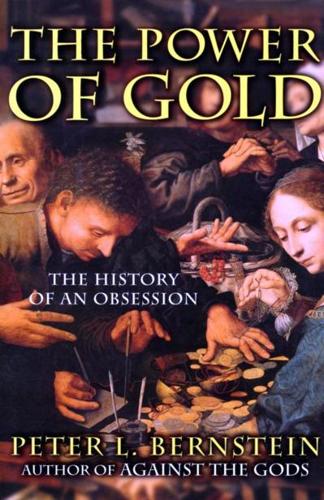
The Power of Gold: The History of an Obsession
by
Peter L. Bernstein
Published 1 Jan 2000
Leonardo, Tintoretto, Raphael, Palladio, Cellini, Michelangelo, Titian, Diirer, Cervantes, and El Greco were all active during the 1500s. The great cathedral of Saint Peter's rose up on the banks of the Tiber, well splashed with gold in its interior. Copernicus and Galileo were exploring the solar system, while businessmen for the first time took the giant step of using double-entry bookkeeping.22 This was also a period when Latin was being replaced by vernacular languages, which facilitated communication among the great mass of individuals, including some very rich ones, who had neither been to universities nor joined the clergy. The single most important event of the century occurred in 1517 when Martin Luther posted his 95 theses on the door of the church in Wittenberg.
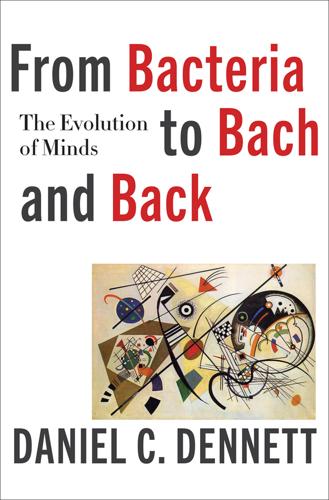
From Bacteria to Bach and Back: The Evolution of Minds
by
Daniel C. Dennett
Published 7 Feb 2017
(The brains of domesticated animals are always smaller than the brains of their nearest wild kin; use it or lose it, and domesticated animals have a relatively unchallenging life, being protected from predators and starvation, and provided with mates at procreation time.) The corollary of this, of course, is that for something boring to spread, it has to be deemed by its hosts to be particularly useful, or particularly valuable, and hence worth breeding: inculcating via extensive training. Double-entry bookkeeping and trigonometry come to mind. Being-deemed-valuable-by-influential-hosts is itself a frequent adaptation among memes, and among the more extreme examples are soporific atonal “serious” music and some lineages of contemporary conceptual art that—like laying hens—are so domesticated that they would go extinct in a generation without the assistance of their well-heeled stewards.
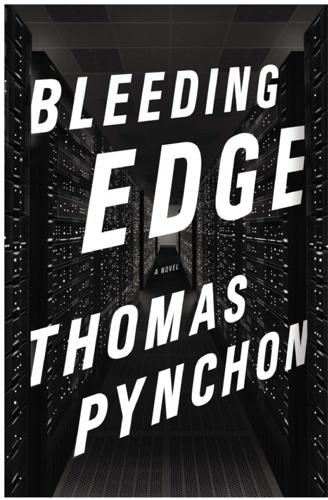
Bleeding Edge: A Novel
by
Thomas Pynchon
Published 16 Sep 2013
Fast zoom in on Vip’s face, with a look of undisguisable yearning, which he quickly tries to reset to standard party mode. Gusts of laughter from topside. Bruno’s hand comes into the shot with a butane lighter and a crack pipe, and the threesome now become affectionate. Jules and Jim (1962) it isn’t. Talk about double-entry bookkeeping! As erotic material, there are shortcomings, to be sure. Boy and girl quality could do with an upgrade, Shae is a jolly enough girl, maybe a little vacant around the eyes, Vip is years overdue for some gym time, and Bruno comes across as a horny little runt with a tendency to shriek and a dick, frankly, not big enough for the scenario, provoking expressions of annoyance from Shae and Vip whenever it approaches them for any purpose.

Animal Spirits: The American Pursuit of Vitality From Camp Meeting to Wall Street
by
Jackson Lears
Finance capital, trading in invisible assets, was a faith-based enterprise; fortunes were made and lost on the basis of fantasy, rumor, and fear. Centuries before Keynes was born, speculative capitalists were demonstrating the accuracy of his insight. To be sure, there were other sorts of capitalists at work in the early modern world as well, notably the sort devoted to calculation, efficiency, double-entry bookkeeping, and disciplined achievement as a way of life—Weber’s ideal type of early modern man, whose Protestant ethic was turning into a spirit of capitalism. Some finance capitalists undoubtedly resembled the Weberian type in certain ways, but many cultivated a more emotionally charged ethos, one more attuned to the fluctuations of the emerging business cycle.
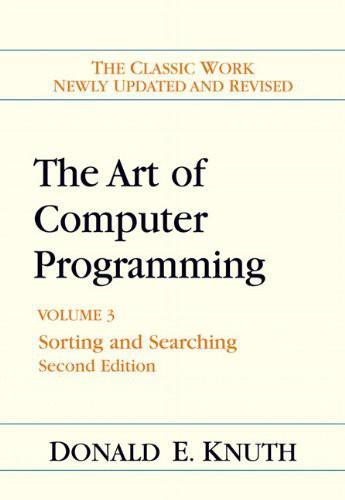
The Art of Computer Programming: Sorting and Searching
by
Donald Ervin Knuth
Published 15 Jan 1998
Instead of listing the attributes of a given record, we list the records having a given attribute. 6.5 RETRIEVAL ON SECONDARY KEYS 561 We encounter inverted files (under other names) quite often in our daily lives. For example, the inverted file corresponding to a Russian-English dictionary is an English-Russian dictionary. The inverted file corresponding to this book is the index that appears at the close of the book. Accountants traditionally use "double-entry bookkeeping," where all transactions are entered both in a cash account and in a customer account, so that the current cash position and the current customer liability are both readily accessible. In general, an inverted file usually doesn't stand by itself; it is to be used together with the original uninverted file.
…
Divide and conquer, 175. recurrence, 168, 224, 674. 762 INDEX AND GLOSSARY Divisor function d(n), 138. Dixon, John Douglas, 611. DNA, 34, 72. Dobkin, David Paul, 583. Dobosiewicz, Wiodzimierz, 176, 266, 628, 680. Dodd, Marisue, 520. Dodgson, Charles Lutwidge, 207, see Carroll. Dor, Dorit ("in Jinn), 664. Doren, David Gerald, 212, 218. Dot product, 406. Double-entry bookkeeping, 561. Double hashing, 528-533, 546, 548, 551-552, 556, 557, 742. Double rotation, 461, 464, 477. Doubly exponential sequences, 467, 715. Doubly linked list, 393, 375, 543, 646, 713. Douglas, Alexander Shafto, 98, 388, 396. Dowd, Martin John, 673. Drake, Paul, 1. Driscoll, James Robert, 152, 583.

The Relentless Revolution: A History of Capitalism
by
Joyce Appleby
Published 22 Dec 2009
Many mechanical devices and institutional procedures became useful to entrepreneurs without themselves being causes of the emergence of capitalism. The invention of movable type made printing cheaper, promoting a book trade that carried news of explorations throughout Europe. The Greek astrolabe and compass proved a great aid to navigating the waters of three oceans. Italian double-entry bookkeeping enabled merchants to keep better track of their profits. All these improvements contributed to industrial enterprise, but they didn’t cause capitalism to appear; they were propitious factors in its development. Capitalism required a different social dynamic and innovations that changed how food was grown and goods produced.

The omnivore's dilemma: a natural history of four meals
by
Michael Pollan
Published 15 Dec 2006
Indeed, there is every reason to believe that corn has succeeded in domesticating us. To some extent this holds true for all of the plants and animals that take part in the grand coevolutionary bargain with humans we call agriculture. Though we insist on speaking of the "invention" of agriculture as if it were our idea, like double-entry bookkeeping or the lightbulb, in fact it makes just as much sense to regard agriculture as a brilliant (if unconscious) evolutionary strategy on the part of the plants and animals involved to get us to advance their interests. By evolving certain traits we happen to regard as desirable, these species got themselves noticed by the one mammal in a position not only to spread their 2 4 * THE OMNIVORE'S DILEMMA genes around the world, but to remake vast swathes of that world in the image of the plants' preferred habitat.
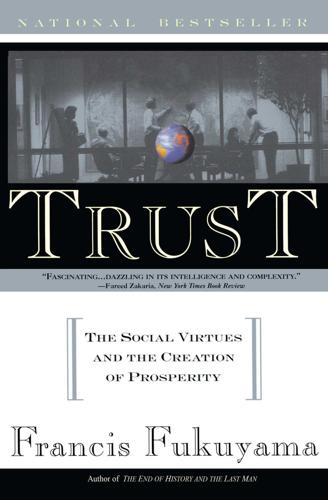
Trust: The Social Virtue and the Creation of Prosperity
by
Francis Fukuyama
Published 1 Jan 1995
The economic historians Nathan Rosenberg and L. E. Birdzell note that in the early capitalist period (from the late fifteenth century on) people had to outgrow firms based on kinship and separate their personal finances from their firm’s finances. In this respect, a technical innovation like double-entry bookkeeping was indispensable. But technical advances were not, in themselves, enough: The need for a form of enterprise which could command trust and loyalty on some basis other than kinship was only one facet of a broader need: the rising world of trade needed a moral system. It needed a morality to support reliance on its complex apparatus of representation and promise: credit, representations as to quality, promises to deliver goods, or to buy goods in the future, and agreements to share in the proceeds of voyages.
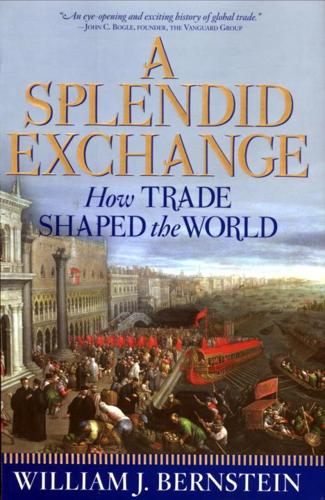
A Splendid Exchange: How Trade Shaped the World
by
William J. Bernstein
Published 5 May 2009
Among the members of that party was a young "junior merchant" whose name later became synonymous with Dutch efficiency and brutality: Jan Pieterszoon Coen. Before embarking for the Indies, he had spent his teenage years as an apprentice to a branch of a Dutch merchant company in Rome, where he learned the new science of double-entry bookkeeping, which was not yet in widespread use in Holland. Coen shipped out in 1607 to the East Indies for three years (during which he served on the unsuccessful Lonthor rescue party). He then returned to Holland for two years. In 1612 he was sent out again as a "senior merchant." In this capacity Coen submitted a brilliant analysis, based on the new bookkeeping techniques, of the VOC's operations, Discoers Touscherende den Nederlantsche Indischen Staet, which soon caught the attention of the Heeren XVII.
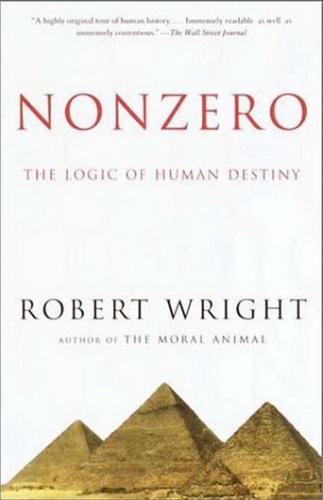
The Moral Animal: Evolutionary Psychology and Everyday Life
by
Robert Wright
Published 1 Jan 1994
The rest is European banking history.) All such instruments had this in common: they were distinct steps toward modern capitalism. Europe had long had markets for goods and services. Now it had markets for capital. It also had new ancillary metatechnologies of capitalism, such as insurance and double-entry bookkeeping. All to the good. But does this really answer the question of why the economic complexity of the late Middle Ages had been so slow in coming? If the missing ingredients were the various metatechnologies of capitalism, then the question becomes: Why had they taken so long to evolve? After all, once you’ve got coins and writing, all that stands between you and capitalism is a little imagination.
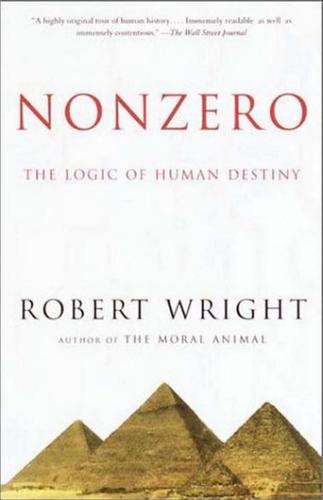
Nonzero: The Logic of Human Destiny
by
Robert Wright
Published 28 Dec 2010
The rest is European banking history.) All such instruments had this in common: they were distinct steps toward modern capitalism. Europe had long had markets for goods and services. Now it had markets for capital. It also had new ancillary metatechnologies of capitalism, such as insurance and double-entry bookkeeping. All to the good. But does this really answer the question of why the economic complexity of the late Middle Ages had been so slow in coming? If the missing ingredients were the various metatechnologies of capitalism, then the question becomes: Why had they taken so long to evolve? After all, once you’ve got coins and writing, all that stands between you and capitalism is a little imagination.
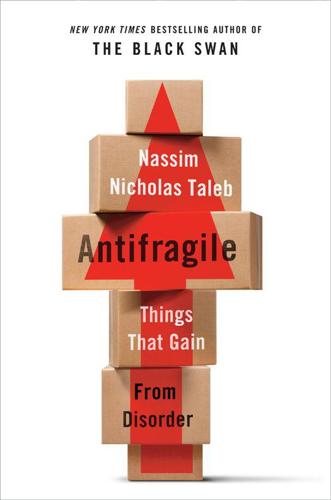
Antifragile: Things That Gain From Disorder
by
Nassim Nicholas Taleb
Published 27 Nov 2012
(This is not strictly true, the ancients were also obsessed with measurements, but they did not have the Arabic numerals to do proper calculations.) His idea was that we learned to be precise about things—and that was the precursor of the scientific revolution. He cites the first mechanical clock (which quantized time), marine charts and perspective painting (which quantized space), and double-entry bookkeeping (which quantized financial accounts). The obsession with measurement started with the right places, and progressively invaded the wrong ones. Now our problem is that such measurement started to be applied to elements that have a high measurement error—in some case infinitely high. (Recall Fukushima in the previous section.)
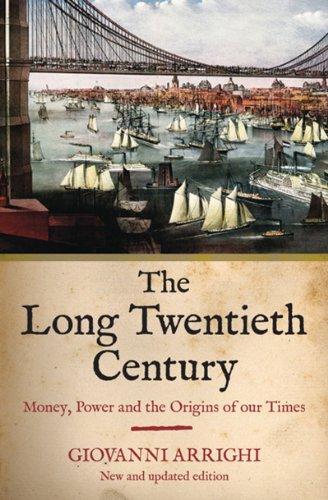
The Long Twentieth Century: Money, Power, and the Origins of Our Times
by
Giovanni Arrighi
Published 15 Mar 2010
The exclusiveness of capitalist interests in the organization and management 48 THE LONG TWENTIETH CENTURY of the Venetian state was the main source of its power but was also the main limit of that power. For this exclusiveness kept the political horizon of the Venetian oligarchy within the limits set by cost—benefit analysis and double-entry bookkeeping. That is to say, it kept Venetian rulers aloof from the political and social issues that were tearing apart the world within which they operated. The state-making capabilities of the Dutch capitalist oligarchy, in contrast, had been forged in a long struggle of emancipation from Spanish imperial rule.
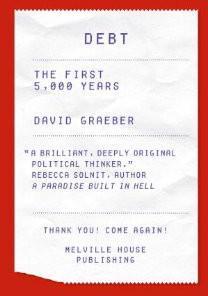
Debt: The First 5,000 Years
by
David Graeber
Published 1 Jan 2010
The French historian Maurice Lombard draws a striking, if perhaps rather idealized, picture of him “in his stately town-house, surrounded by slaves and hangers-on, in the midst of his collections of books, travel souvenirs, and rare ornaments,” along with his ledgers, correspondence, and letters of credit, skilled in the arts of double-entry book-keeping along with secret codes and ciphers, giving alms to the poor, supporting places of worship, perhaps, dedicating himself to the writing of poetry, while still able to translate his general creditworthiness into great capital reserves by appealing to family and partners.79 Lombard’s picture is to some degree inspired by the famous Thousand and One Nights description of Sindbad, who, having spent his youth in perilous mercantile ventures to faraway lands, finally retired, rich beyond dreams, to spend the rest of his life amidst gardens and dancing girls, telling tall tales of his adventures.
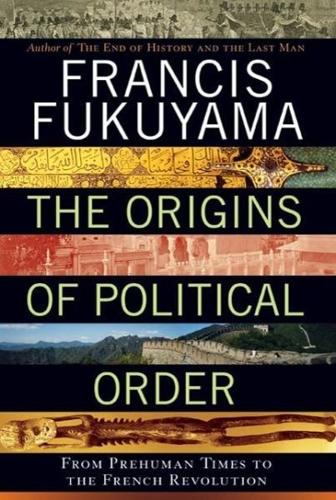
The Origins of Political Order: From Prehuman Times to the French Revolution
by
Francis Fukuyama
Published 11 Apr 2011
FIGURE 7 The reasons for the massive increase in post-1800 productivity have always been at the core of studies of growth. They have to do with changes in the intellectual environment that promoted the emergence of modern natural science, the application of science and technology to production, development of techniques like double-entry bookkeeping, and supportive microeconomic institutions like patent law and copyright that permitted and encouraged continuous innovation.6 7 But the understandable focus on developments of the last two hundred or so years has obscured our ability to comprehend the nature of political economy in premodern societies.
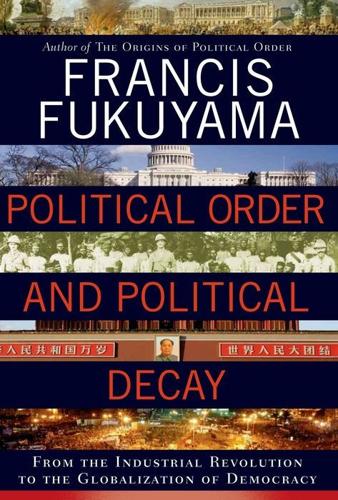
Political Order and Political Decay: From the Industrial Revolution to the Globalization of Democracy
by
Francis Fukuyama
Published 29 Sep 2014
The Industrial Revolution had been preceded by a commercial revolution starting in the sixteenth century that vastly expanded the volume of trade both within Europe and across the Atlantic. This expansion, in turn, was driven by a host of political and institutional factors: the establishment of secure property rights, the rise of modern states, the invention of double-entry bookkeeping and the modern corporation, and new technologies of communications and transportation. The Industrial Revolution in turn rested on the systematic application of the scientific method and its incorporation into an institutional structure of universities and research organizations, which could then be translated into technological innovations.4 FIGURE 2.
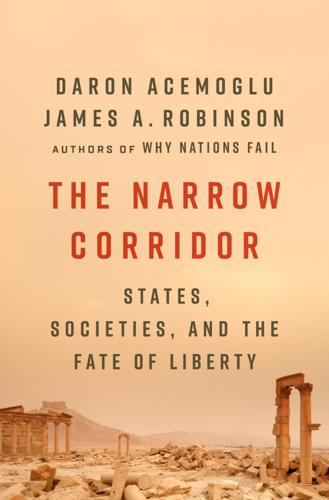
The Narrow Corridor: States, Societies, and the Fate of Liberty
by
Daron Acemoglu
and
James A. Robinson
Published 23 Sep 2019
All of this trade needed advanced accounting practices. It’s not a coincidence that it was an Italian from Pisa, Leonardo Fibonacci, who revolutionized accounting by adapting the Arabic numerical system in 1202. This made financial calculations much more straightforward. By the middle of the fourteenth century, double-entry bookkeeping appeared in Italy for the first time. The commercial revolution went along with a great deal of economic growth and stimulated innovation outside the financial sector too. Though we don’t have enough evidence to construct national income accounts for this period of history, we can proxy economic development by the extent of urbanization—the fraction of the population living in cities of at least 5,000 people.

Europe: A History
by
Norman Davies
Published 1 Jan 1996
Pacioli (1447–1517), otherwise known by his religious name of Fra Luca di Borgo San Sepolcro, was a Franciscan friar and a prominent itinerant Florentine professor. His best-known treatise, De Divina Proportione (1509), was illustrated by Leonardo da Vinci. Recent authors have dubbed him the ‘Father of Accountancy’.1 The ‘Venetian method’ of double-entry book-keeping had grown up in the Italian cities some considerable time before Pacioli described it. It required three books—a memorial book, a journal, and a ledger. The memorial received a note of all transactions as they were made. The journal was made up from the memorial and summarised each day’s business in chronological order.
…
Starkie, The Road to Santiago: pilgrims of St James (London, 1957); H. Davies, Holy days and holidays: the mediaeval pilgrimage to Compostela (Lewisburg, PA, 1982); also James Bentley, The Way of St James: a pilgrimage to Santiago de Compostela (London, 1992). COMPUTATIO 1. See J. B. Geisbeek, Ancient Double-Entry Book-Keeping: Lucas Pacioli’s Treatise (Denver, 1914; repr. Osaka, 1975); also R. G. Brown and K. S. Johnston, Padoli on Accounting (New York, 1963). 2. See P. L. McMickle and R. G. Vanger-meersch, The Origins of a Great Profession: Catalogue to an Exhibition of Rare Accounting Books and Manuscripts from the Montgomery Collection (Memphis, 1987). 3.
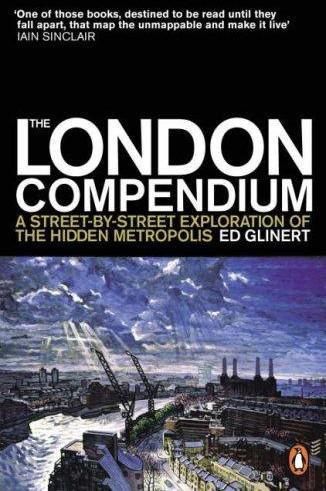
The London Compendium
by
Ed Glinert
Published 30 Jun 2004
Lombard Street Once the Jews, the City’s moneylenders, had been expelled from England in 1290, Venetians and Lombardians, who had first arrived in London during the mid-thirteenth-century reign of Henry III to collect taxes due to the Pope, took up the same role, later introducing into England double-entry book-keeping, doppia scrittura, which had been invented by a fifteenth-century Italian monk. The Lombardians’ power base was challenged by the opening of the first Exchange in 1565. They responded by increasing their banking rates, which failed to win back custom. In 1692 Lloyd’s Insurance moved from (Great) Tower Street to Lombard Street, and began publishing Lloyd’s News, the forerunner of Lloyd’s List and Shipping Gazette, here four years later.

Ashes to Ashes: America's Hundred-Year Cigarette War, the Public Health, and the Unabashed Triumph of Philip Morris
by
Richard Kluger
Published 1 Jan 1996
Sent with his siblings to a Quaker academy for some formal learning, the big boy found the Latin, poetry, and much else in the curriculum lacking in any vocational relevance and after a couple of months came squawking home. A stay at a business school in Poughkeepsie, New York, better suited to his aptitudes, allowed Buck to master double-entry bookkeeping and other practical skills. Back home again, he applied his fresh tools to the Duke factory books and by sundown each day knew to the penny how their operations were faring. Wash Duke knew an unpolished gem when he saw one and made Buck, just eighteen, his full partner in the business. The three-story, false-front Duke establishment with its little bell tower had become a Durham fixture by now, and under Buck it grew into a well-run, steadily expanding business, but always well within the shadow of the mighty Durham Bull, which was spreading the town name across America and overseas.